Mount Manaslu, is the world’s eighth-highest mountain, reaching a remarkable height of 8,163m. Located in west-central Nepal, this mighty peak in the Himalayas is well-known as the introductory 8000m peak among the fourteen throughout the world. Manaslu is an excellent training climb for aspiring Everest climbers to see how they handle being above 8000m, in the death zone.
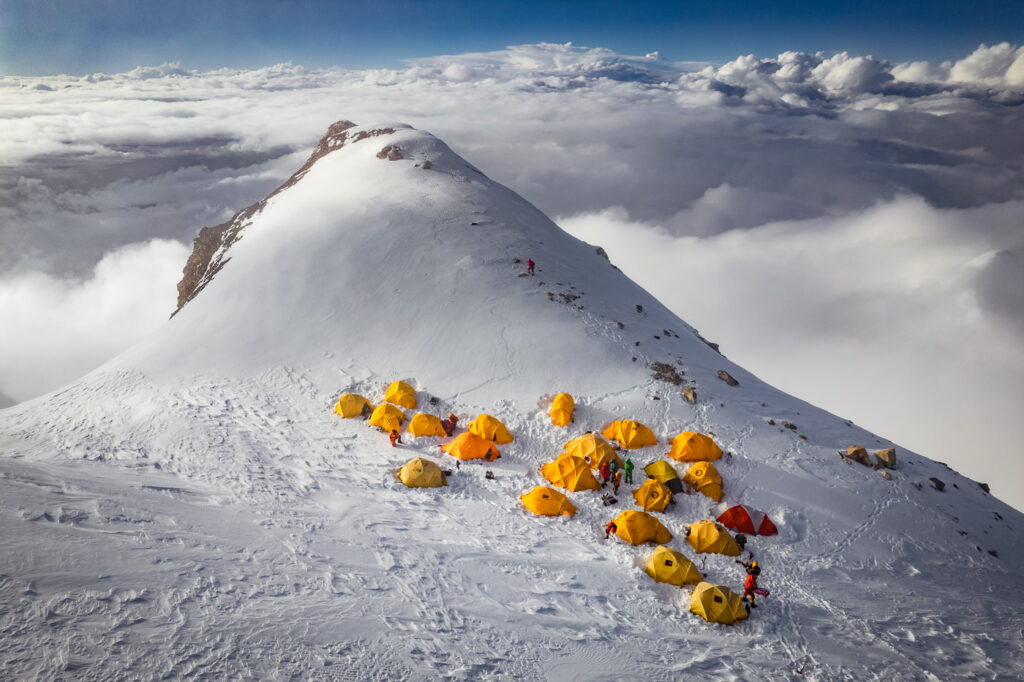
In this blog post, I will cover everything you need to know about the logistics of climbing Manaslu Mountain and also share with you my stories and photos from the climb. This will give you an idea of what to expect and a great insight into the scenery you will find at each camp en route to the summit. Before sharing my experience of the climb in the second section of this blog post, I will detail all of the information you need to know in this complete guide about climbing Manaslu Mountain.
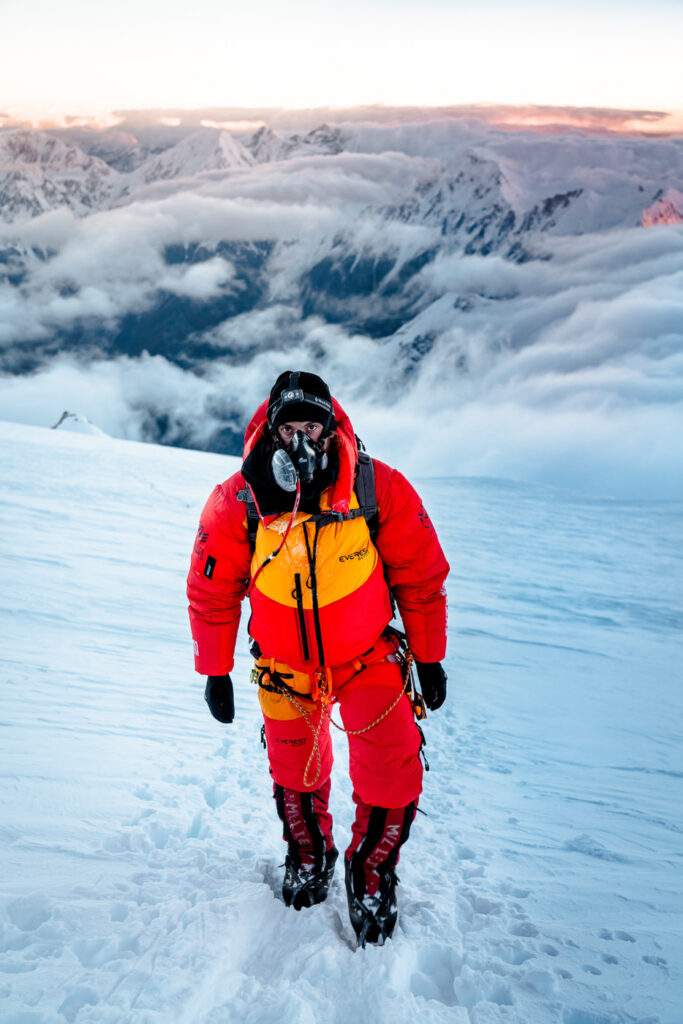
TRY THE 3 BEST TREKS IN NEPAL
Manaslu Circuit: My personal favorite 2-week trek through Tibetan villages and stunning scenery with less crowds.
Annapurna Circuit: The most beautiful & scenic 2-week trek in Nepal although can be crowded at times.
Everest Base Camp Trek: The most iconic 2-week route reaching the famous (EBC) Everest Base Camp at 5,300m.
MANASLU MOUNTAIN DETAILS
- Days required: 25-35 days
- Height of Manaslu Summit: 8,163m
- Cost: $13,000-$18,000
- Season to climb Manaslu: September to October
- Difficulty: Manaslu is known as one of the ‘easiest’ 8000m peaks among the fourteen. However, easy is a relative term. I did my first 7000m peak a month before Manaslu and it was my first time to use a jumar or even crampons to give you an idea of my prior experience. I found the Manaslu expedition to be within my physical ability and the technical aspects could be learnt along the way. This is because there were only a few technical sections, particularly between Camp 1 and Camp 2. Having been above 6000m and 7000m at least once or twice should be a prerequisite for Manaslu. I have spent three years trekking pretty relentlessly so I’m in good mountain shape. I made it to the summit of Mount Kilimanjaro (5,895m) and Spantik Peak (7,030m) in the year leading up to Manaslu, which gave me some basic high-altitude experience. It’s important to note that I summitted with Sherpa assistance and with the use of oxygen. If you remove either or both of those factors, this climb will not be quite as ‘easy’.
- Recommended prior climbs: While there are many climbs you can do to warm-up for Manaslu, some common options are Island Peak (6,189), Baruntse Peak (7,129m), Spantik Peak (7,030) and Himlung Himal (7,126m)
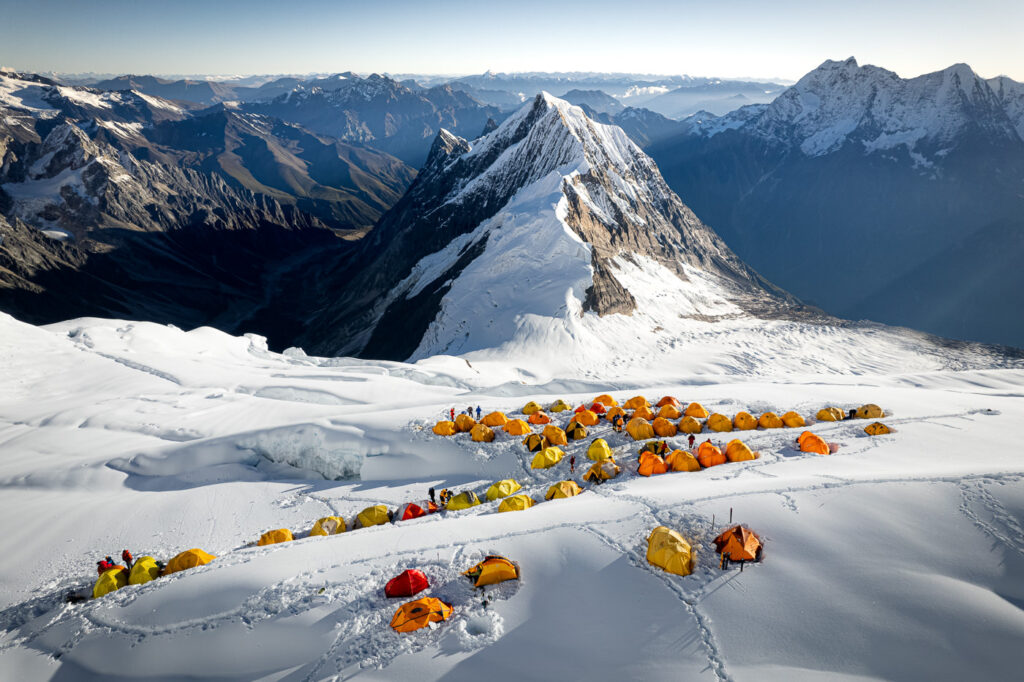
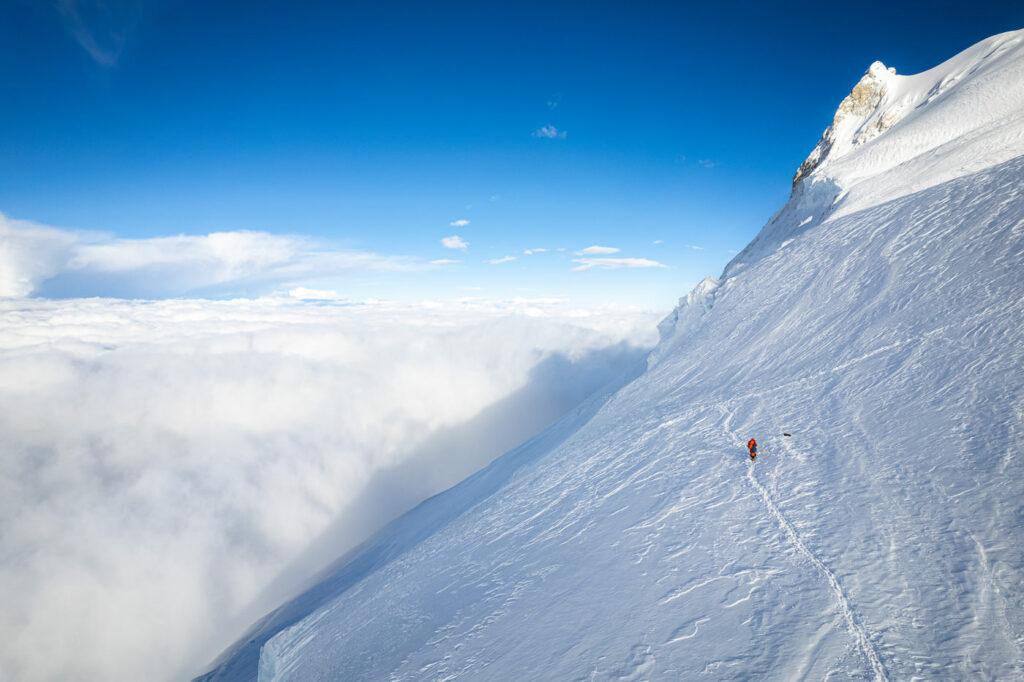
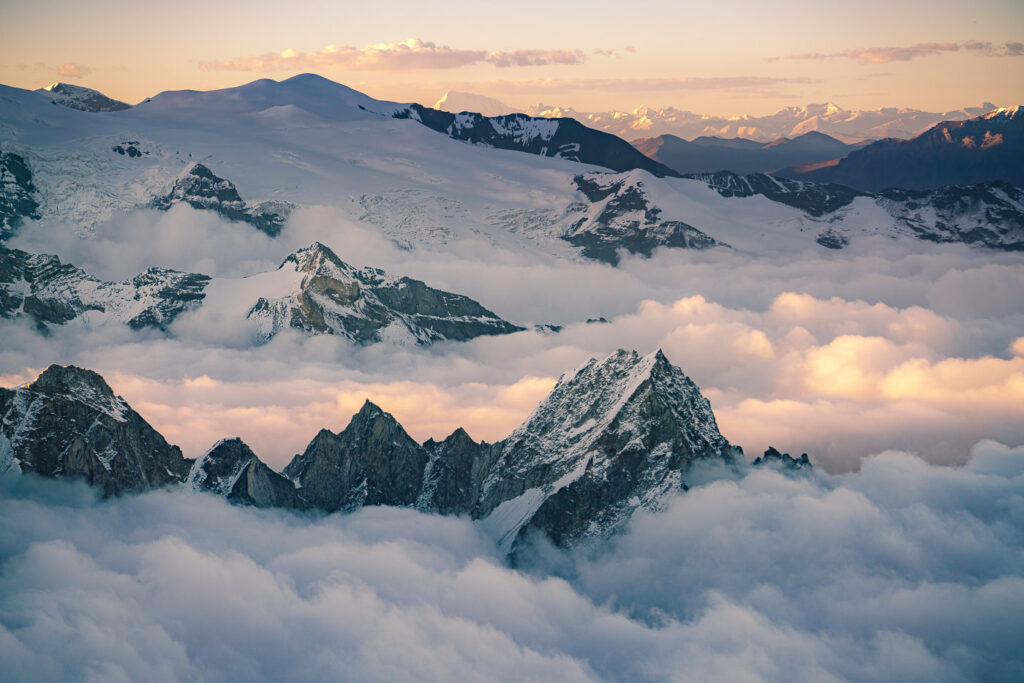
GETTING TO AND FROM MANASLU BASECAMP
There are several different options for how to arrive and depart from Manaslu Base Camp (4,800m). I’ve actually done all three of the routes because I trekked the nearby Manaslu Circuit earlier this year.
- Helicopter: These days many mountaineers can afford to fly into Samagaun via helicopter, which is the town beneath base camp. The flight runs directly from Kathmandu and you just need a day or two in the small Tibetan village of Samagaun to acclimatize before hiking up to base camp with about 1200m of incline. Most tour operators will organize this helicopter option as part of the package.
- Trekking in from Dharapani: One of the most scenic ways to reach base camp is to trek across the Larke Pass (5,160m) and to reach base camp with 4-5 days of trekking. This is actually the way I trekked out this year and it was a beautiful route with stunning lakes.
- Trekking in from Machhakholagaon: This is where the Manaslu Circuit Trek begins (at an elevation of 862m), which I did four months prior to climbing Manaslu. This trek can take anywhere from five to ten days to reach base camp, but will help you acclimatize slowly while taking in the surrounding villages and areas.
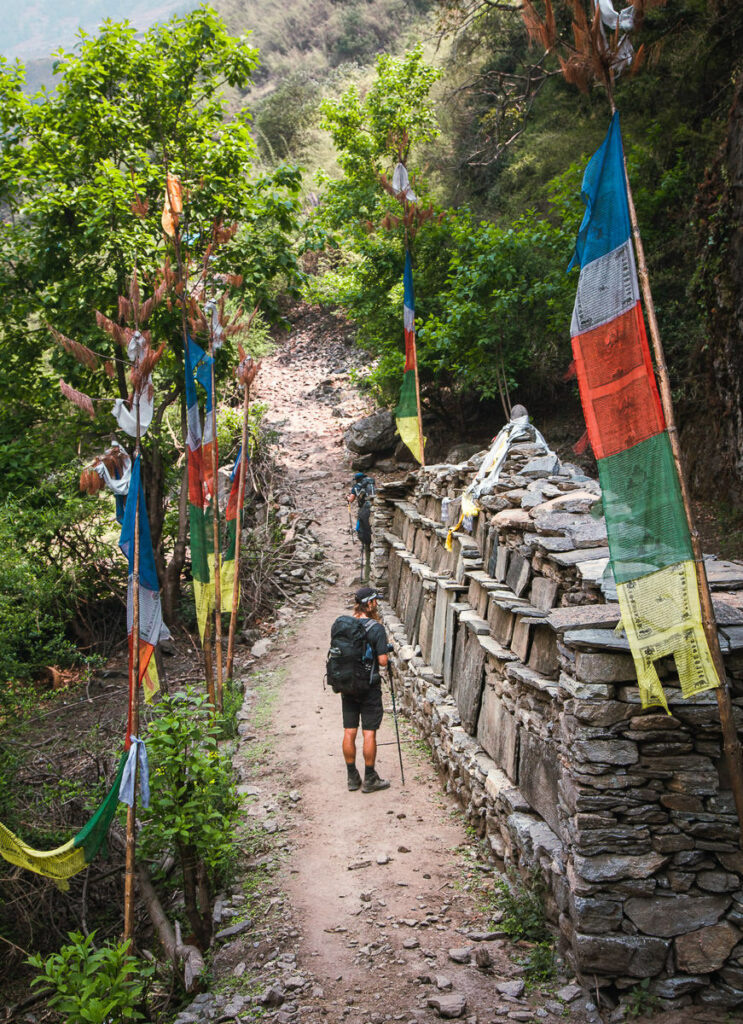
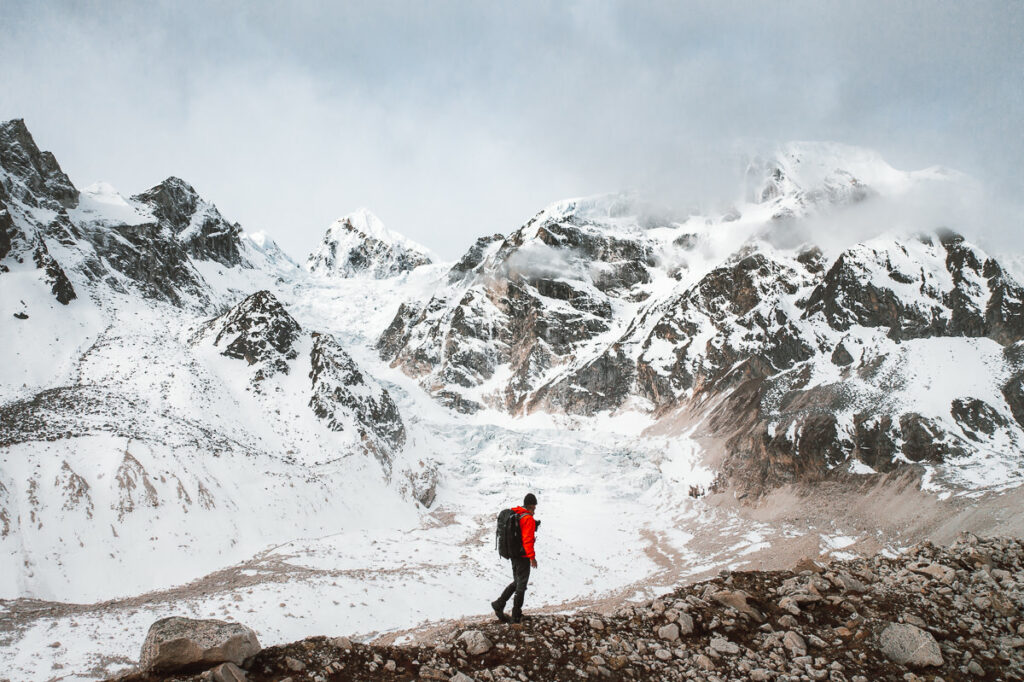
TOP 3 PLACES TO STAY IN KATHMANDU

- Ultimate Luxury: The Dwarika’s Hotel – Luxury, Spa-service, Pool
- Best Value: Aloft Kathmandu Thamel – Swimming Pool, Gym & Great Restuarant
- Budget Choice: Hotel Jampa is easily the top cheap hotel in Kathmandu
IS MANASLU MOUNTAIN DANGEROUS?
Whenever you climb to heights above 8000m, you are in the death zone. Lower oxygen, harsh weather conditions, unpredictable mountains, and tired bodies can often make for tragic circumstances. During our expedition of 2021, there was one death due to a heart attack but no major avalanches on the climbing route to cause problems.
Most deaths on Manaslu have historically been a result of avalanches, but falls and health-related altitude issues also contribute to the death toll. According to mountain databases as of 2018, Manaslu had 661 successful ascents with 65 deaths recorded, which gave it a death rate of 9.9%. This figure has dramatically improved in recent years with a new, safer route to Camp 1 established as well as better conditions, equipment, and logistics provided to climbers.
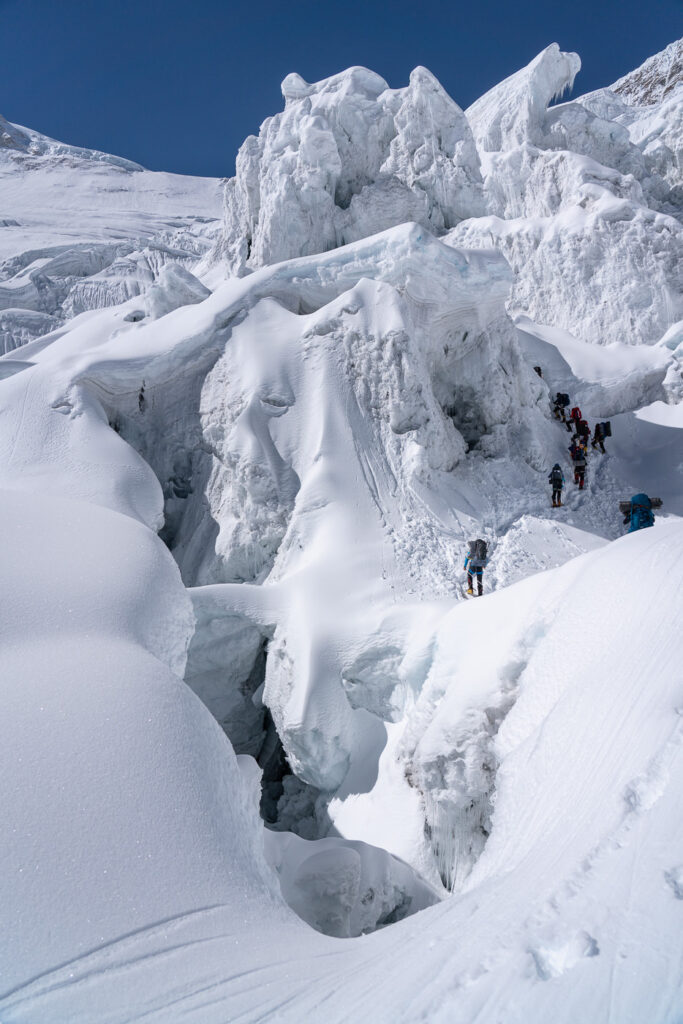
BEST NEPAL TREKKING COMPANY
Interested in trekking in Nepal or doing the Everest Base Camp Trek?
I recommend booking your trek with Himalayan Masters, which is the company I use for all of my treks in Nepal. Use my code JACKSON5 when you book to receive a 5% DISCOUNT.
MY EXPERIENCE CLIMBING MANASLU MOUNTAIN
It was four long months ago in May when I trekked the Manaslu Circuit. It took us seven days to reach the Tibetan town of Samagaun as we rose up along the trail from 900m to 3500m. At that time as I trekked along the circuit, I had no idea I would be back four months later to attempt to climb Manaslu with Elite Exped. It wasn’t something that really crossed my mind.
This time, there was no seven-day trek. We jumped in a helicopter at Kathmandu Airport and within an hour, we had touched down in the mountain town of Samagaun. I could spot each tea house I had stayed at as we cruised past in the helicopter. It was definitely the express route although much less immersive than the trek, which was one of my favorite adventures of the year.
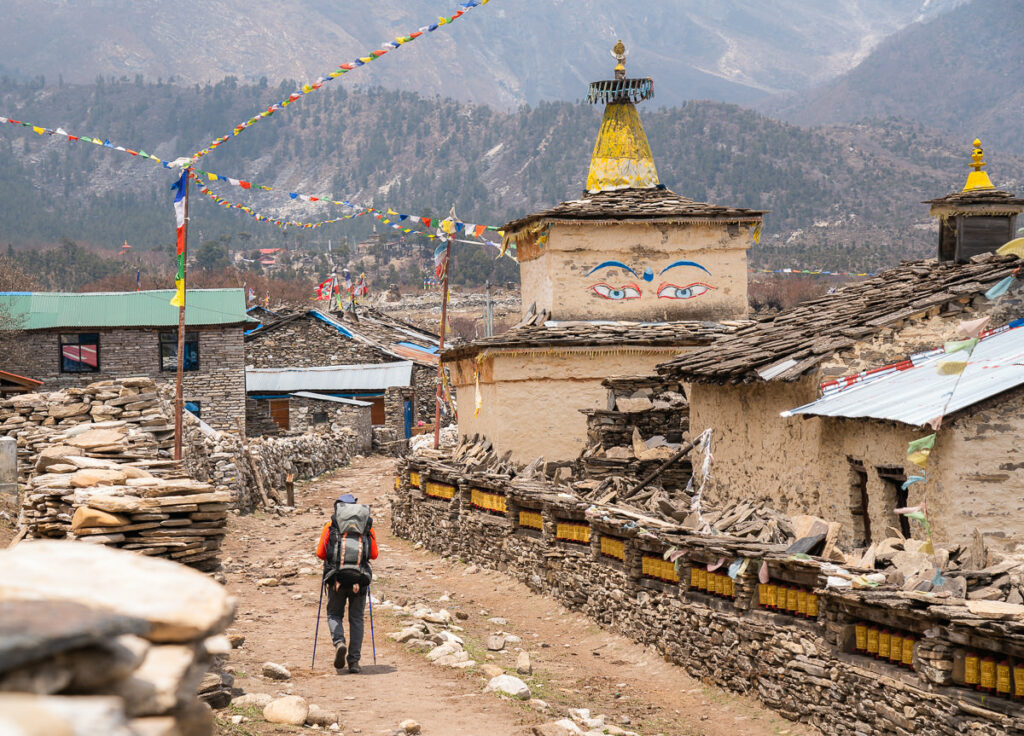
We now had three to four days scheduled in Samagaun to acclimatize as we had just jumped from about 1200m in Kathmandu to 3500m in less than an hour. Samagaun is a beautiful town with lots to explore nearby so a few days here taking it all in would be great.
Back in May while trekking I stayed at the Norling Hotel but this time switched accommodations to the Manaslu Guest House, which is situated directly across the road. The guest house was buzzing with mountaineers and the regular chat that comes with this crowd about routes, previous peaks, weather, gear, and whether or not to use oxygen.
There were a few small adventures during our time in Samagaun. The first was a short hike to Birendra Lake where we stretched out our legs and took in the beautiful, emerald-colored lake. Clouds hid Manaslu Base Camp above but the waterfalls could be seen pouring down into the lake from the glaciers above.
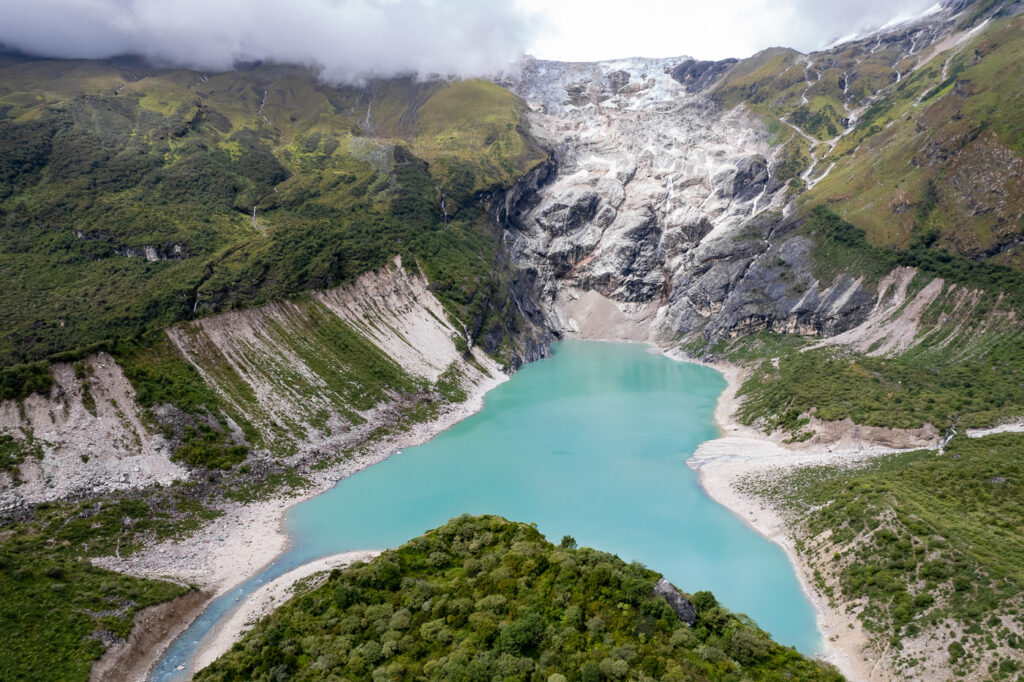
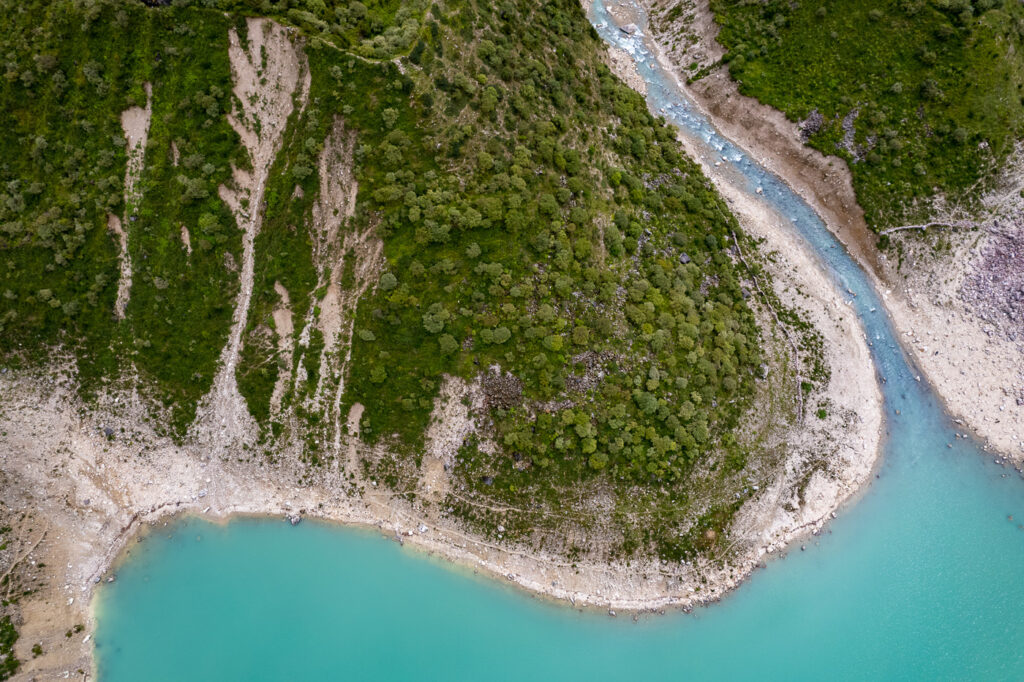
Each night we went for a wander through the village chatting with local kids and residents of the village. It can often be difficult to connect with locals but with Pema being able to speak Tibetan we could communicate a little. More often than not our conversations were limited to telling the young kids we didn’t have any chocolate, but they were super cute and very curious about the shutter button on my camera, which took a beating.
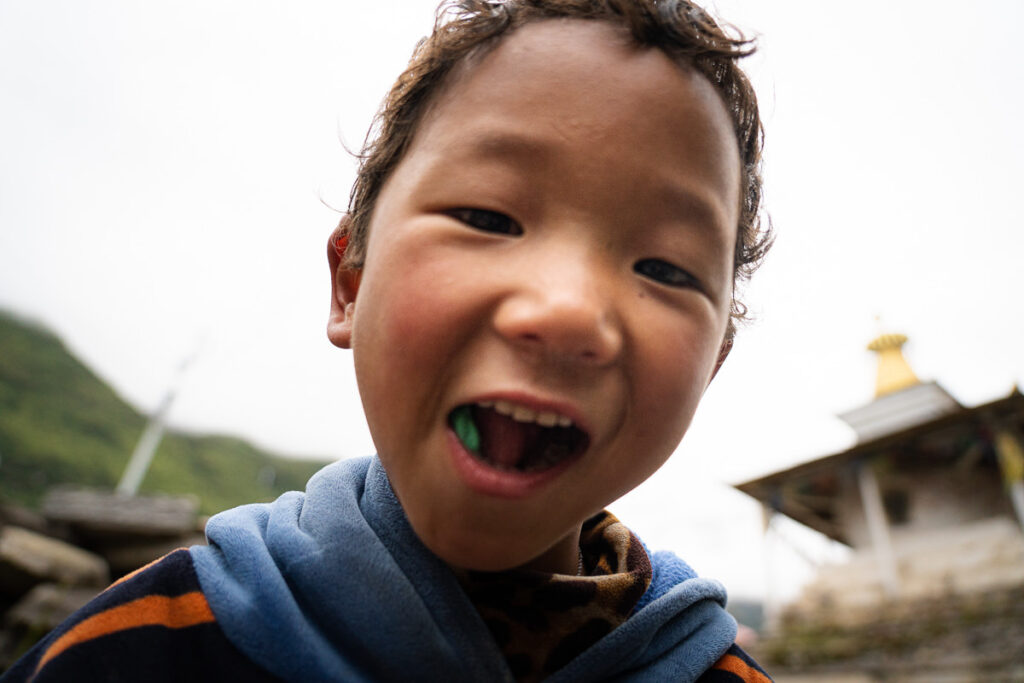
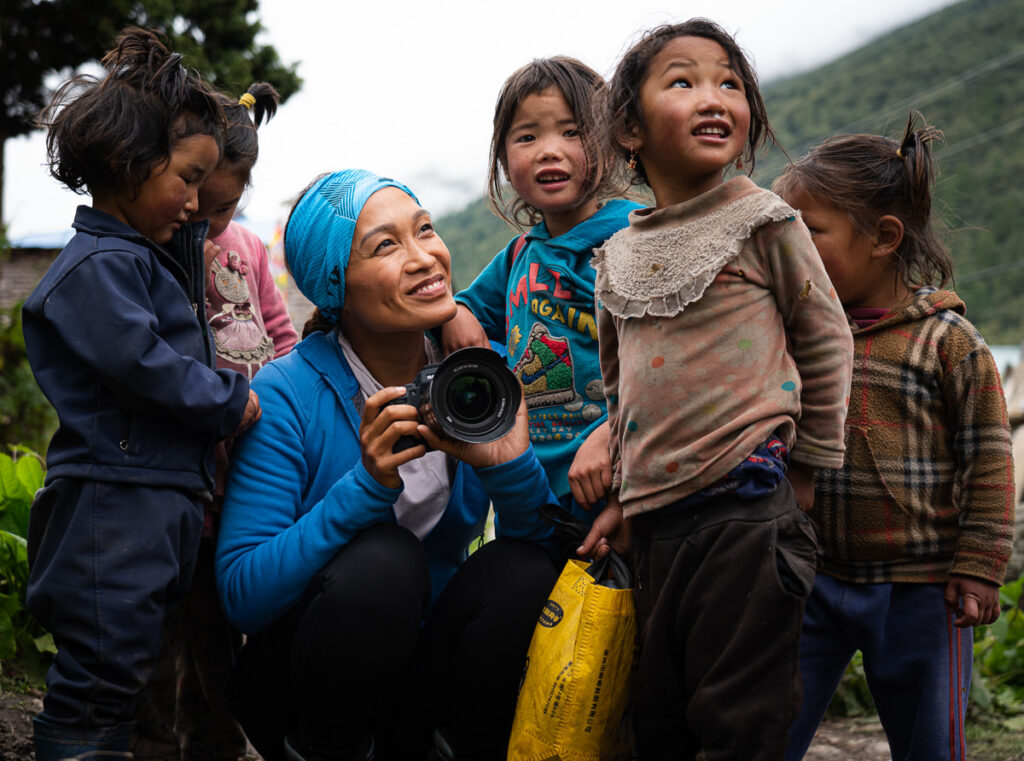
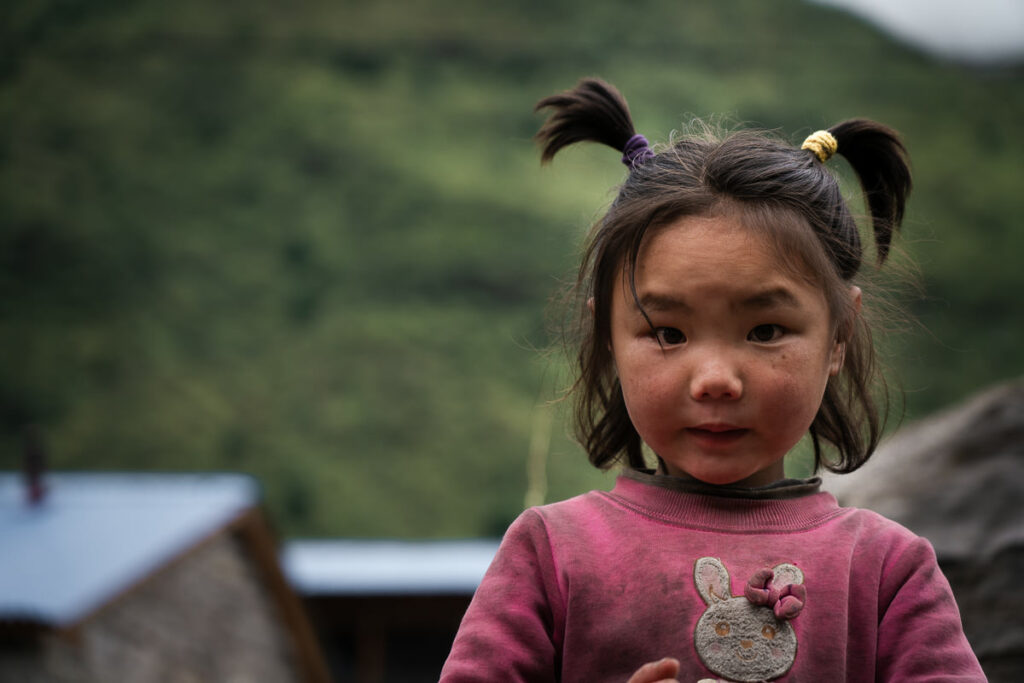
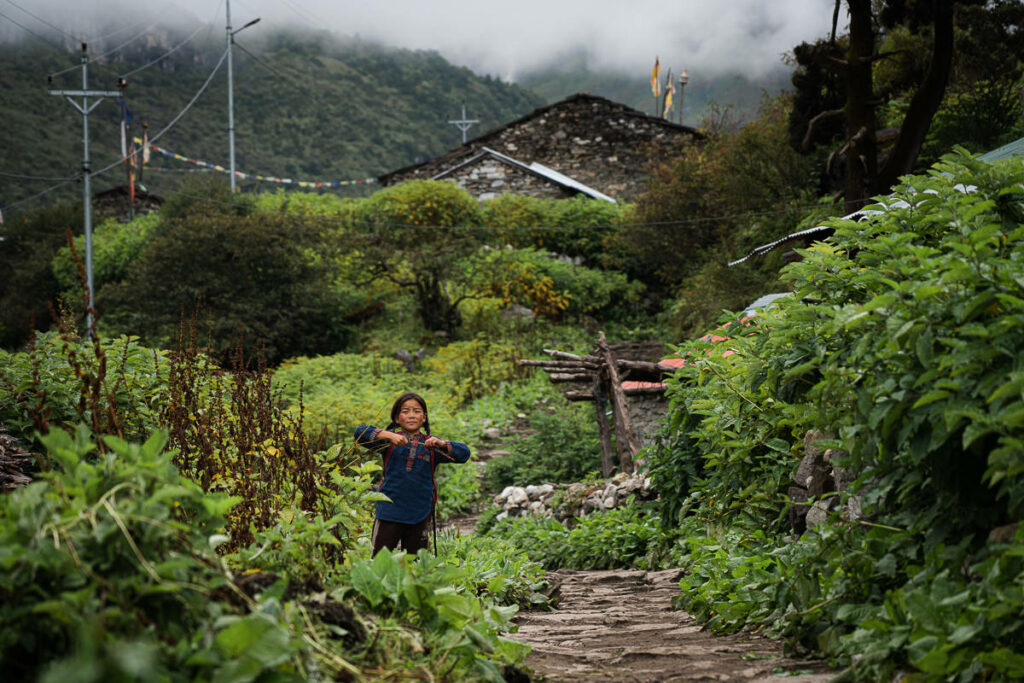
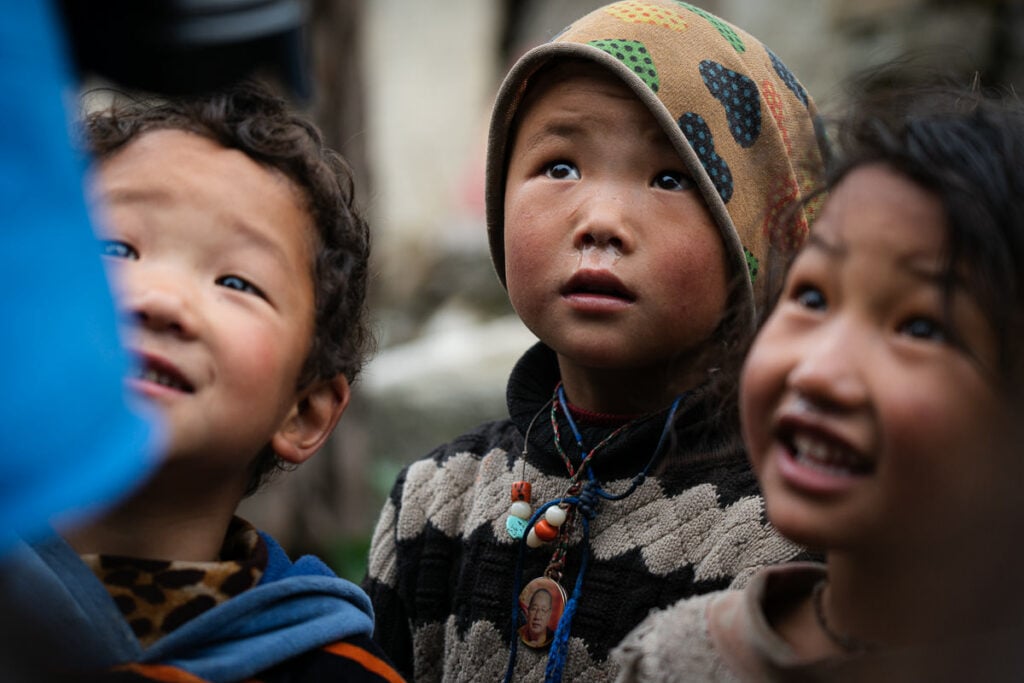
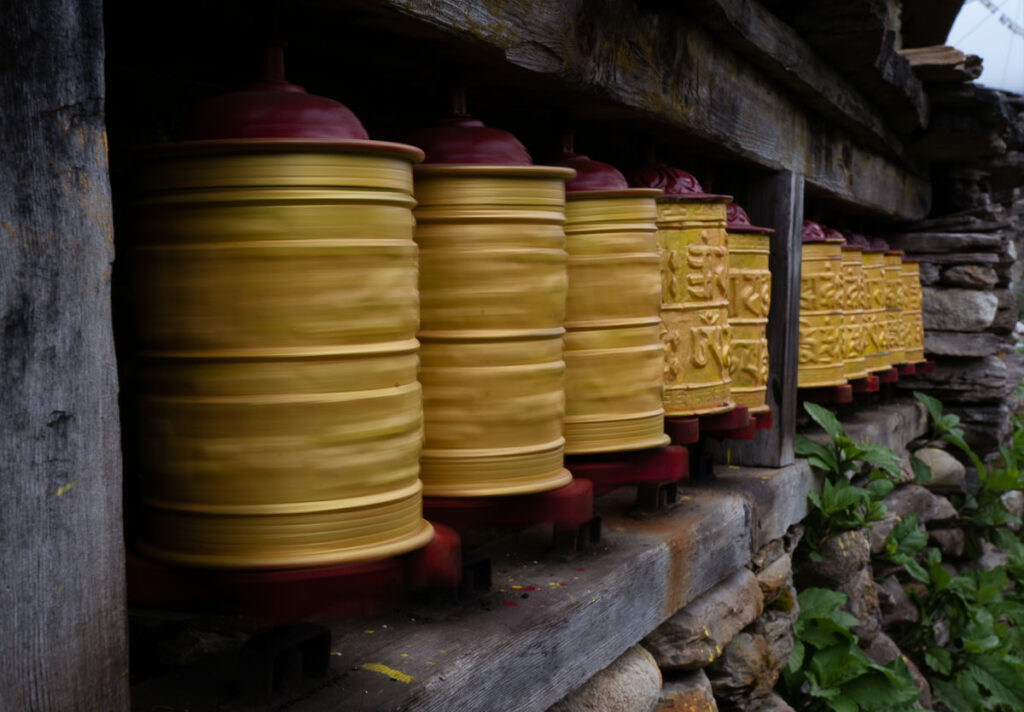
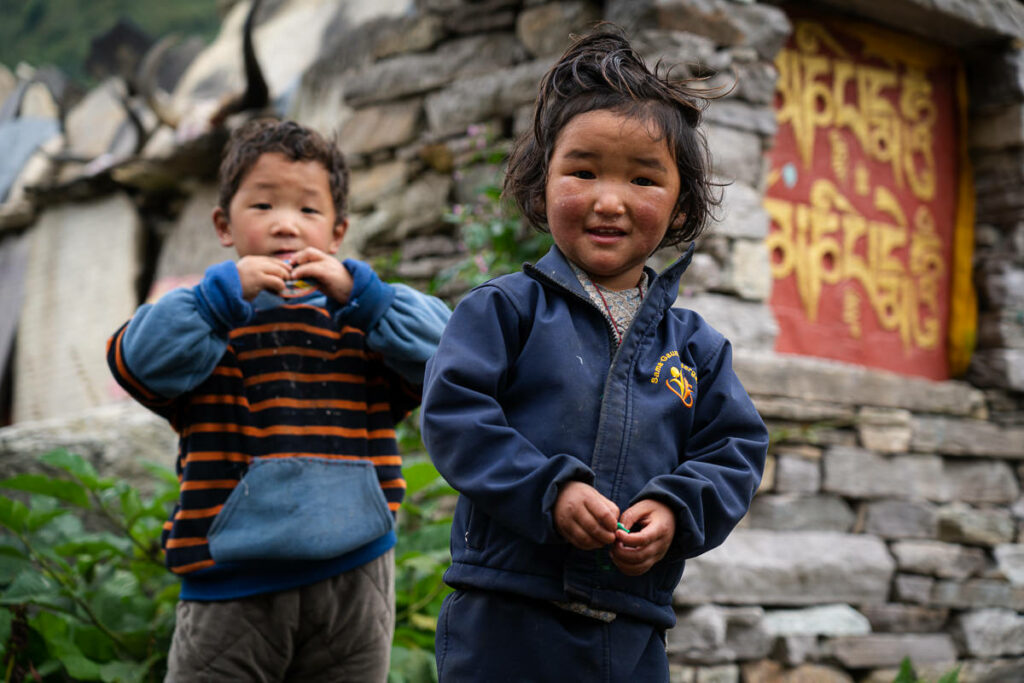

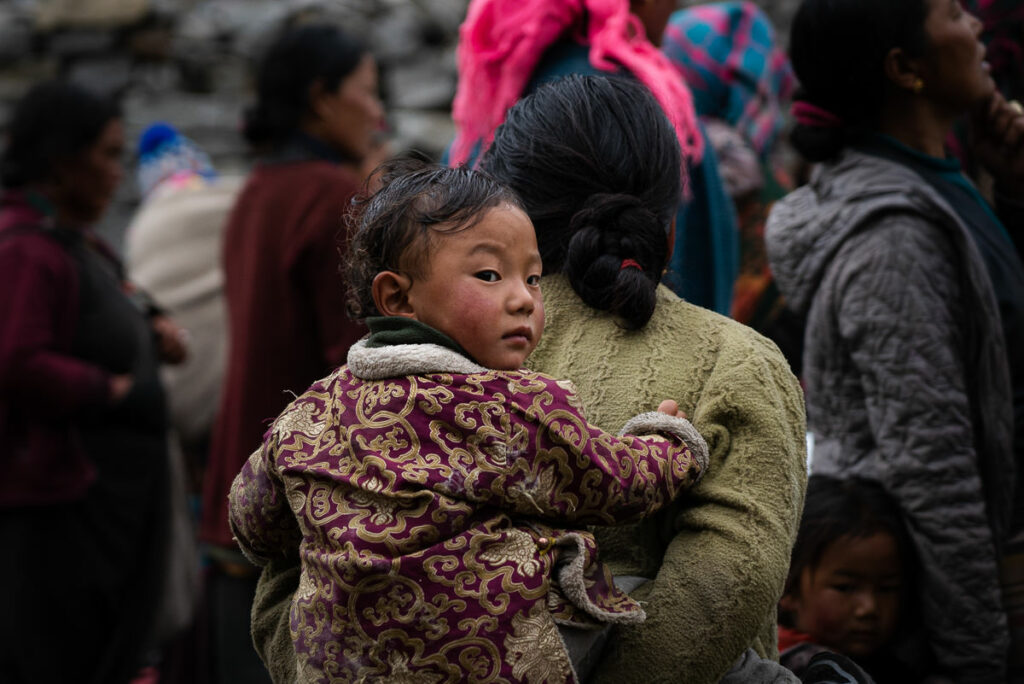
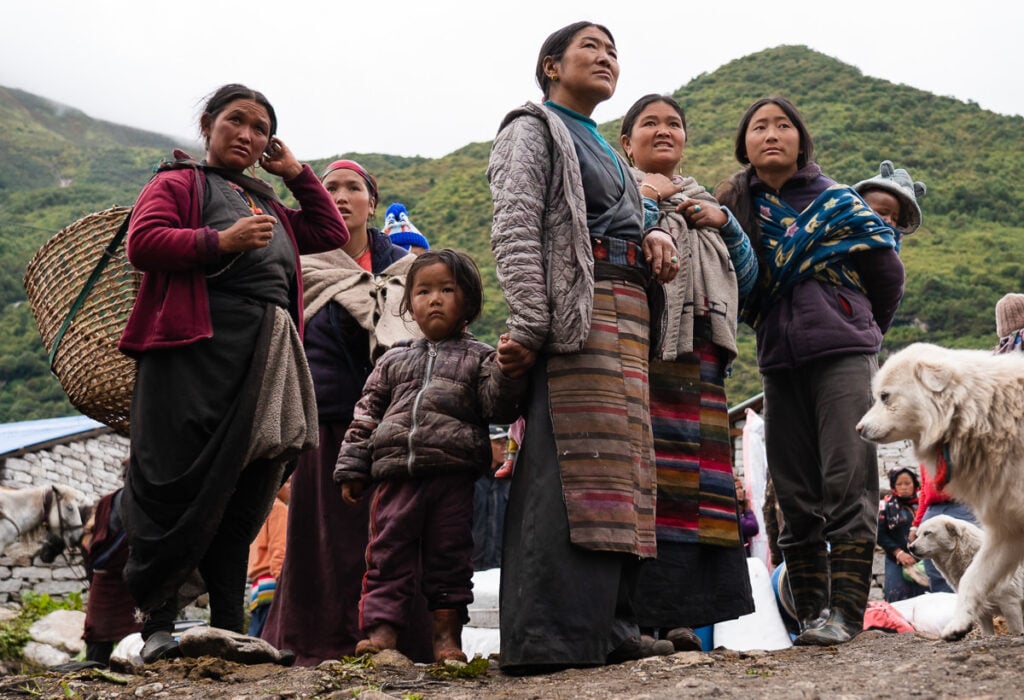
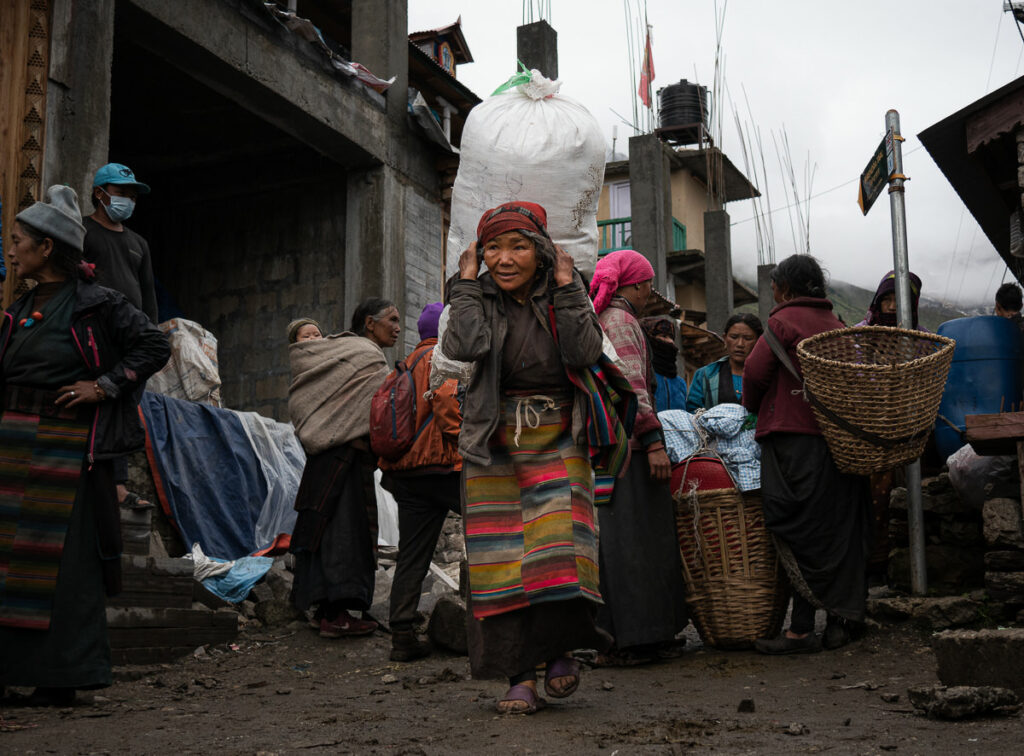
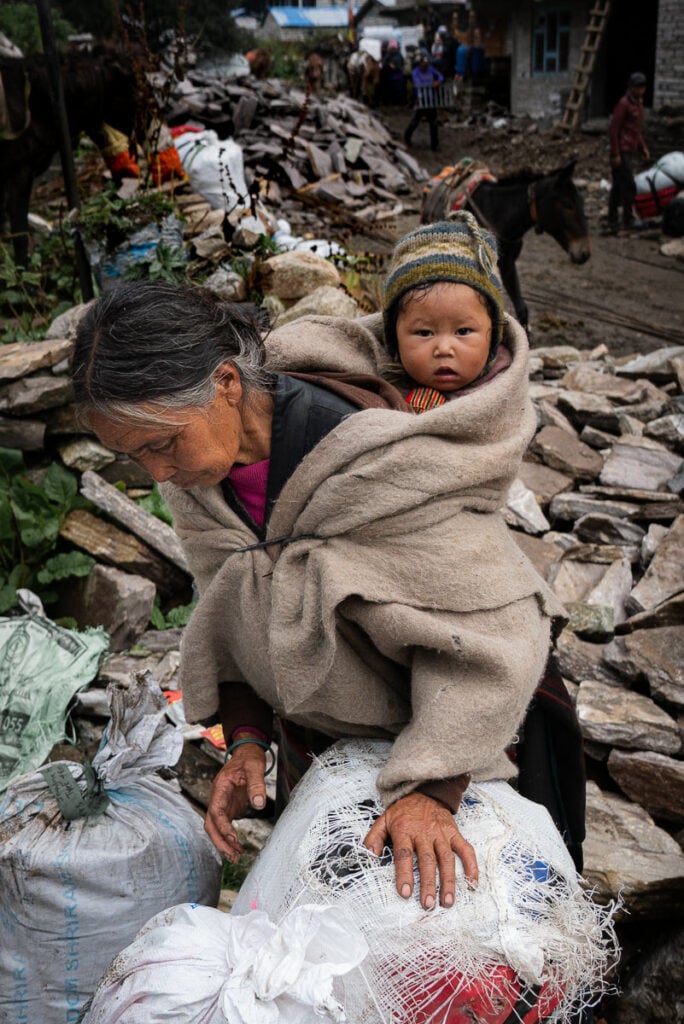
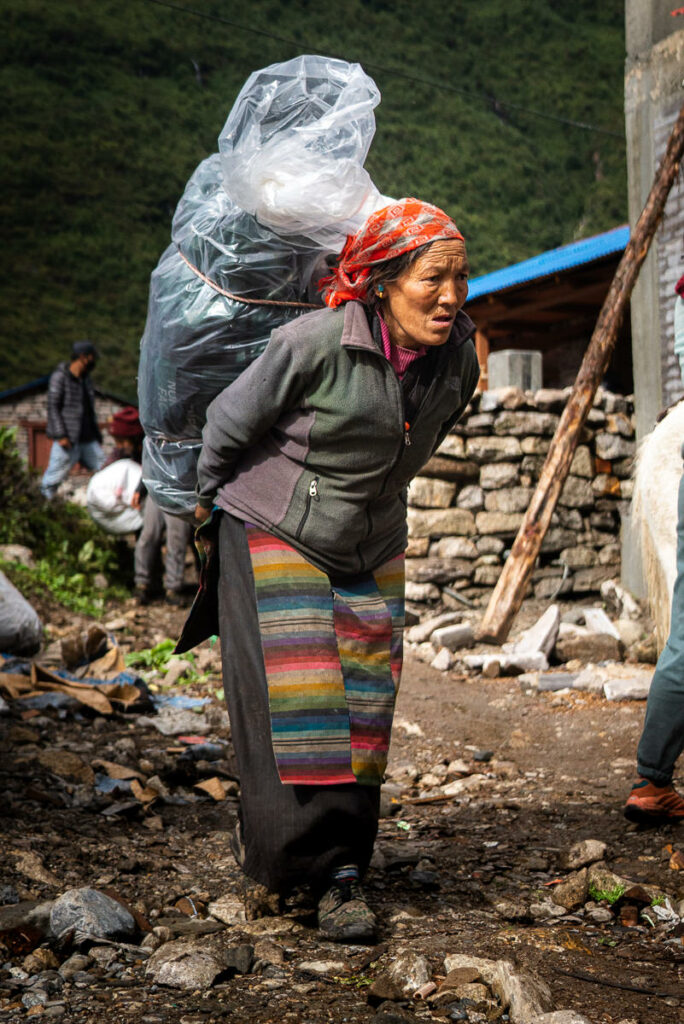
Our final outing was to a small plateau on the way to Samdo. Here we did a short mountain workout, which was definitely harder than at sea level. We were all out of breath as we tried to complete the military-style boot camp. All the while, huge mountains loomed over us on either side although taking in the view while catching your breath is slightly less enjoyable than while on a casual trek from village to village.
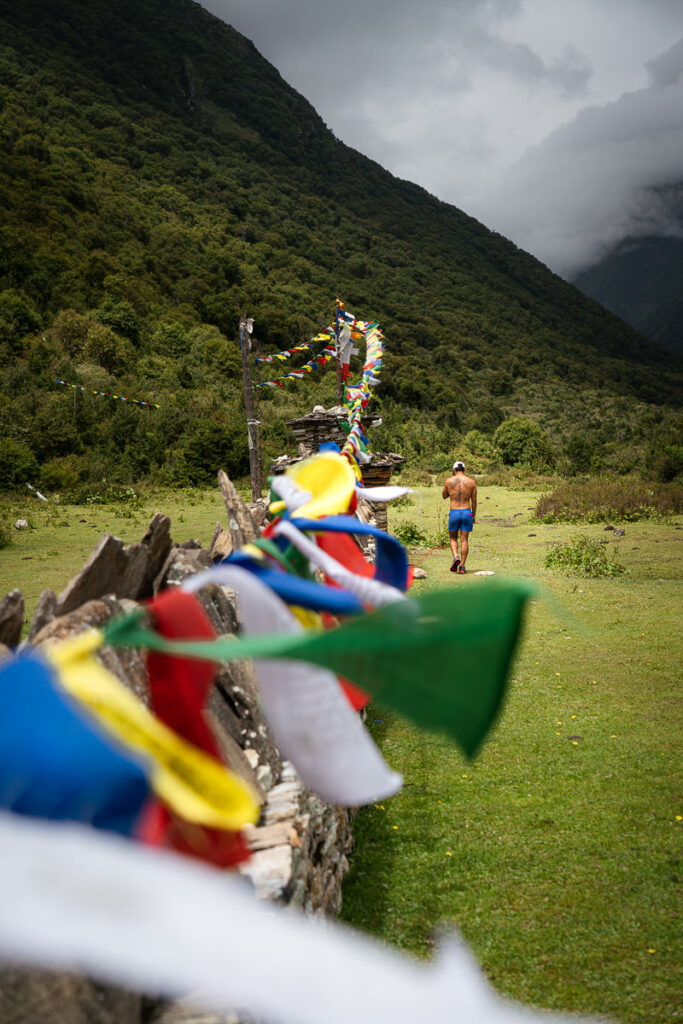
After a few slow days in Samagaun, it was time to make the trek up to base camp. Located at 4,800m above sea level, Manaslu Base Camp would be our home for the next month. The porter team had already set up the extensive camp and would carry most of our duffels and gear while we carried just our personal items and camera gear up to camp.
As we rolled out of Samagaun, it felt as though the adventure had finally begun. We would be sleeping in tents from here on out as we experienced life in the mountains.
The trek from Samagaun to Manaslu Base Camp was 7.5km with 1270m of incline. It’s a slow migration of climbers winding their way up the cliffs above Birendra Lake. At a leisurely pace with lots of photos, the trek took us just over five hours but can easily be completed in about three hours.
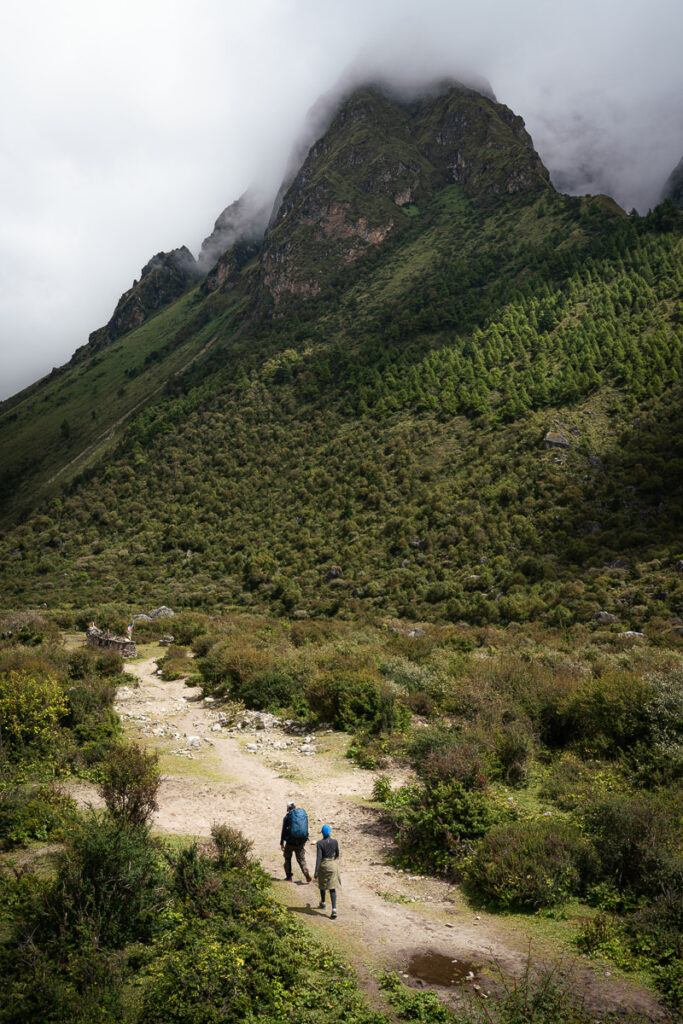
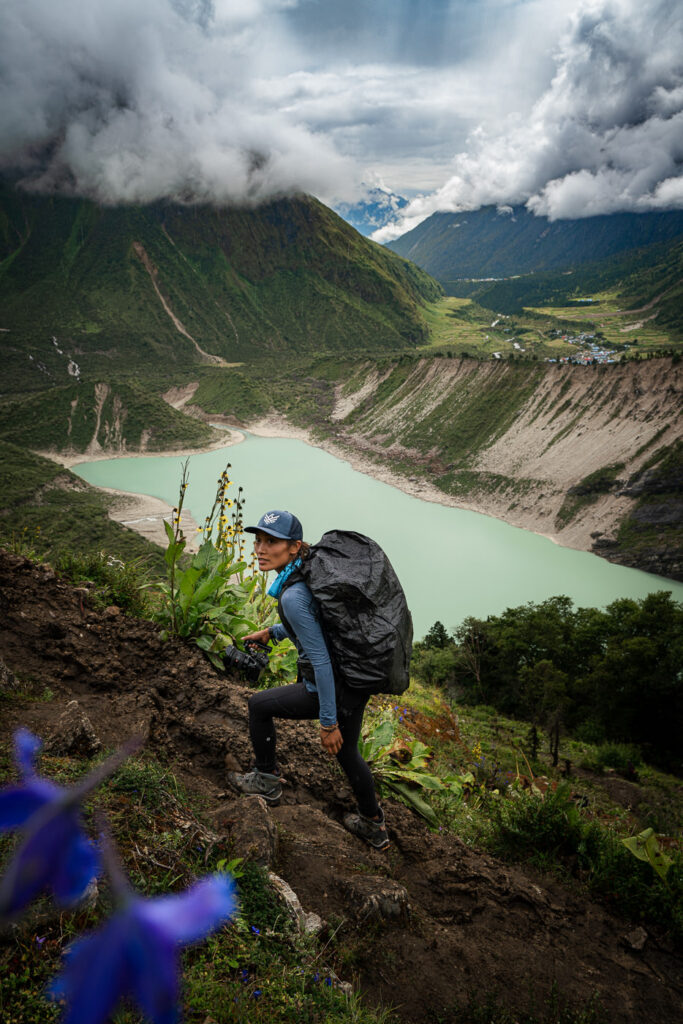
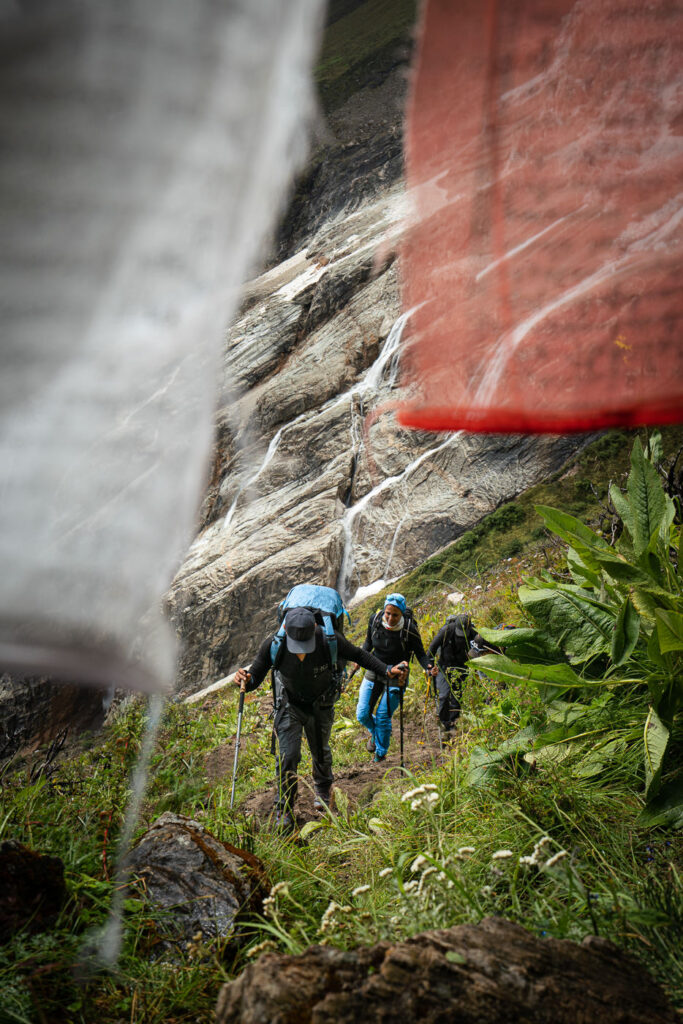
When the clouds aren’t causing havoc, the views from along the trail provide spectacular vantage points of Samagaun Village, Birendra Lake, and the rugged glaciers. It’s a great hike in itself and can be done as an acclimatization day-trip for trekkers on the Manaslu Circuit.
We edged over the final, rocky ridge before peering down into the expansive base camp setup. It started to feel real. With 157 permits granted to climbers for the Manaslu Climb this year, there were more than 400 climbers and crew in total at base camp. It looked more like a mountain village than a tented base camp. This was our new home.
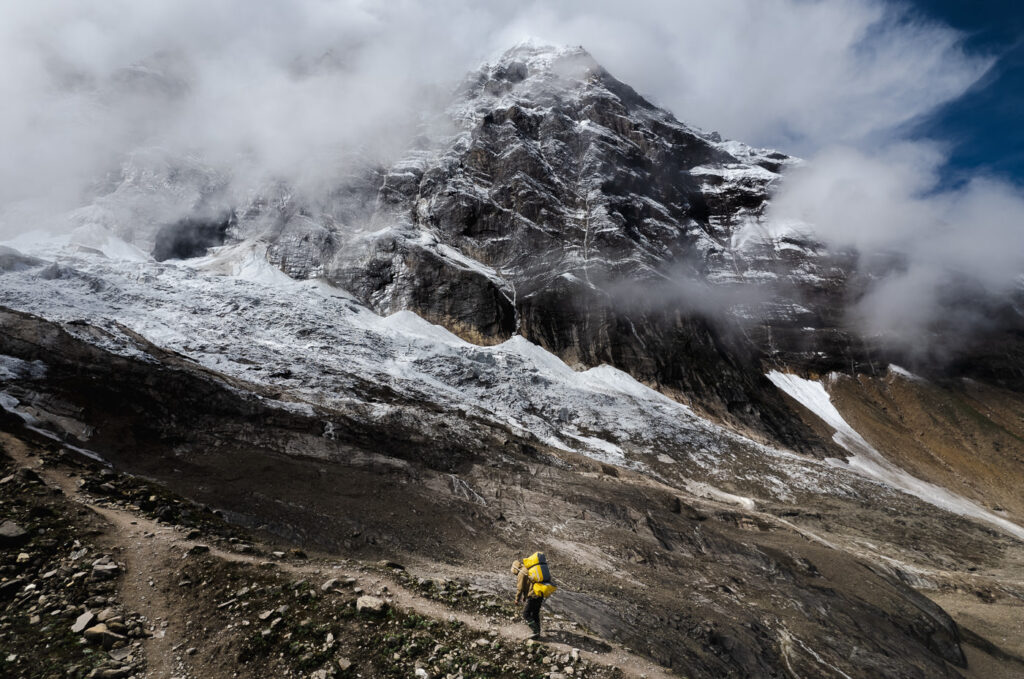
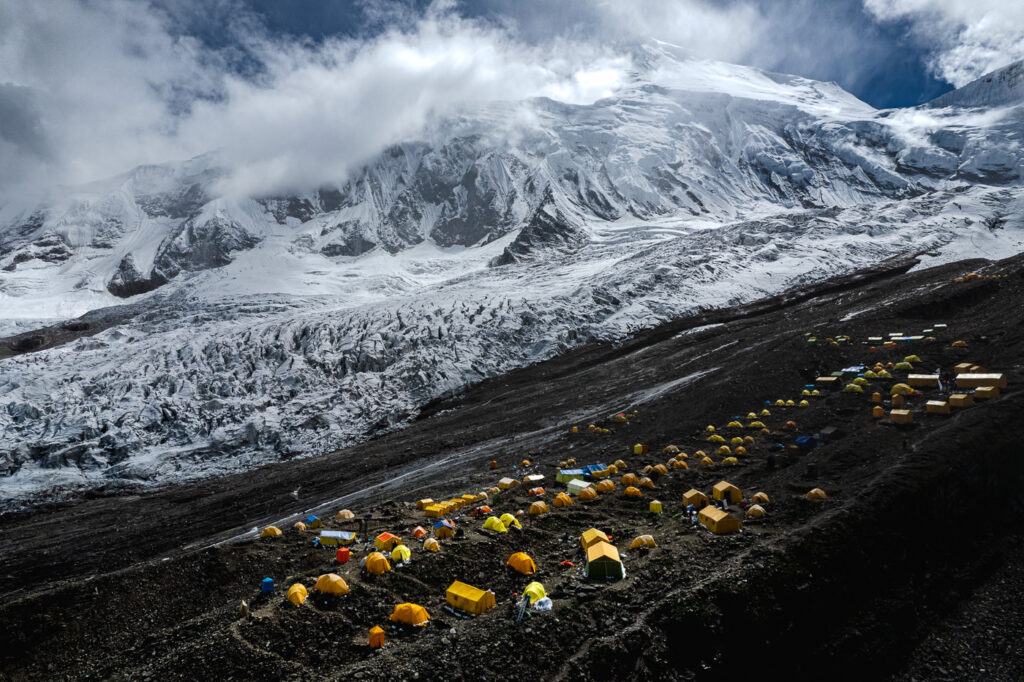
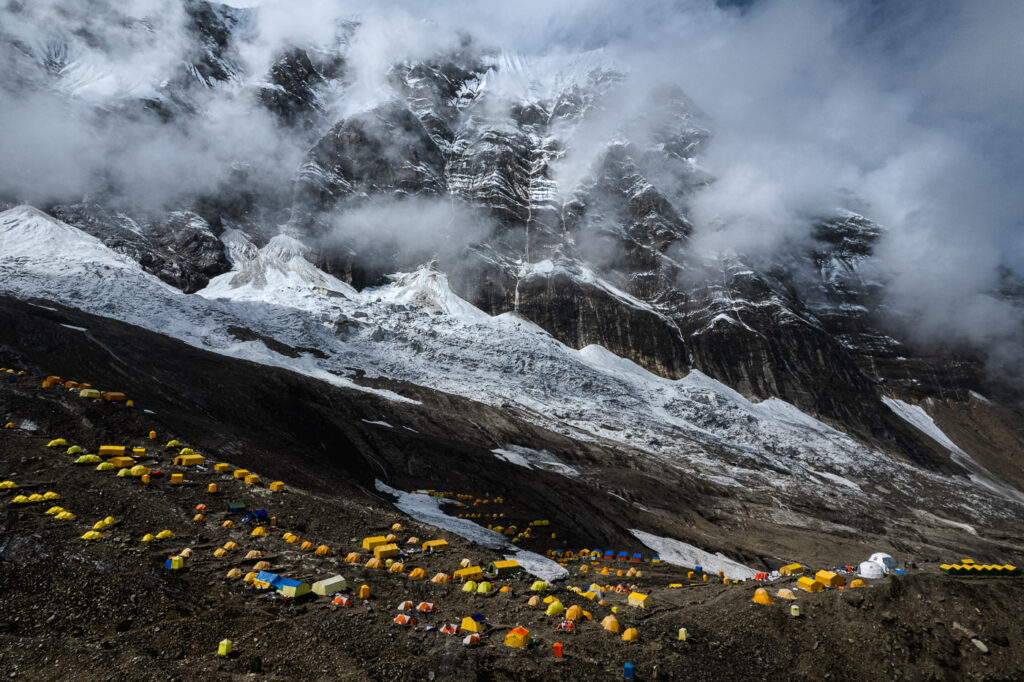
My climbing company provided a luxury service than many of the other climbing companies. Our base camp was perched about halfway up the tent city and had all of the amenities you could ask for at such a remote location and lofty altitude, including the following:
- Large single or double occupancy tents with thick mattresses and real pillows were provided for sleeping quarters.
- A large mess tent with synthetic grass floor, heater, charging station, unlimited snacks and drinks and also a comfortable place for reading, working on the computer or playing cards.
- A small toilet tent, which is essentially a slated rock platform with a large barrel installed underneath. It is emptied by the team and disposed of responsibly.
- A shower tent, which is basically a hideaway tent from the wind where you can have a warm bucket shower.
- The kitchen tent where the chef and team create some pretty high-quality food. It definitely wasn’t just lentils and rice on this trip with lots of different western options mixed in with Nepali food throughout the trip. The standard of food was definitely the highest I’ve experienced on an expedition.
- The WiFi was available for about $135 USD for the month but was unfortunately installed down at a lower camp for the first couple of weeks and was quite unreliable at our camp but worked intermittently.
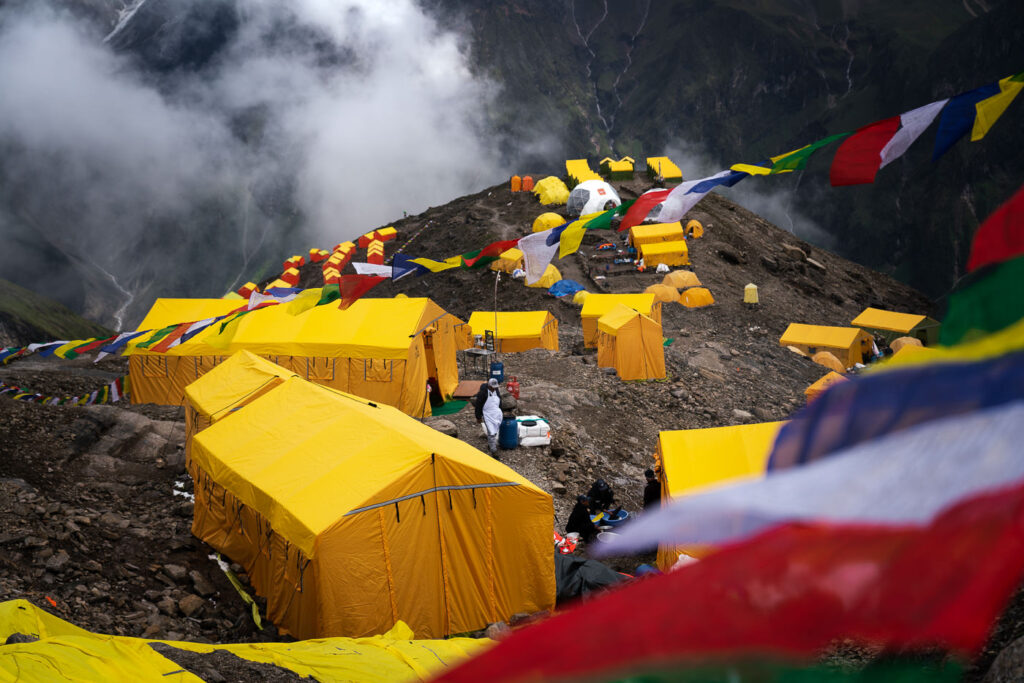
The weather was pretty rough for our first few days at base camp. The idea is to basically sit at base camp and then make your foray up into the mountains when the weather allows. Our plan was to make either one or two rotations before our summit push depending on the conditions.
Before any type of climbing begins, there is an important ceremony that takes place up at base camp for each expedition team. A traditional Puja ceremony is held to ask for safe passage from the spirits of the mountain. The Sherpa/Tibetan tradition involves the reading of prayers, some customs such as the spreading of rice, and offerings of various foods and alcohol. The Puja is finalized by the raising and hanging of Tibetan prayer flags from the Stupa across the camp.
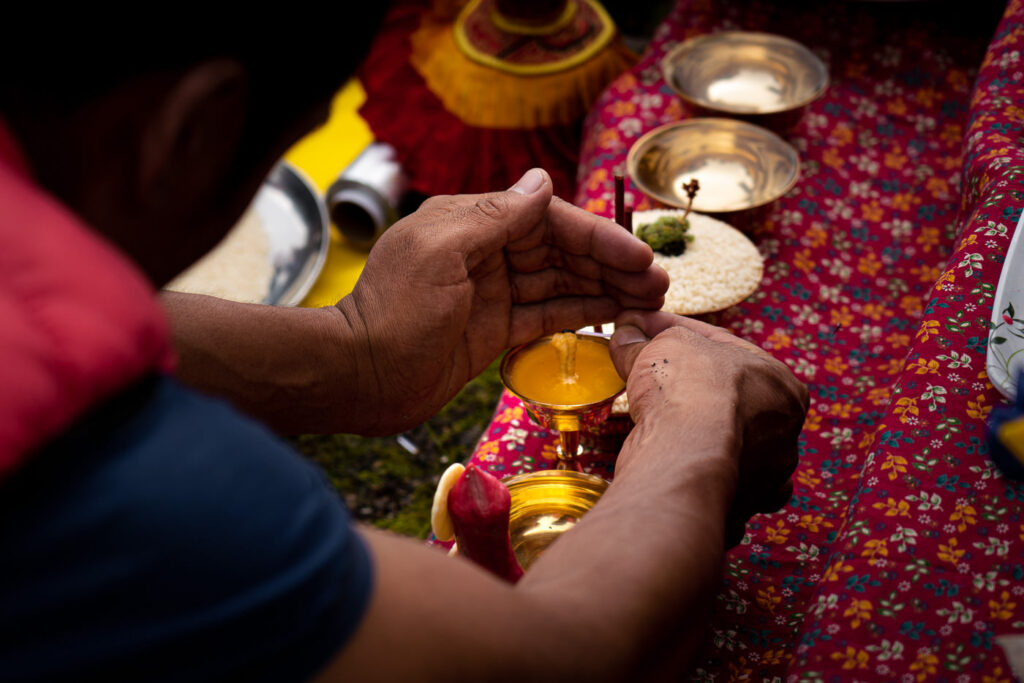
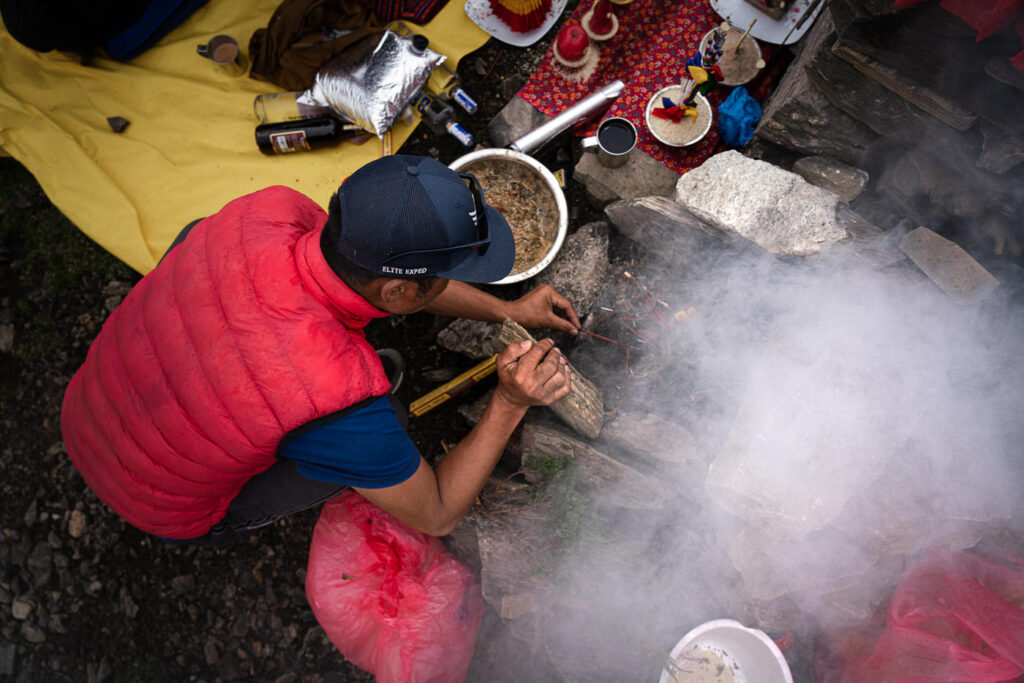
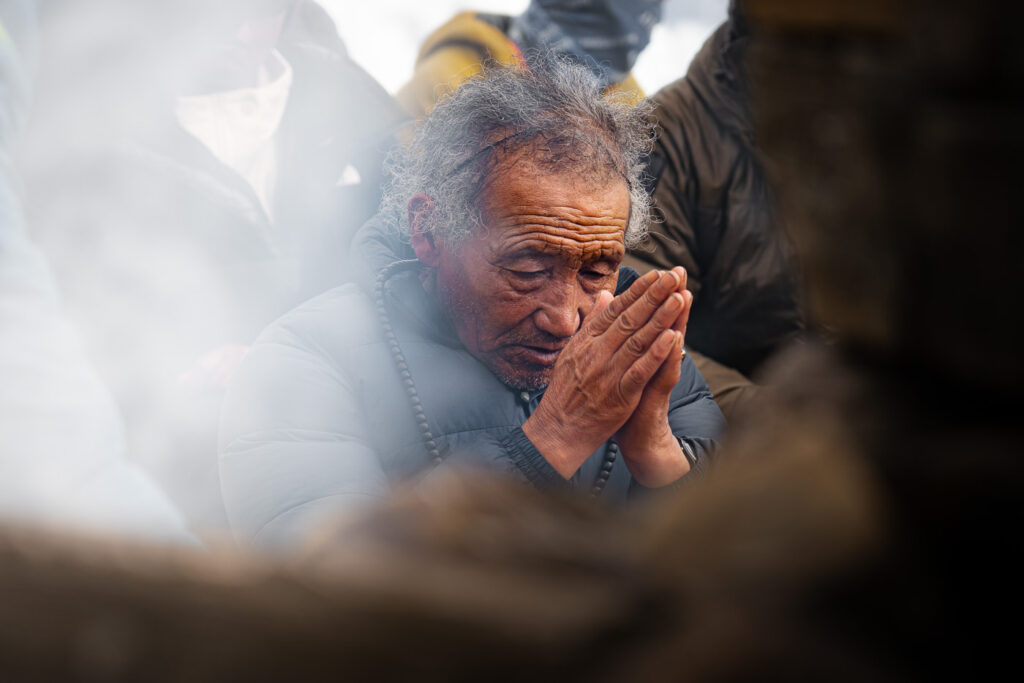
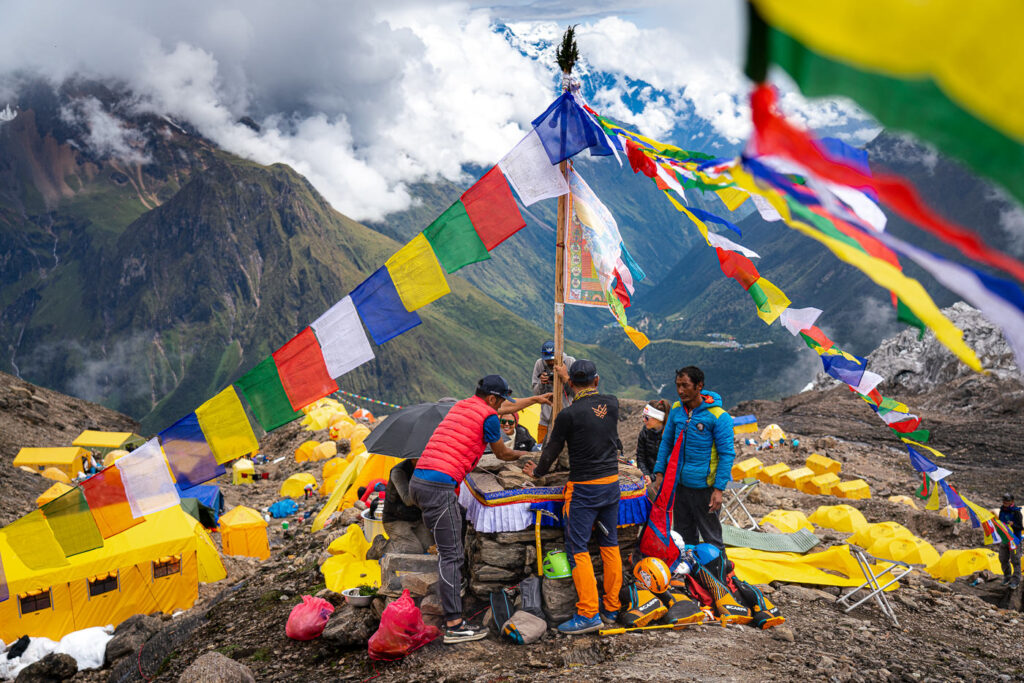
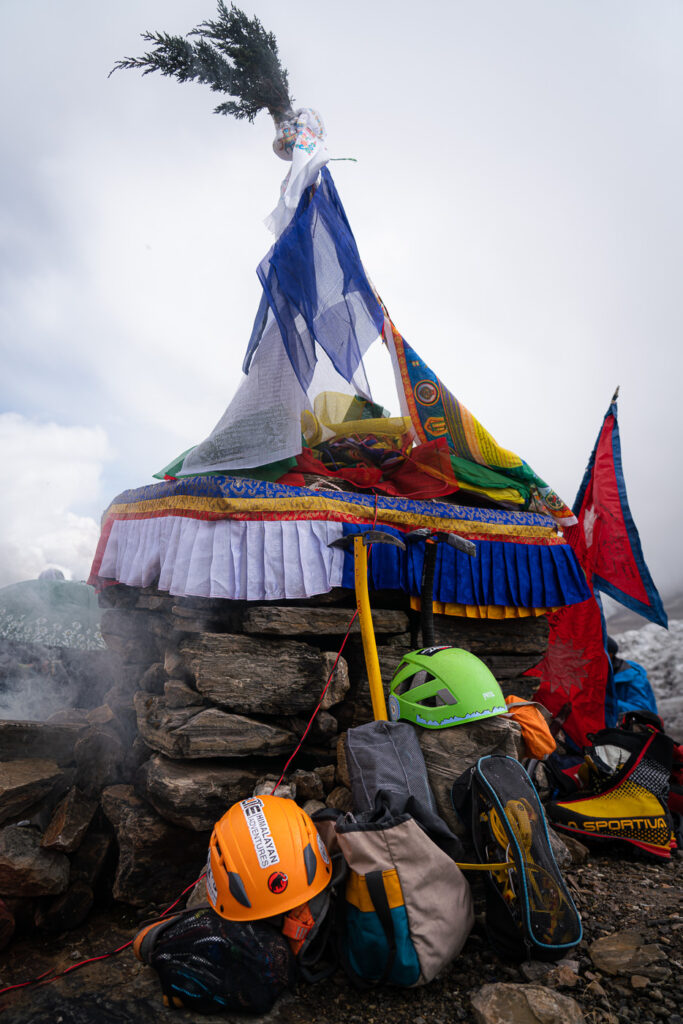
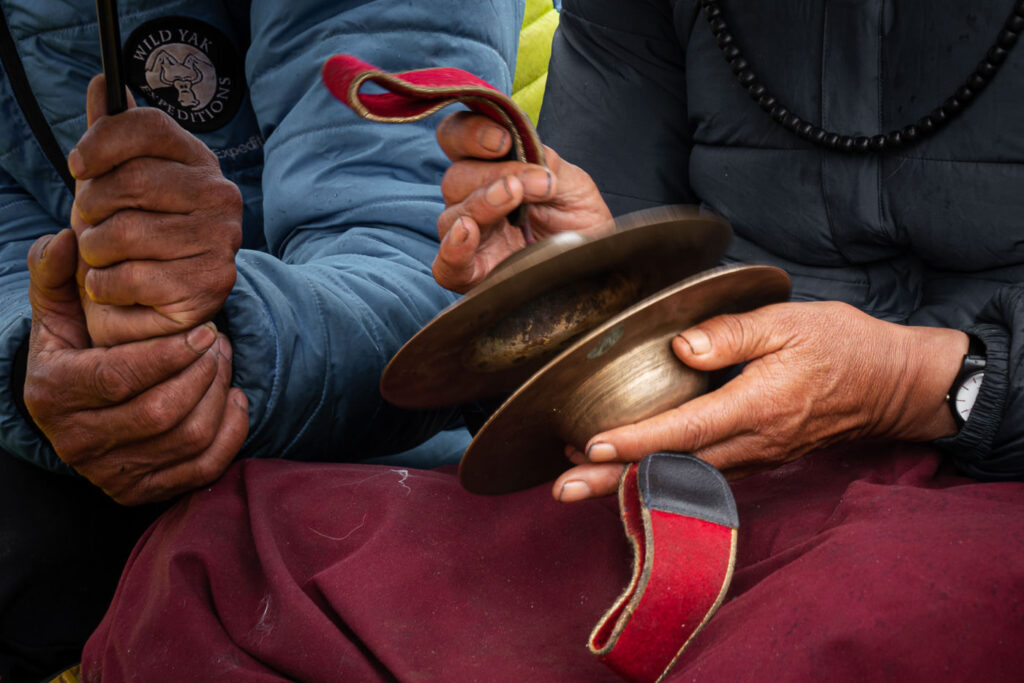
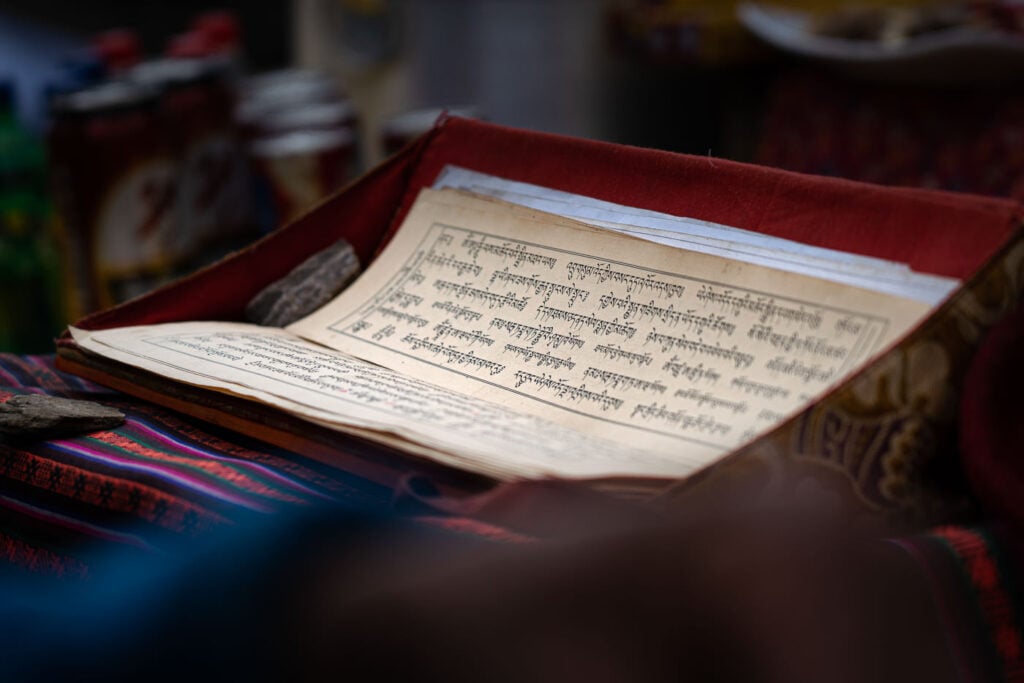
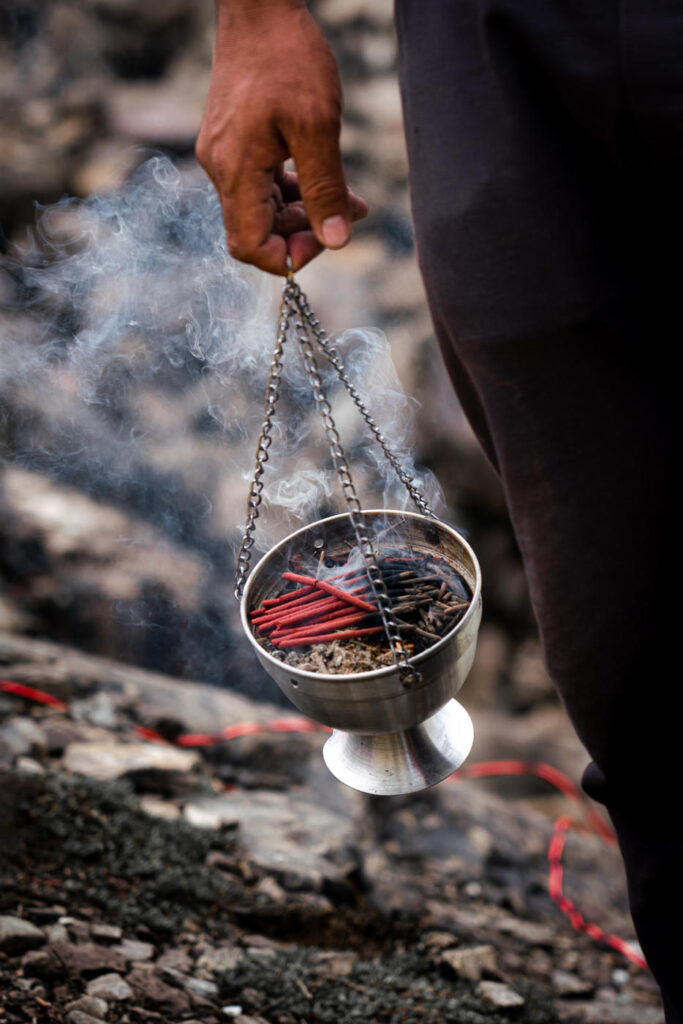
We began our mountaineering on Manaslu with a small training day, which led us up to the foot of a small inclination nearby where we practiced ascending with the Jumar and descending via belay back down the course. Snowy conditions made this a good test of our gear, skills, and attitude.
Several of our team were already well adept with these skills and had a refresher while for myself and others it was only the second time using a jumar. It’s a relatively straightforward skill to ascend or descend and having the physical strength and coordination before arriving is much more important. A winter mountaineering skills course is recommended before taking on an 8000m peak like Manaslu.
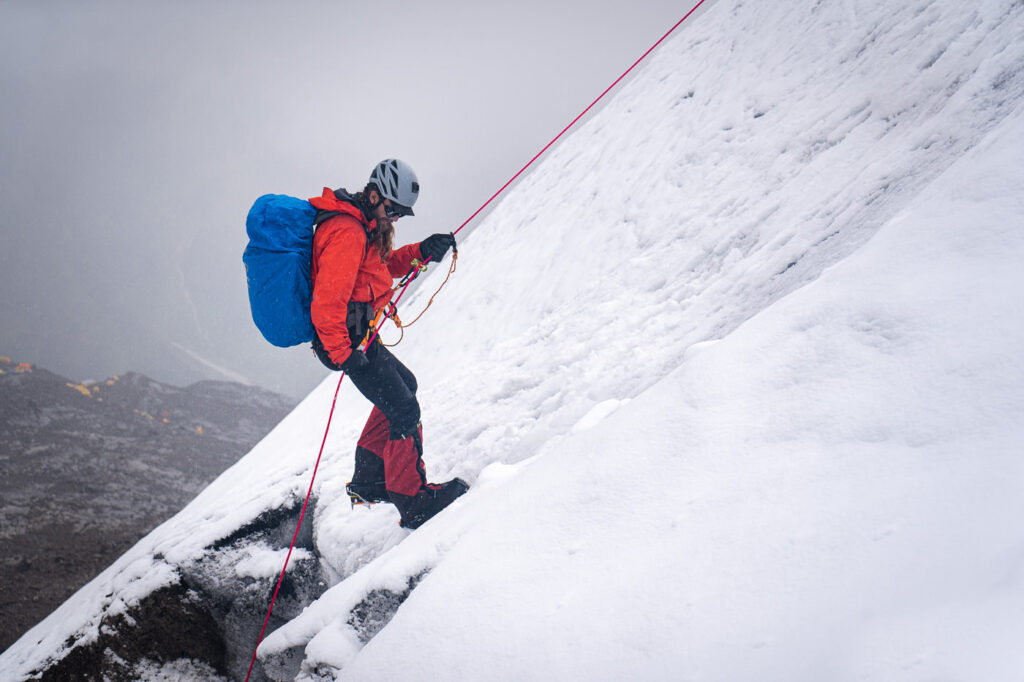
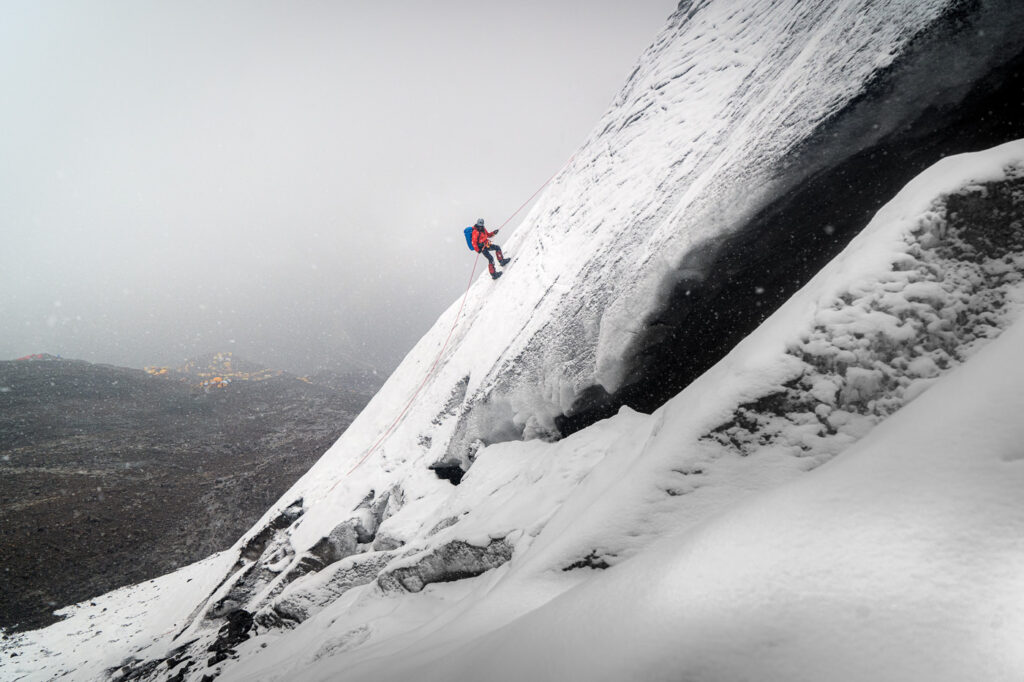
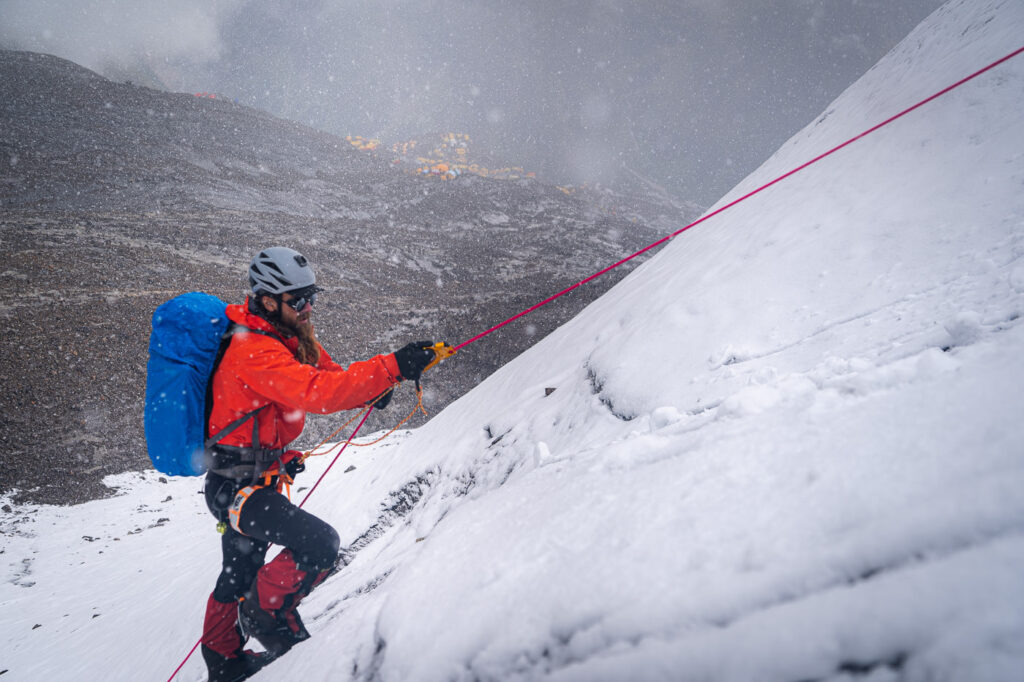
After our training day in the snow, we sat it out and waited at base camp for the first window to make our first rotation up to the higher camps. Despite some heavy snow forecast we packed up our gear and decided to head up to Camp 1.
Sickness had struck two of our team members, one of which had to descend to Samagaun to recover. Pema had a fever but managed to stay up at base camp without needing to descend to recover. So our team was down to three as we put on our warm layers and 8000-meter boots, walking out headfirst into the rain and wet snow.
There weren’t many teams out that day. In fact, we were the only team climbing up as many headed down. The trek from base camp to Camp 1 begins with about 1-kilometer along the rocky ridge at a steady incline before some light scrambling. Soon after the scramble, the snow begins to cover the rocks, and it’s time to put on the crampons and begin the snowy ascent up amidst the crevasses.
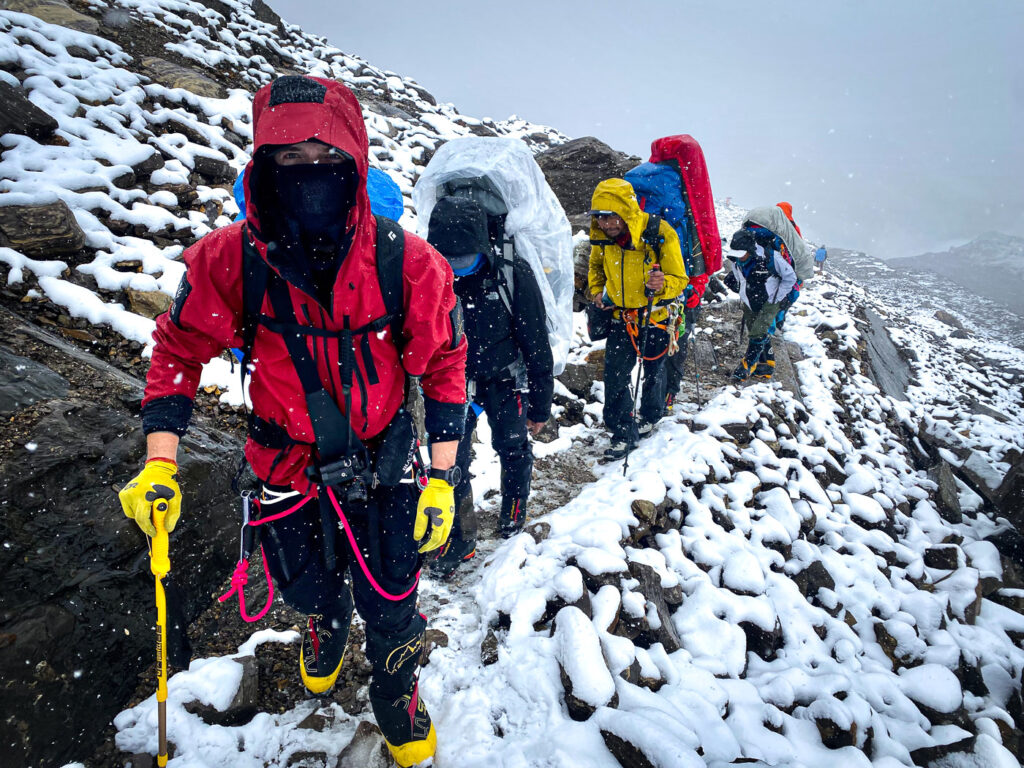
The journey up to Camp 1 is pretty tough due to the vertical kilometer of elevation gain to reach 5,800m. However, this route is not very technical, and only for one small section did we use the Jumar as safety to ascend a sharp little patch.
With slow and steady movement in terrible snowstorm conditions, we managed to make it up to Camp 1 within four hours. It’s manageable to do this climb in well under three hours, especially in good weather. Several huge crevasses and ice caves line either side of the route. Due to the large volume of traffic, the path is very clear and seemingly safe although the dramatic ice formations surrounding the route keep you on guard.
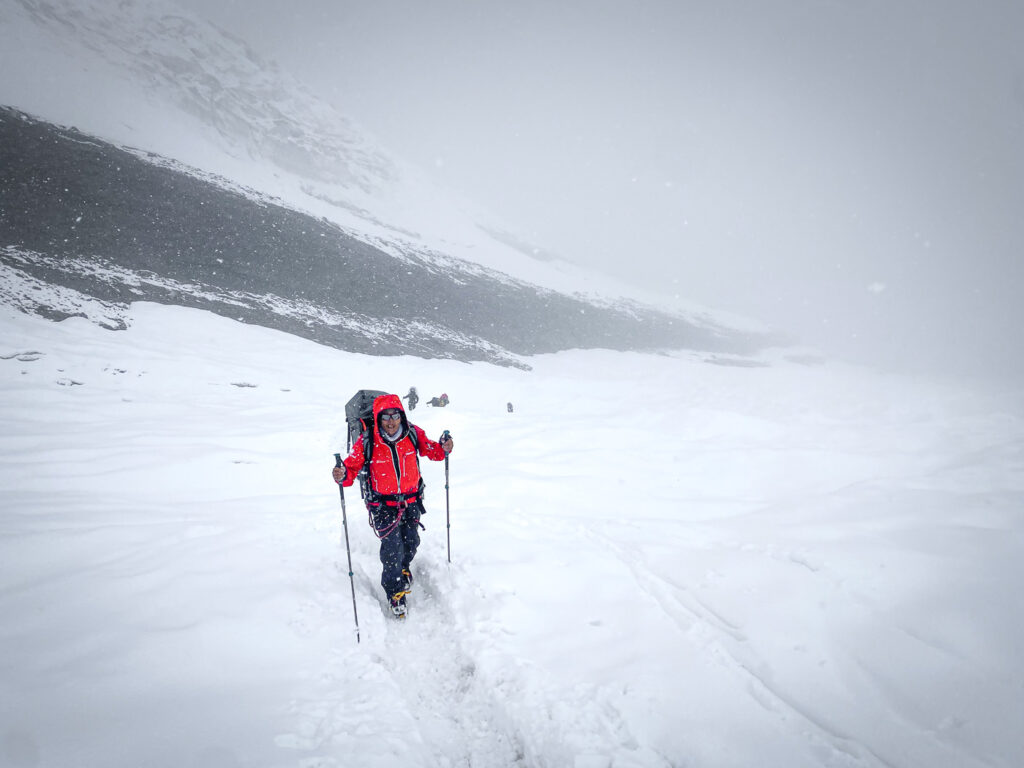
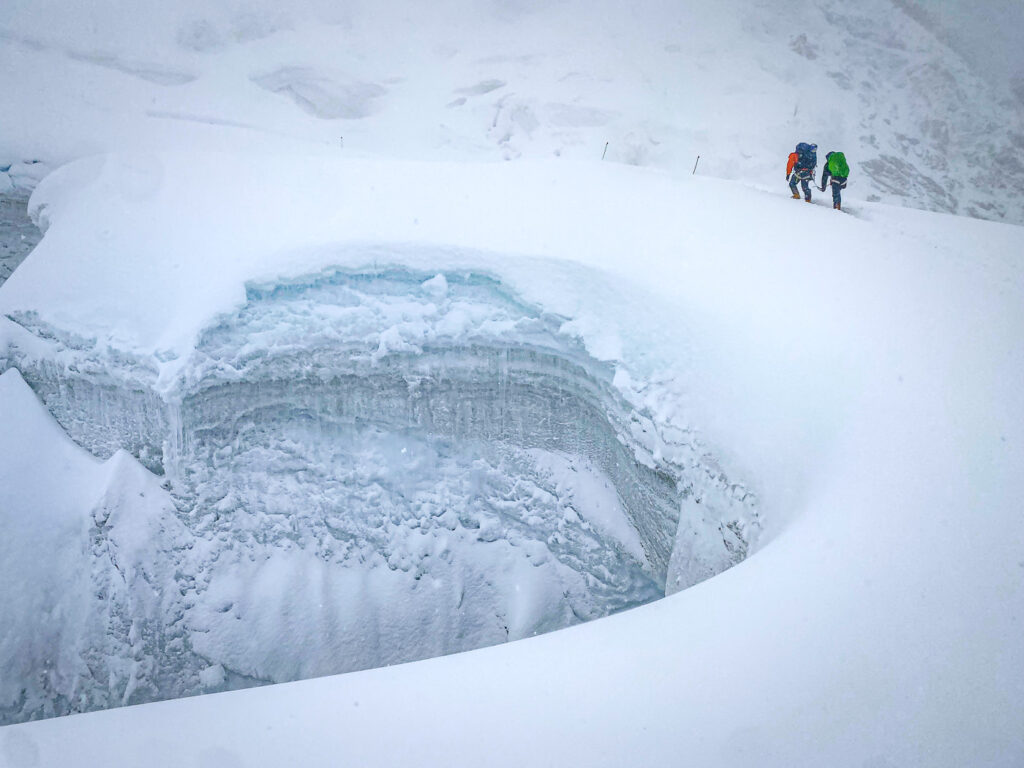
I was stoked to make it up to Camp 1. It’s nowhere near the summit but one step closer than base camp. The progress felt good. We hid out in our tents while the snow continued to fall.
Our expedition team had a small kitchen tent where we could hide out and hang out but for the next day and a half, the snow would hamper any real movement or activity at Camp 1. I did, however, manage to find a small break in the snowfall to fly the drone for some aerial views of the campsite.
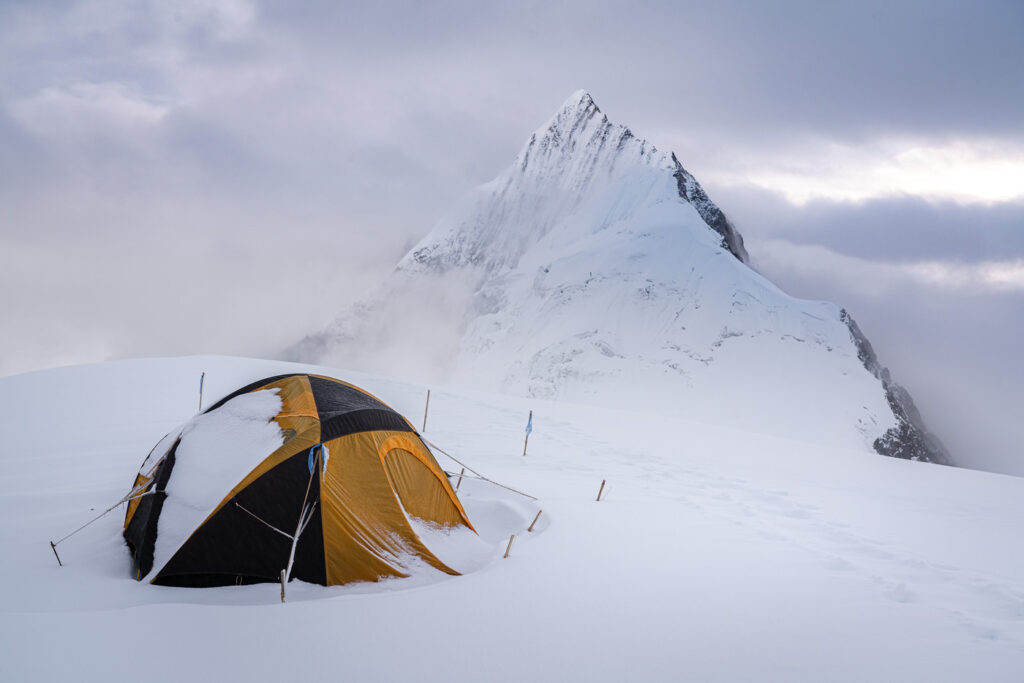
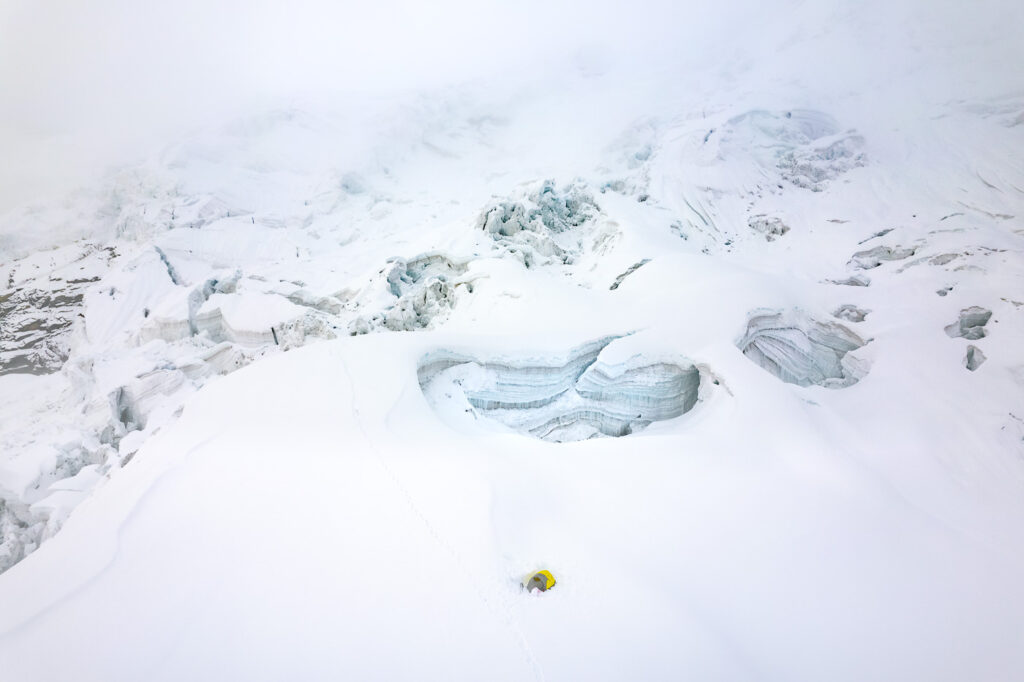
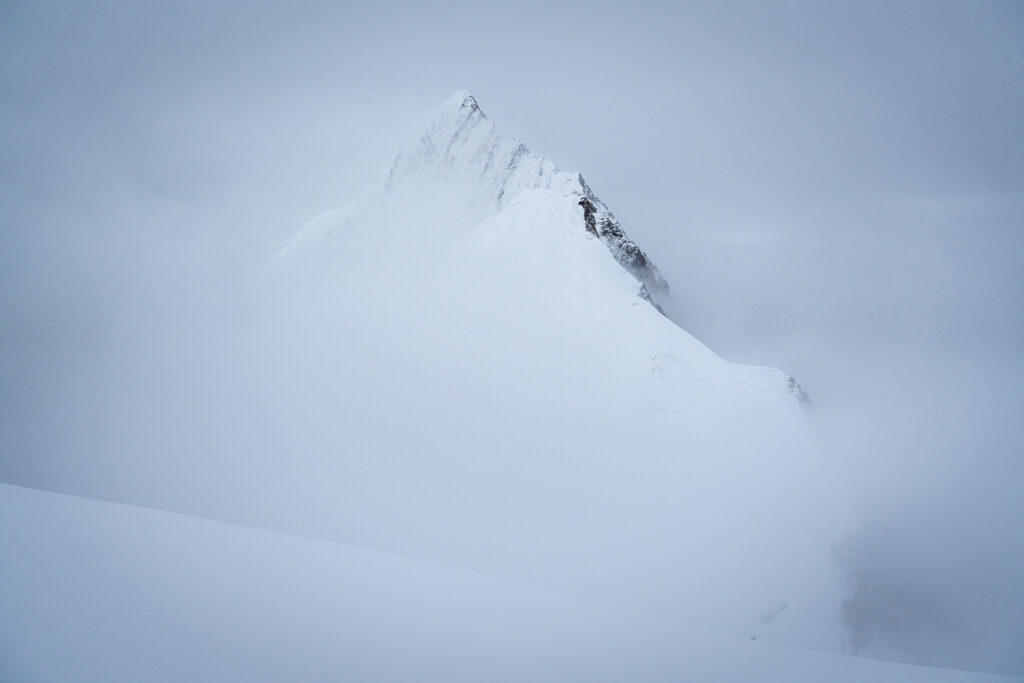
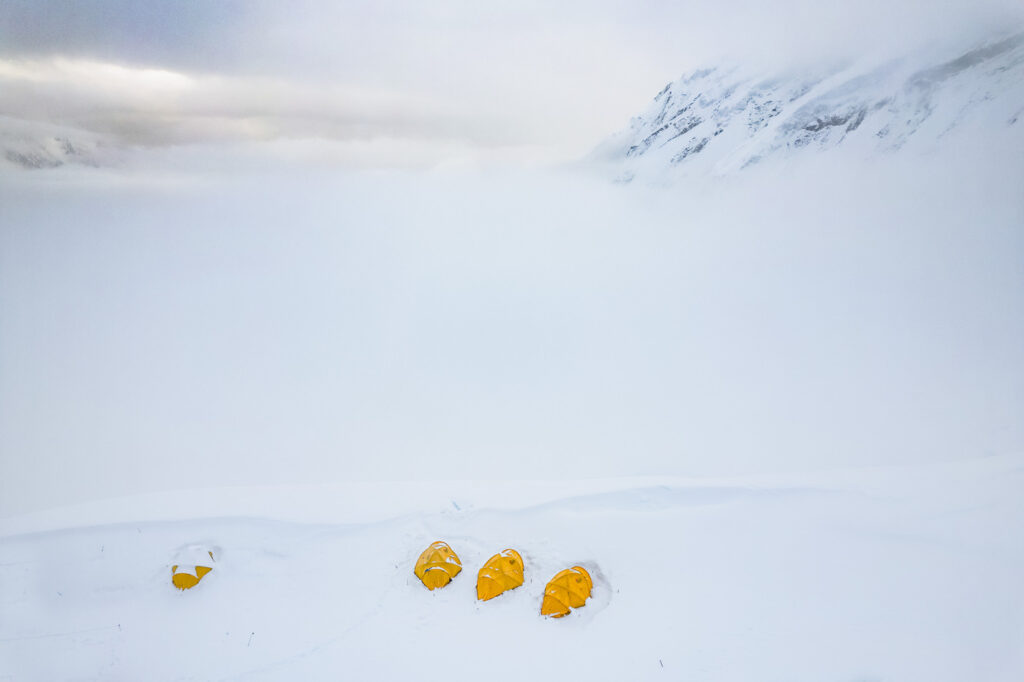
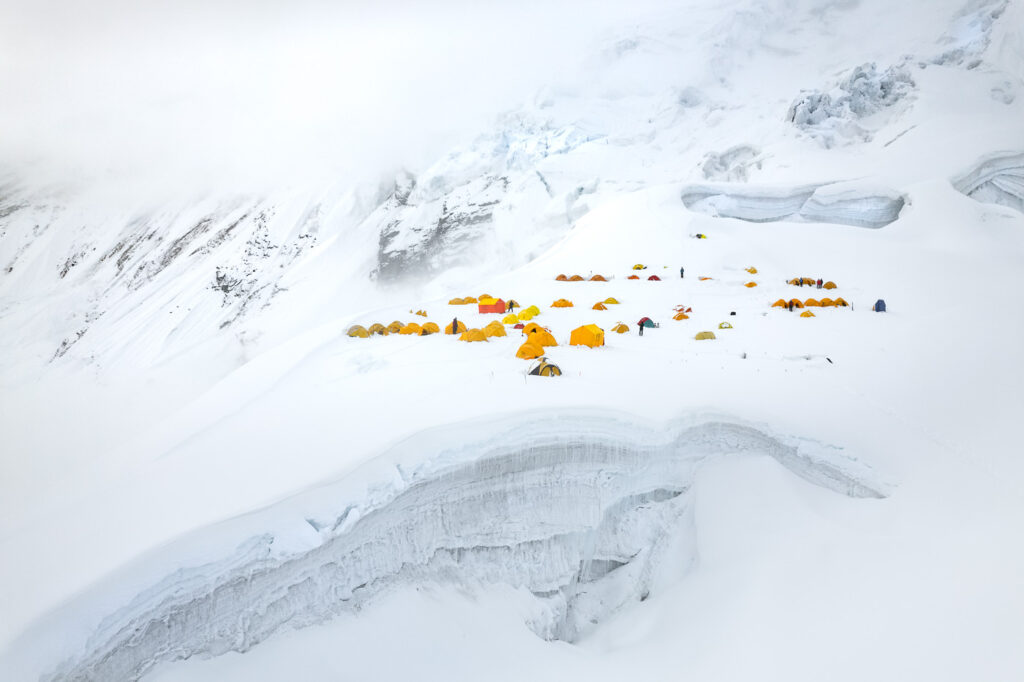
We decided to descend late the next day from Camp 1 due to inclement weather, which would stop us from advancing to Camp 2. The lines hadn’t been fixed yet but we had grabbed some good fitness and acclimatization in our first adventure up into the mountains.
Descending just thirty minutes before sunset was an interesting decision but an exciting adventure that had us arriving back to base camp well after dark. We arrived back to our temporary home wet, a little tired but richer for the experience of making it up and down from Camp 1. We took some rest for a day and a half before we would make our next ascent up into the mountains in search of higher camps on our second rotation.
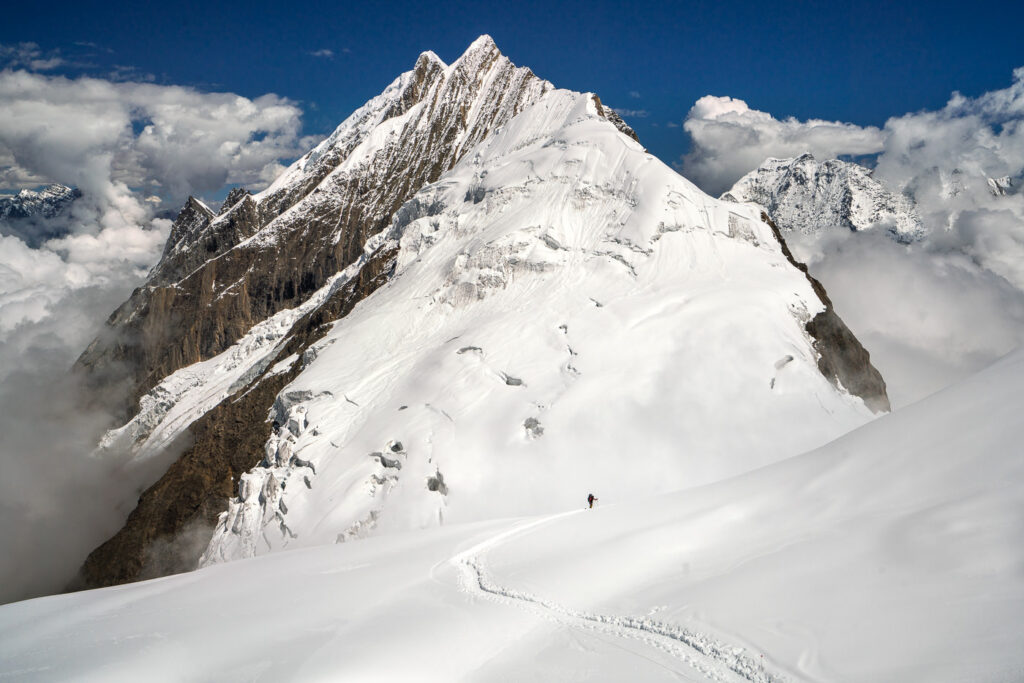
The second rotation had arrived. Our plan was to climb up to Camp 1 and sleep the night before climbing up to Camp 2 and sleeping there also. We would then return to basecamp on the third day. This would be enough acclimatization for our summit push because we were planning to use oxygen during our summit push.
Two others in our group would continue on and sleep the night at Camp 3 to help them acclimatize for their attempt to summit without oxygen.
Climbing up to Camp 1 from base camp was a very different scenario on this occasion compared to our first foray up the mountain. The sky was perfectly clear and we were roasting in our 8000m, double-lined boots. It was only a few days ago we had climbed up this same vertical kilometer route in a snowstorm. Things change quickly in the mountains.
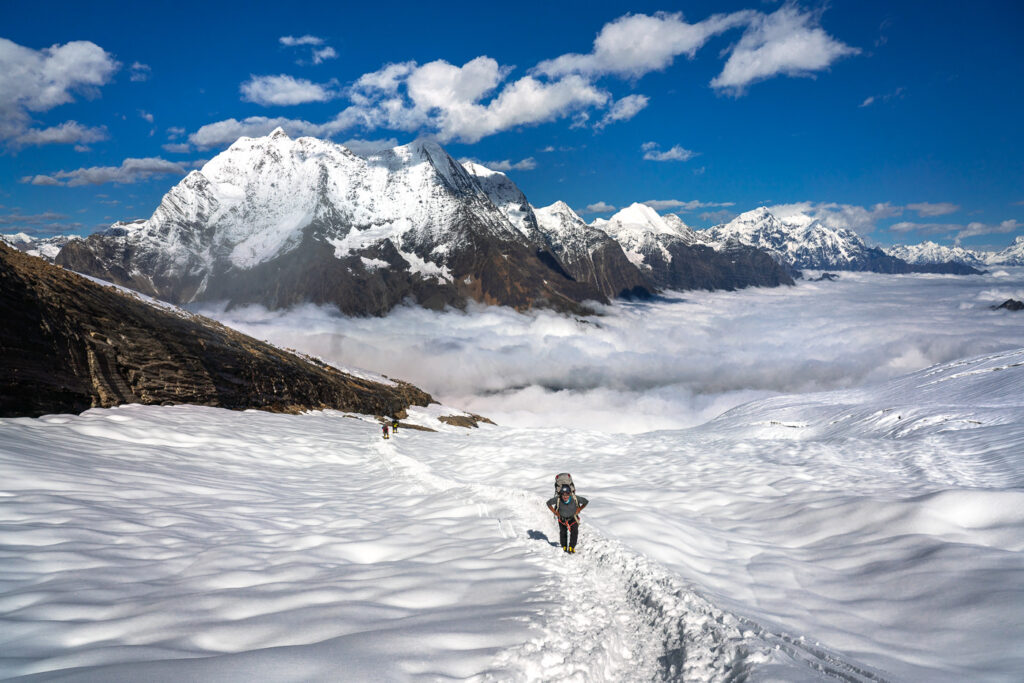
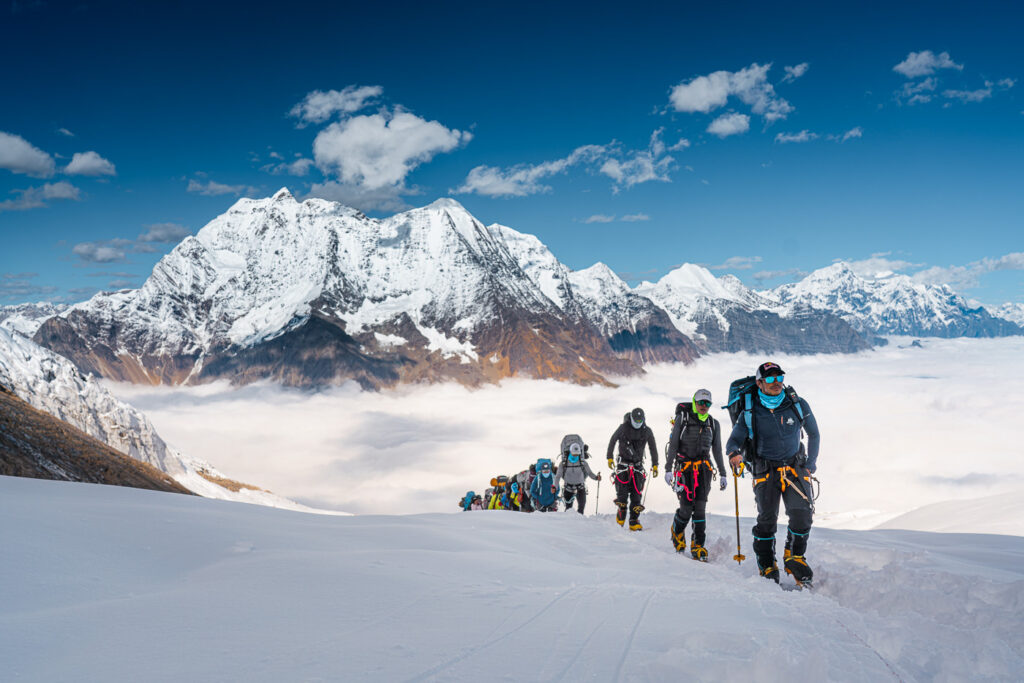
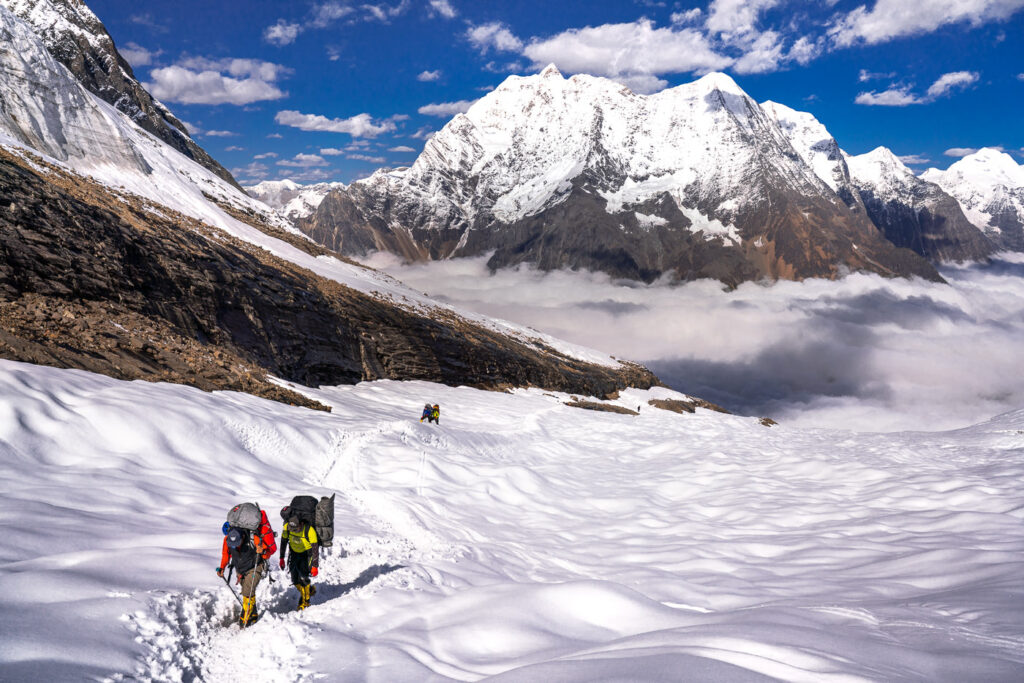
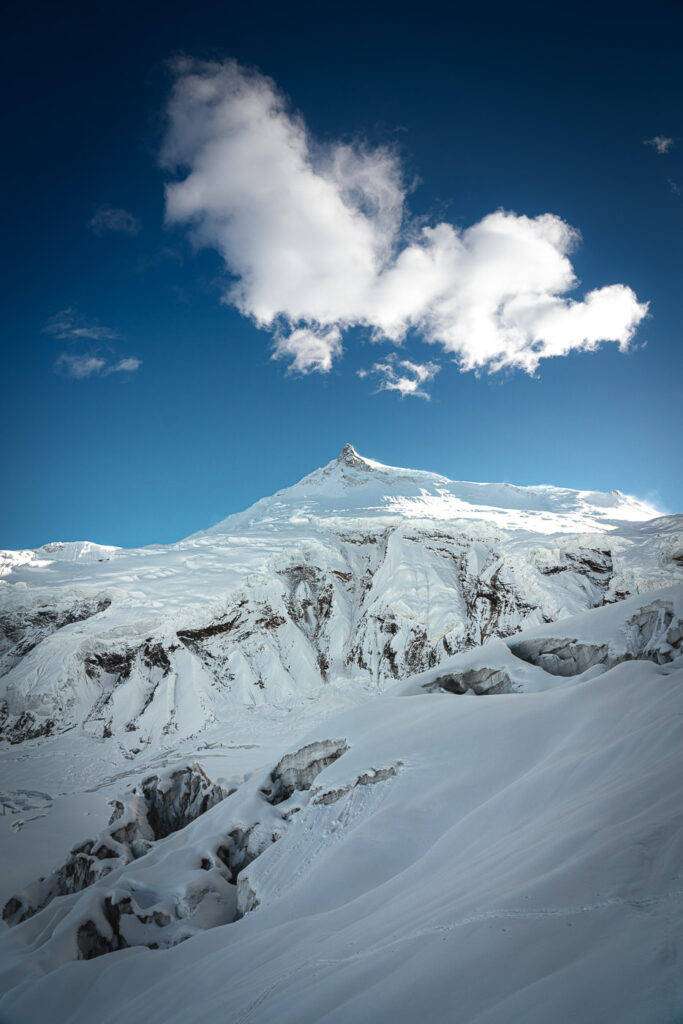
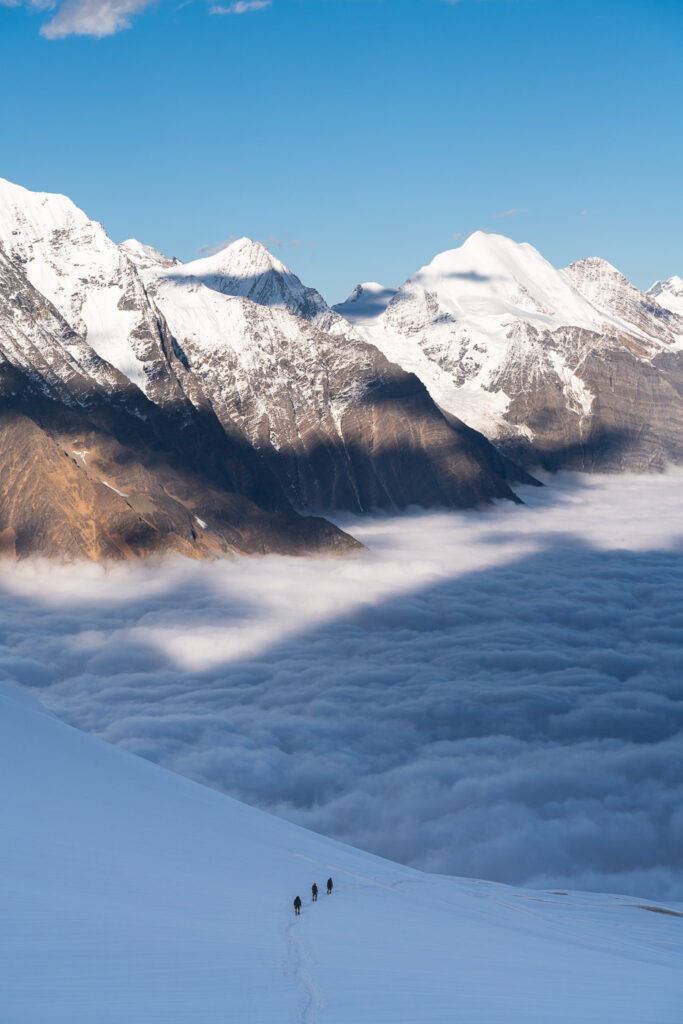
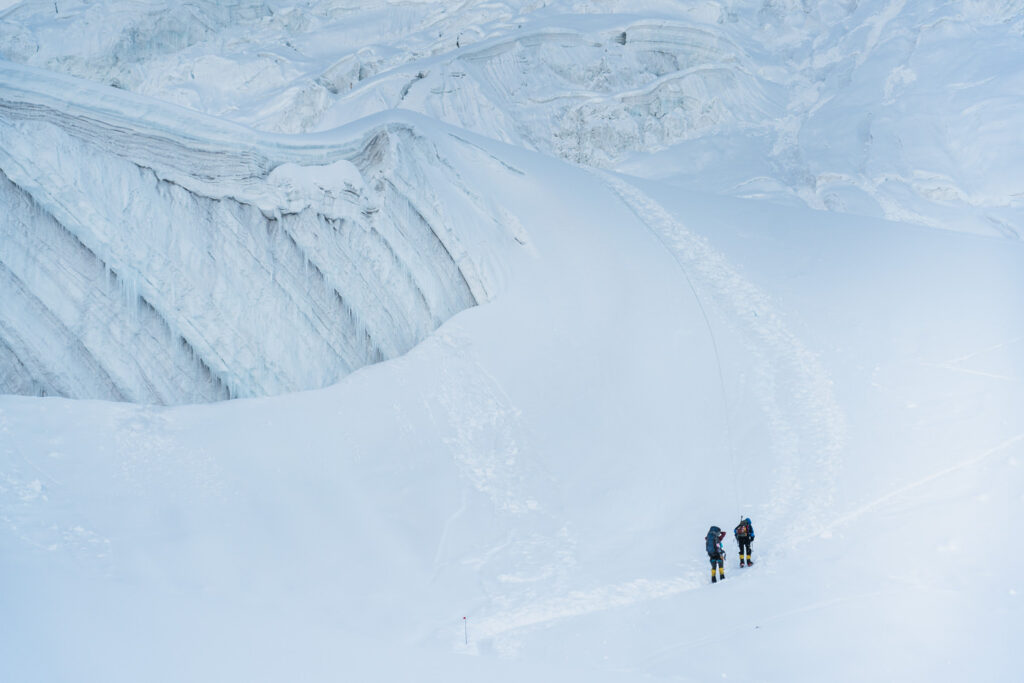
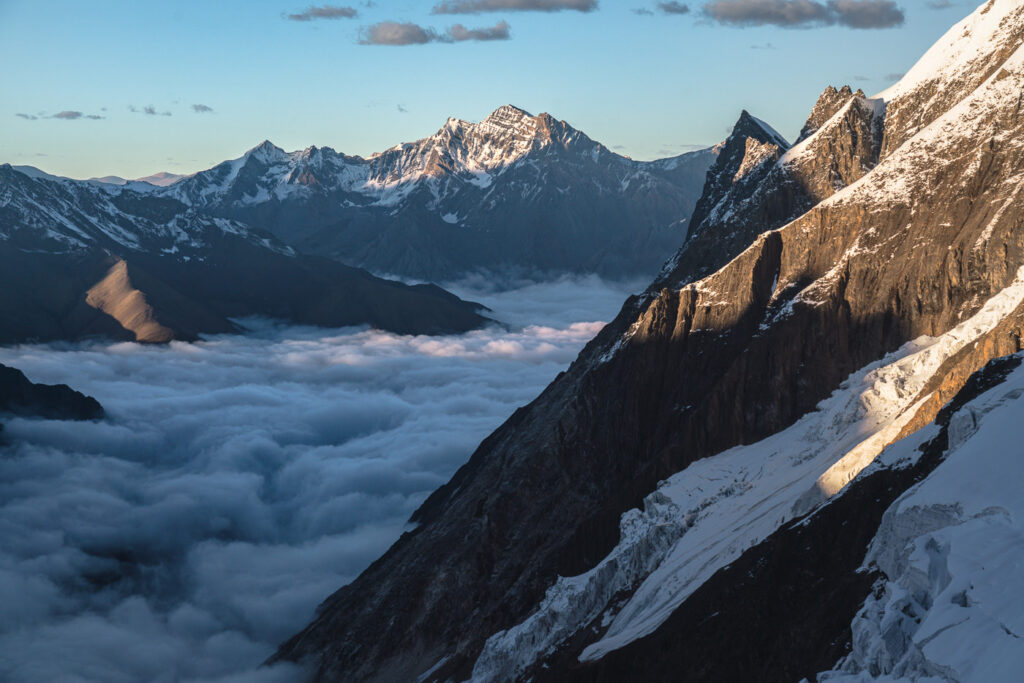
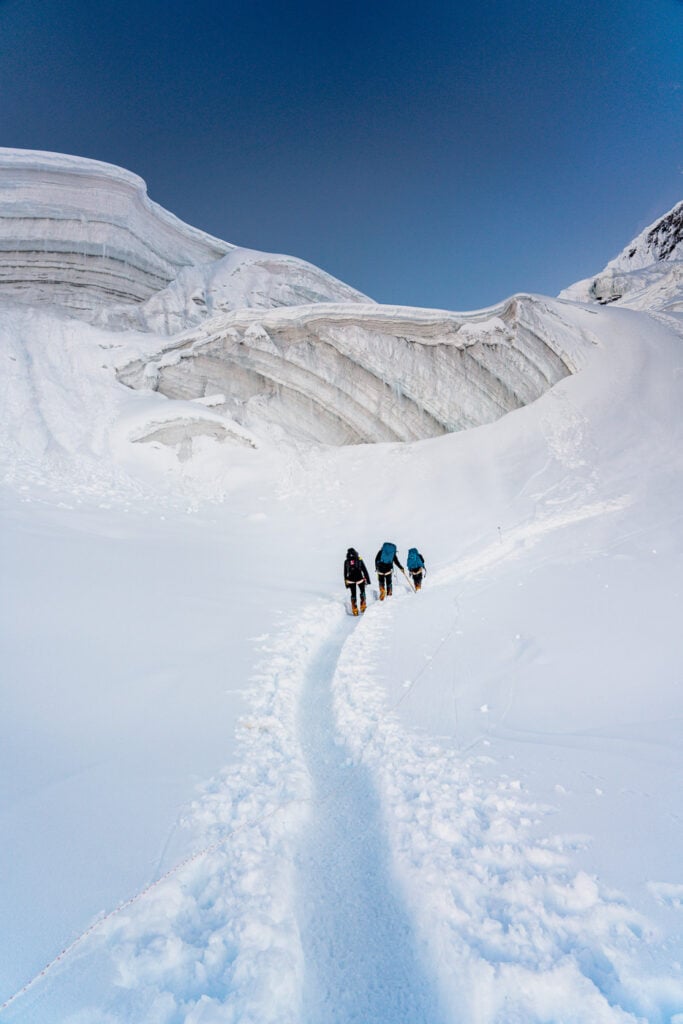
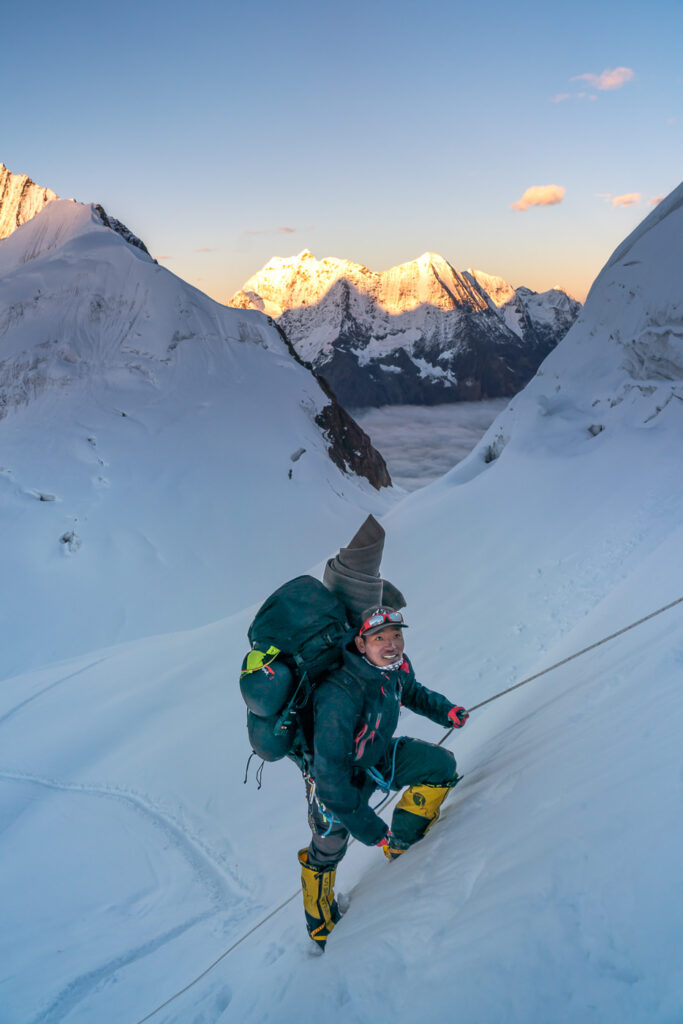
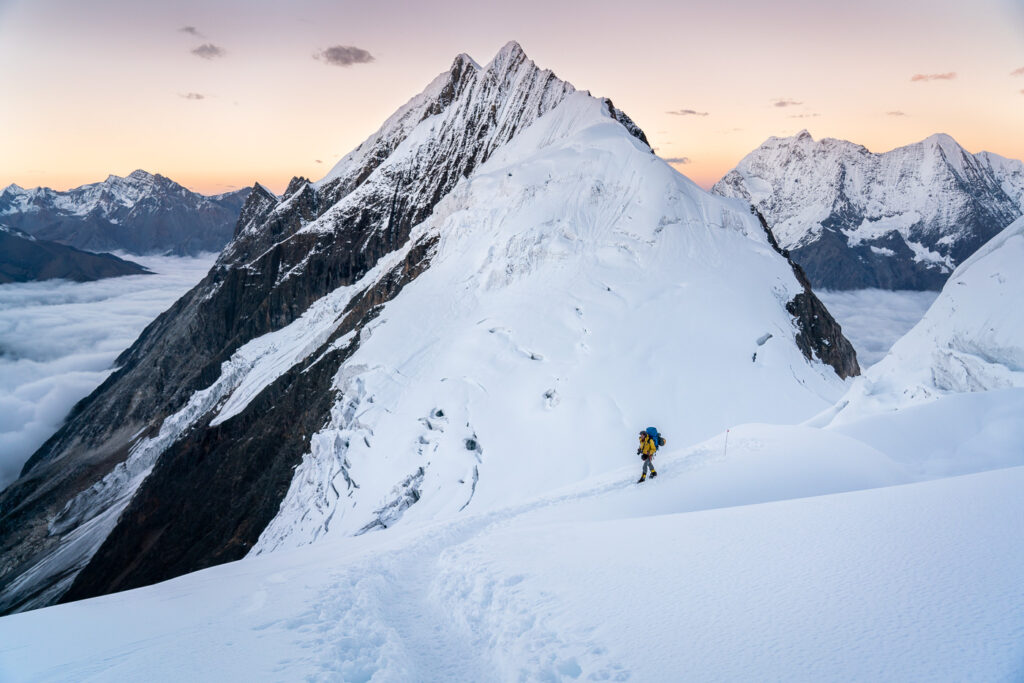
The journey up to Camp 1 was much simpler while we weren’t being pummeled by wet snow and we enjoyed an incredible sunset on the way into camp. The last to arrive, we quickly grabbed some dinner and jumped into our tents to hopefully get some sleep for the night.
As the first light breached the mountains and the tents of Camp 1 began to glow, we took in the buzz of the site. Bright-colored mountain clothes and fluorescent tents painted a colorful scene below the wall of white that towered over us. It was time to join the migration of climbers up through the crevasses of the icefields.
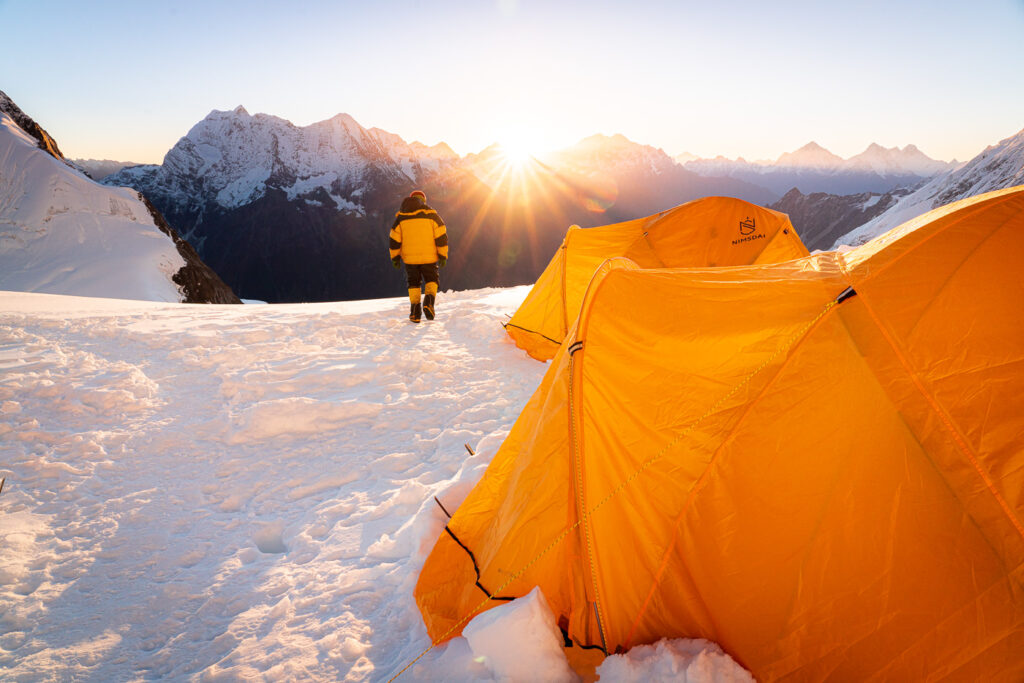
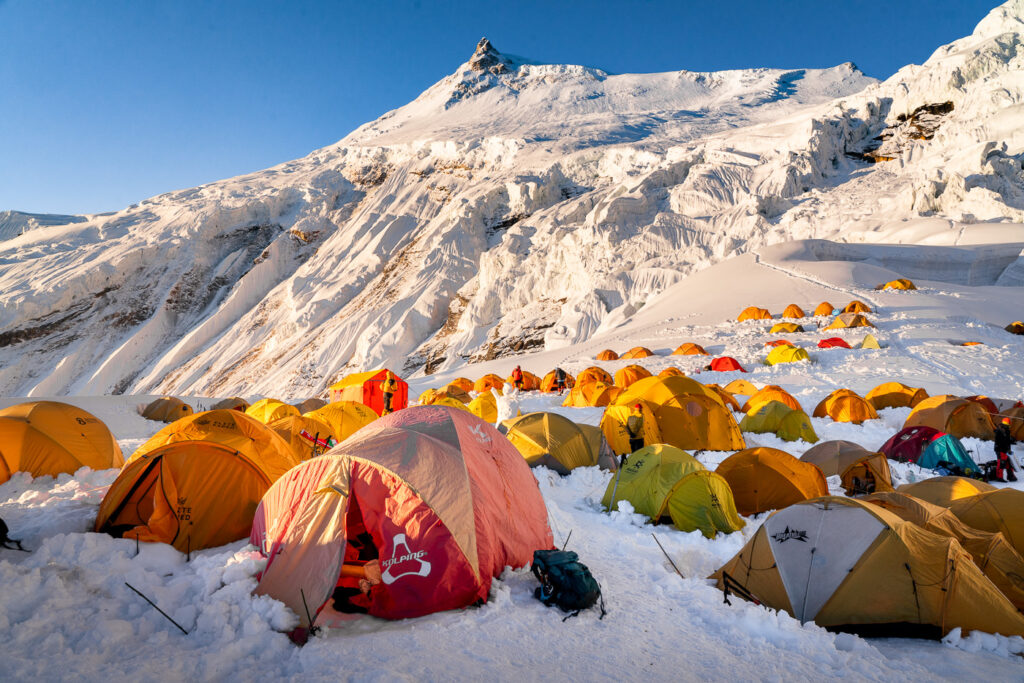
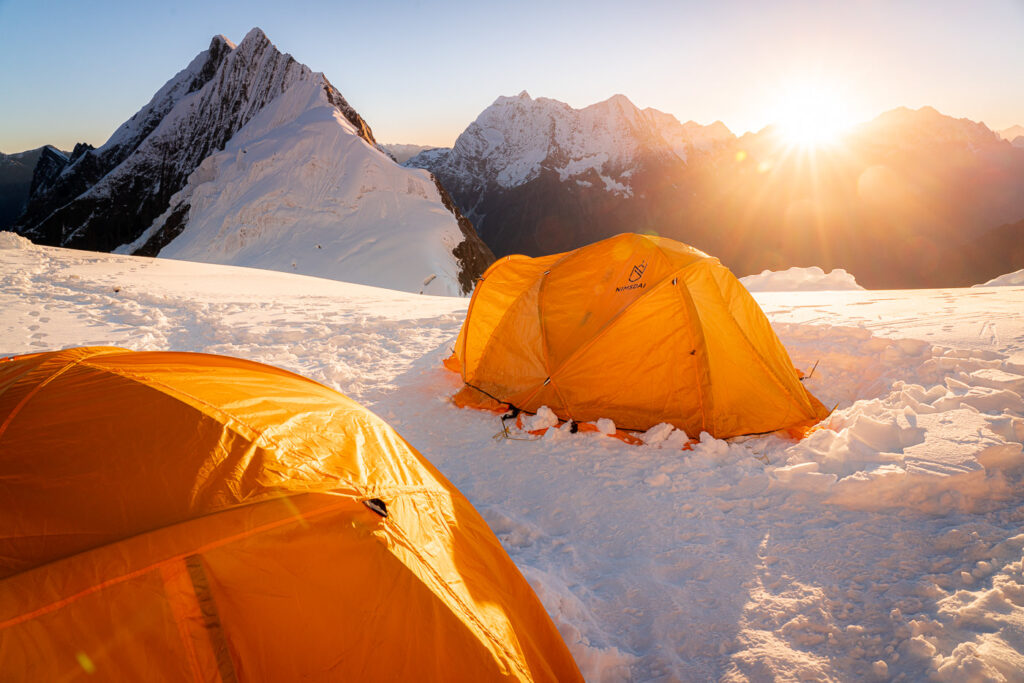
The climb from Camp 1 to Camp 2 is approximately a 600m elevation gain and takes around 3-5 hours depending on the climbing traffic and your condition. It’s quite a short distance but involves a number of technical sections, which can often cause a build-up of climbers with lines not uncommon.
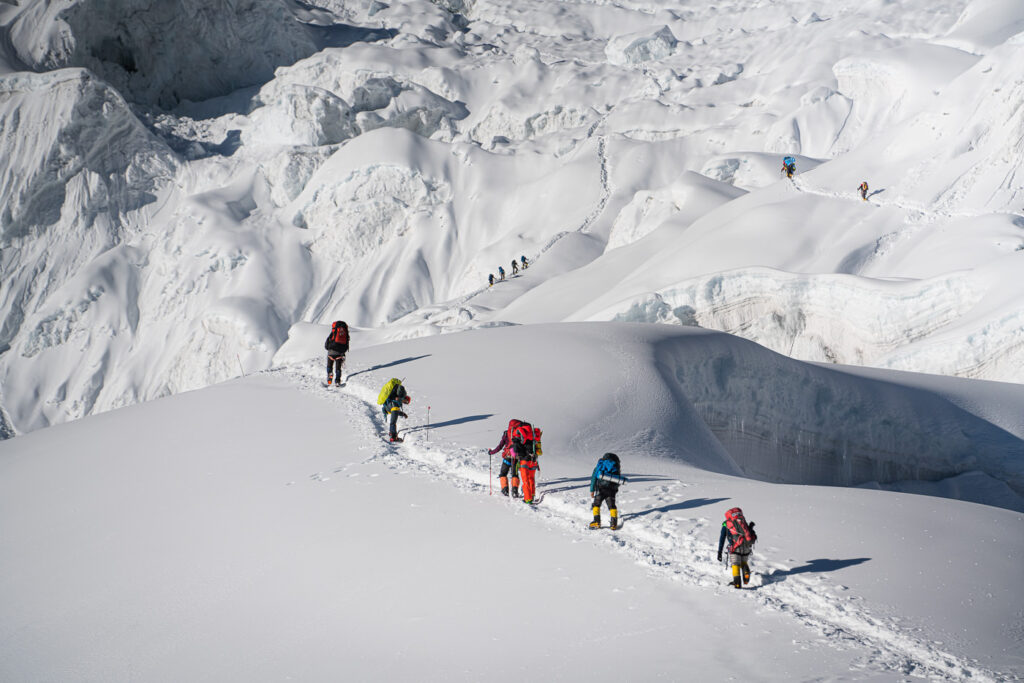
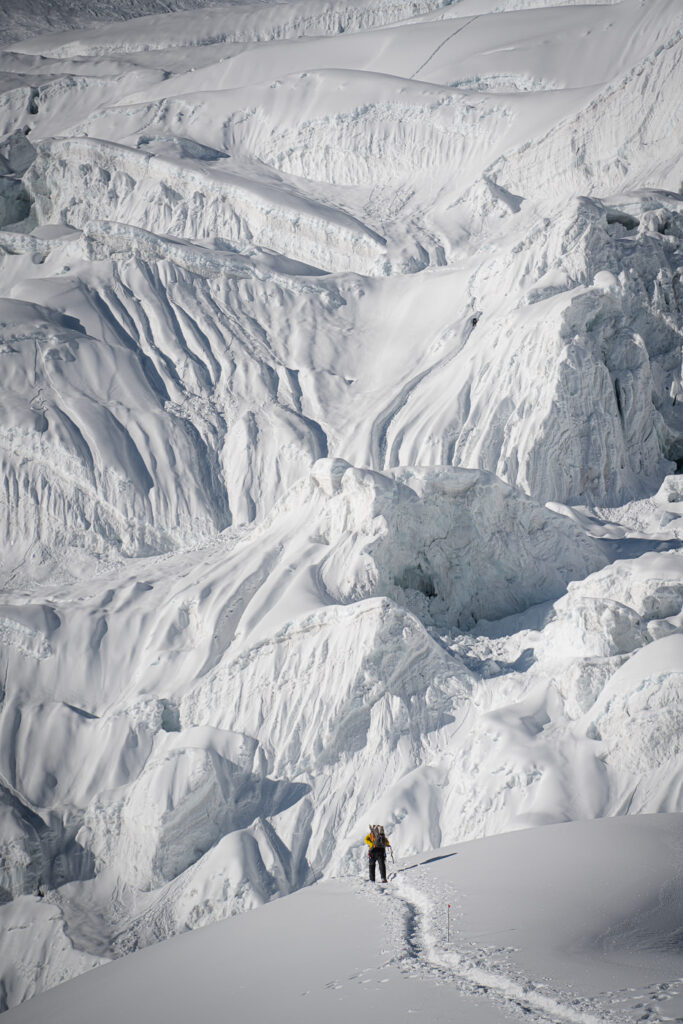
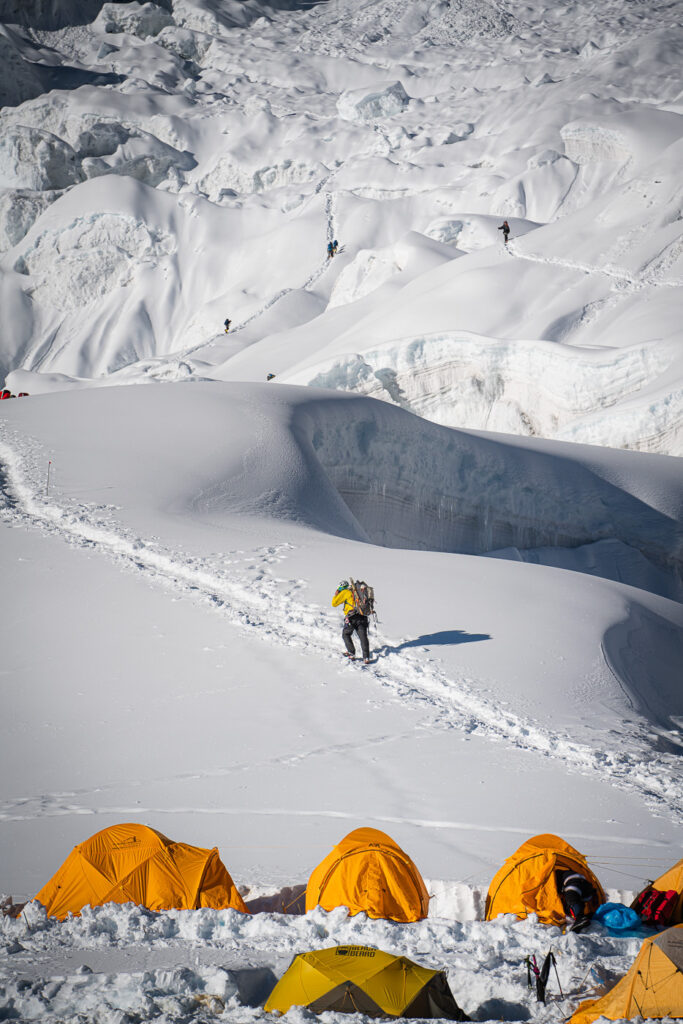
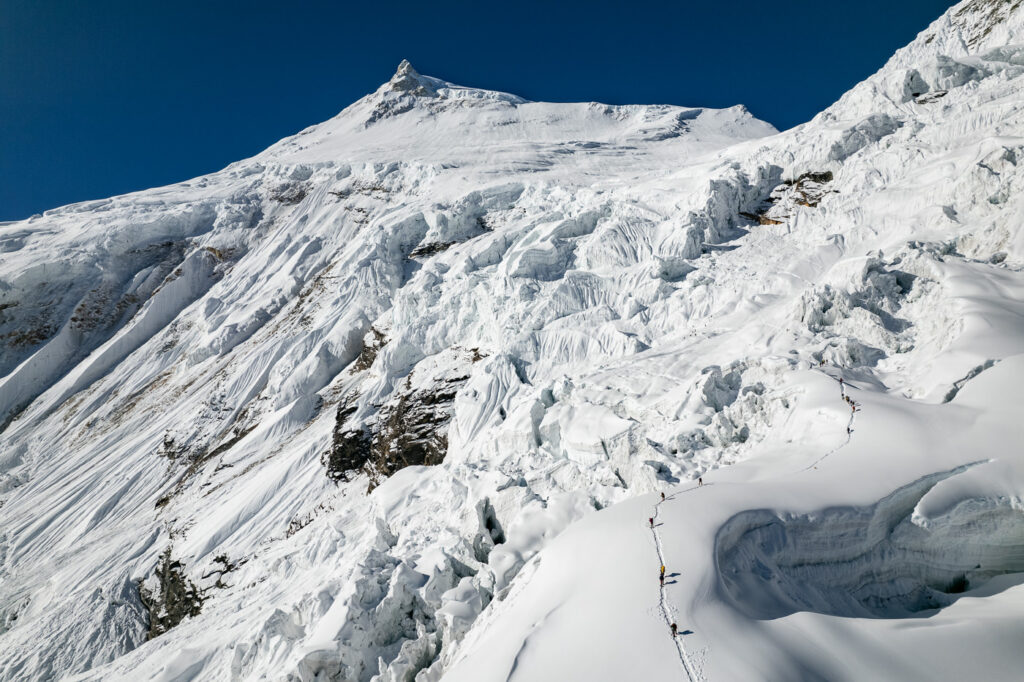
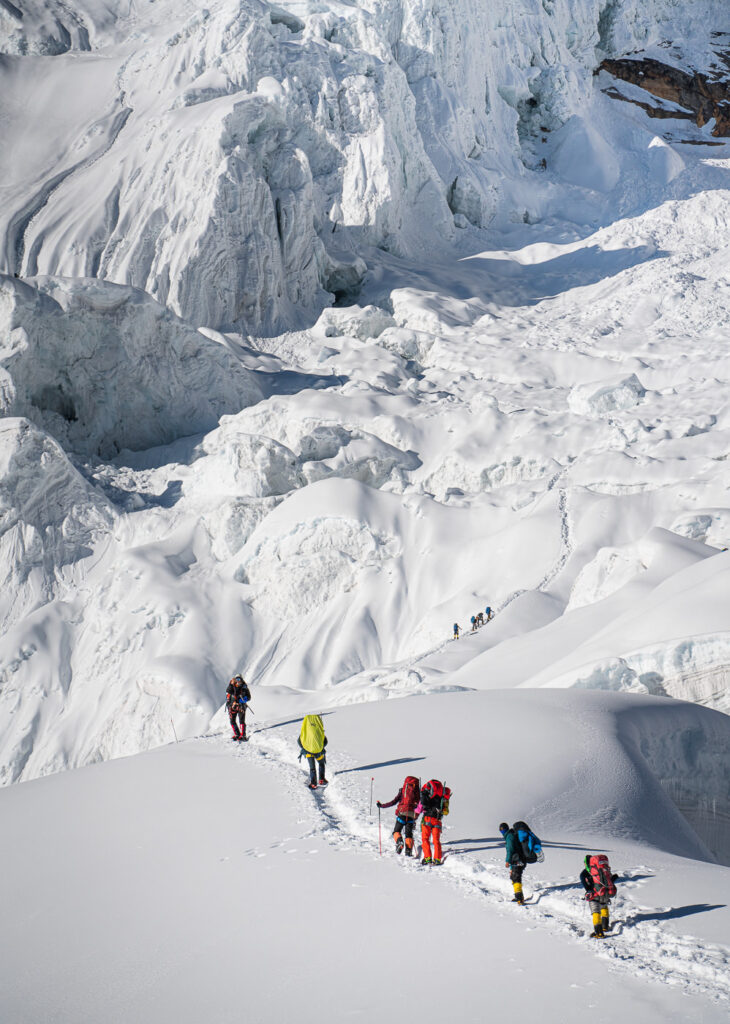
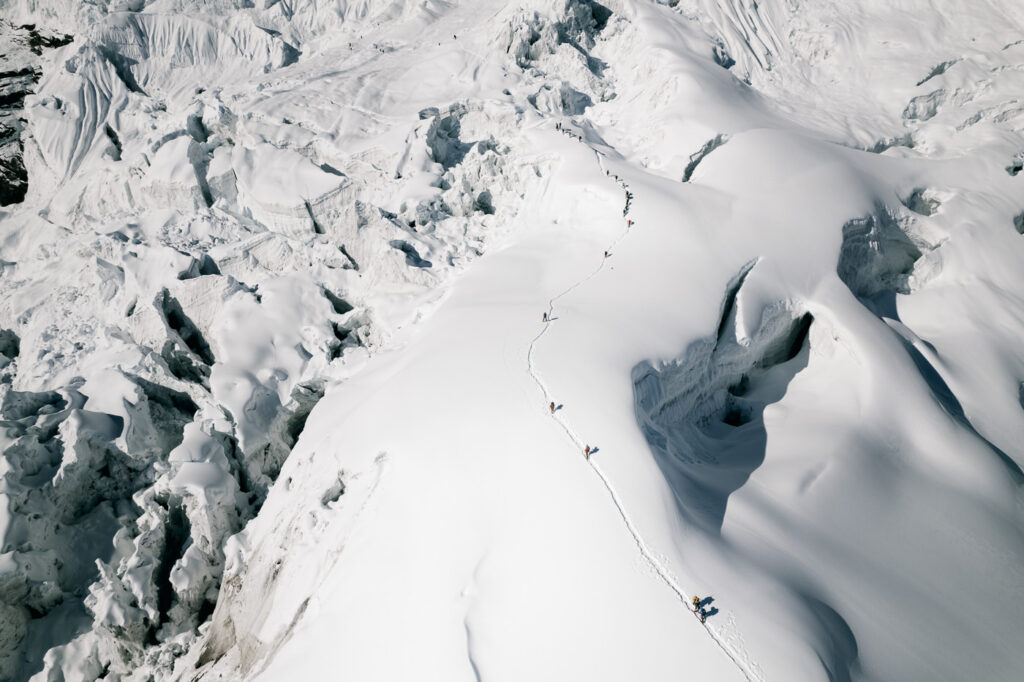
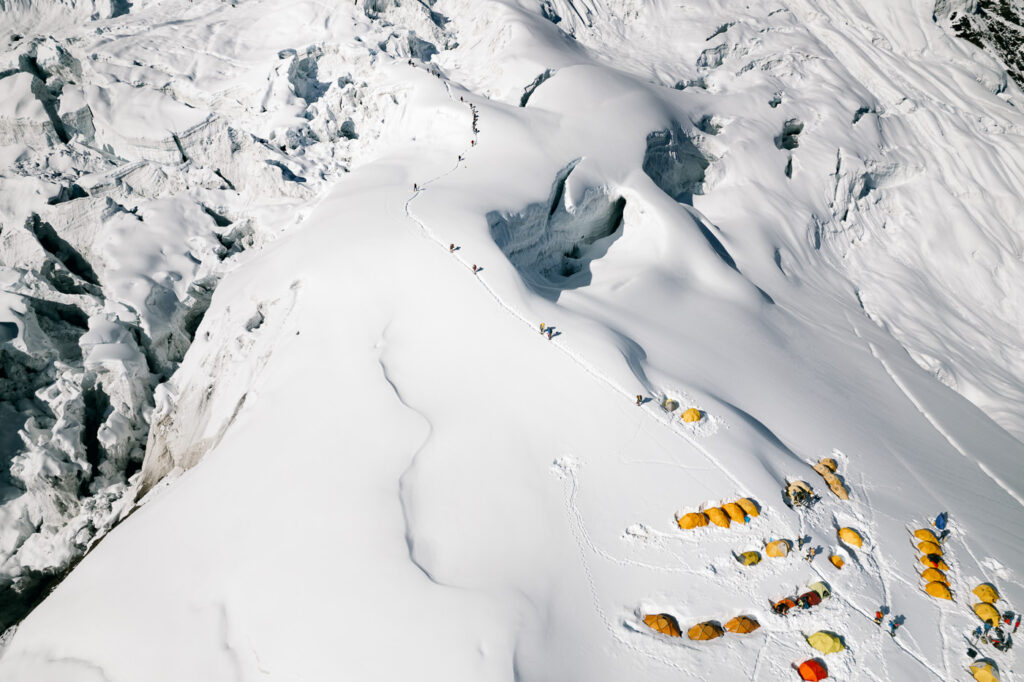
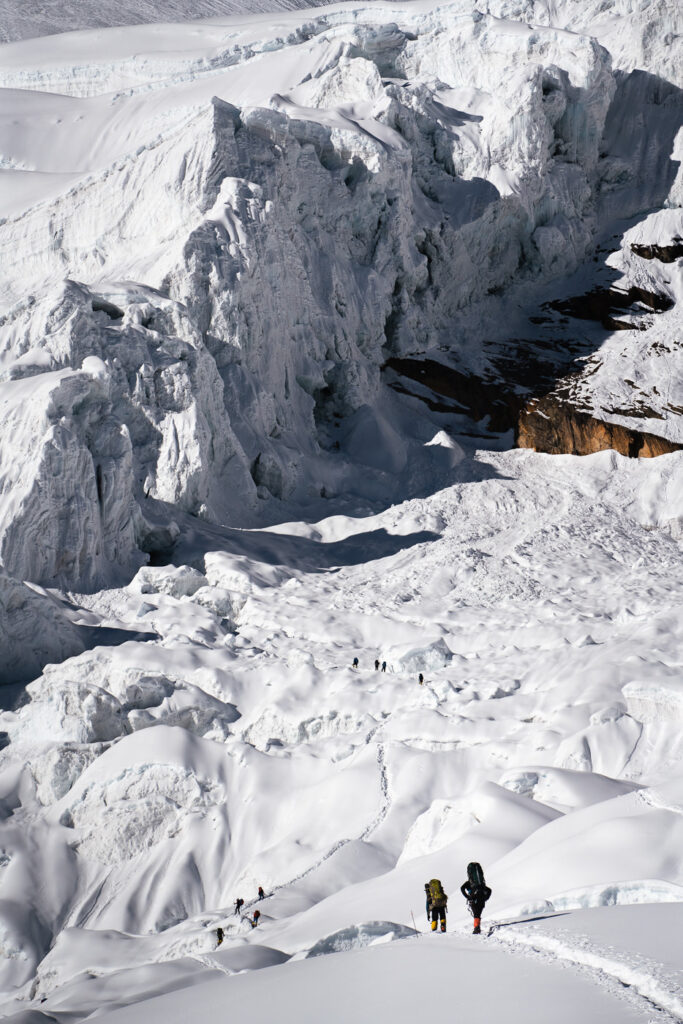
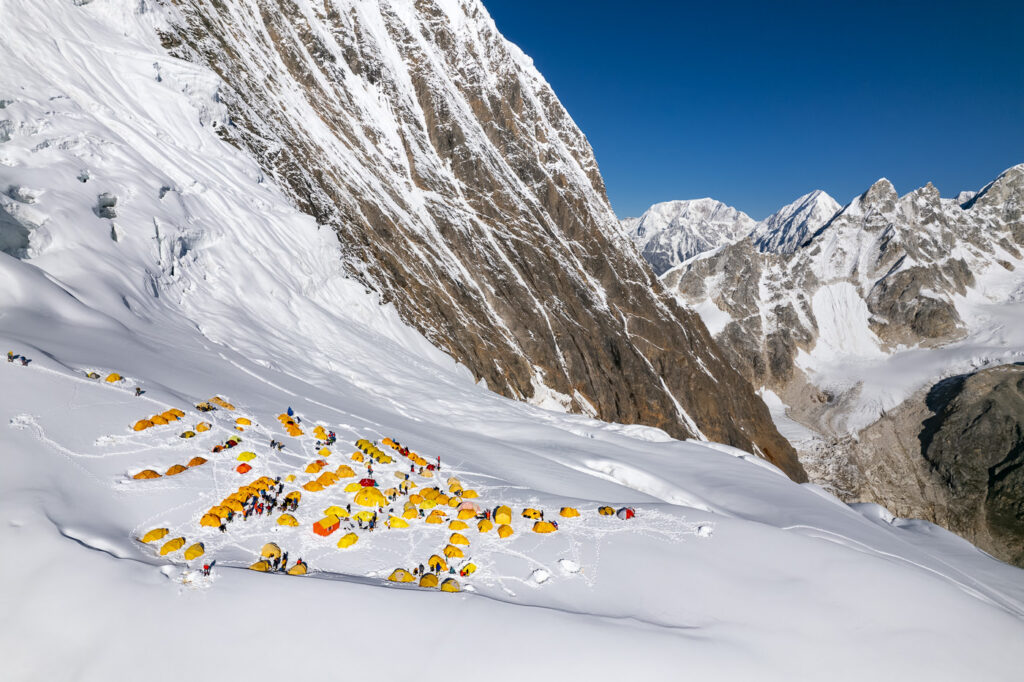
I came into this Manaslu expedition with very little mountaineering experience, having climbed only once before on a 7000m peak in Pakistan. However, I have the good physical condition and lots of mountain experience over the last few years in the form of trekking, scrambling, and hiking. It’s possible to get away with little experience and good physical condition but it’s best to have warmed up with all of the technical skills required.
Along the route to Camp 2, we encountered a number of narrow chutes requiring the use of the jumar. Often the grade was incredibly steep even with some short vertical sections albeit. Other than these few technical sections, the main difficulty of the journey from Camp 1 to Camp 2 is the change in altitude and continuous uphill climbing. Many people were moving quite slowly due to the altitude.
I found the climb quite manageable at the slow pace we took but still found my heart rate increasing considerably. Reaching Camp 2 in the late afternoon was a welcome end to the day for me as our team set up the tents and we settled in and dumped our gear.
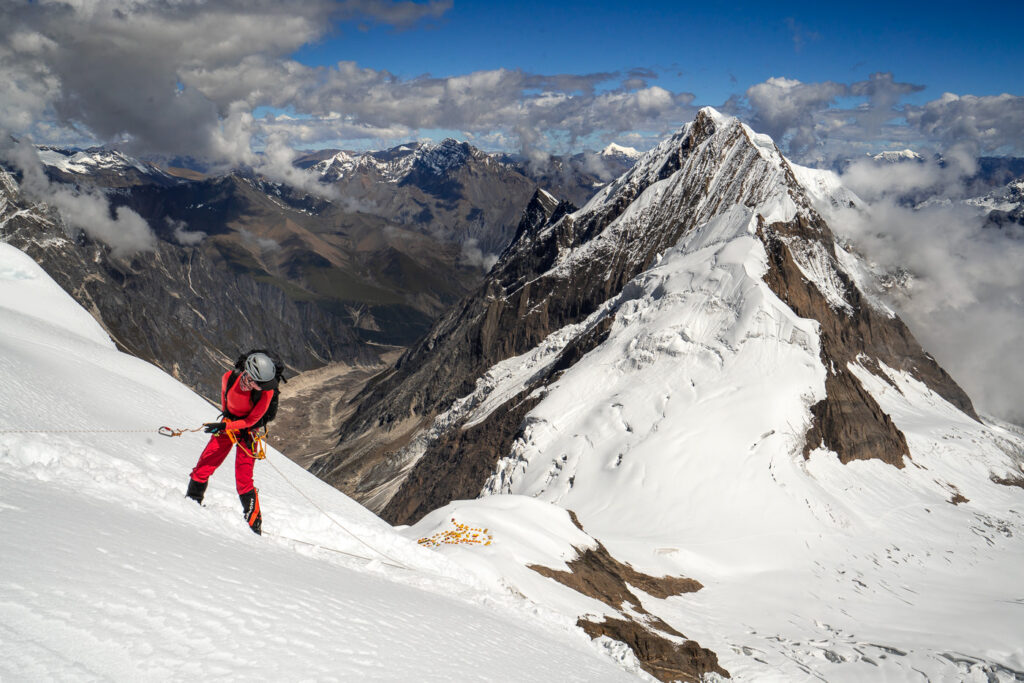
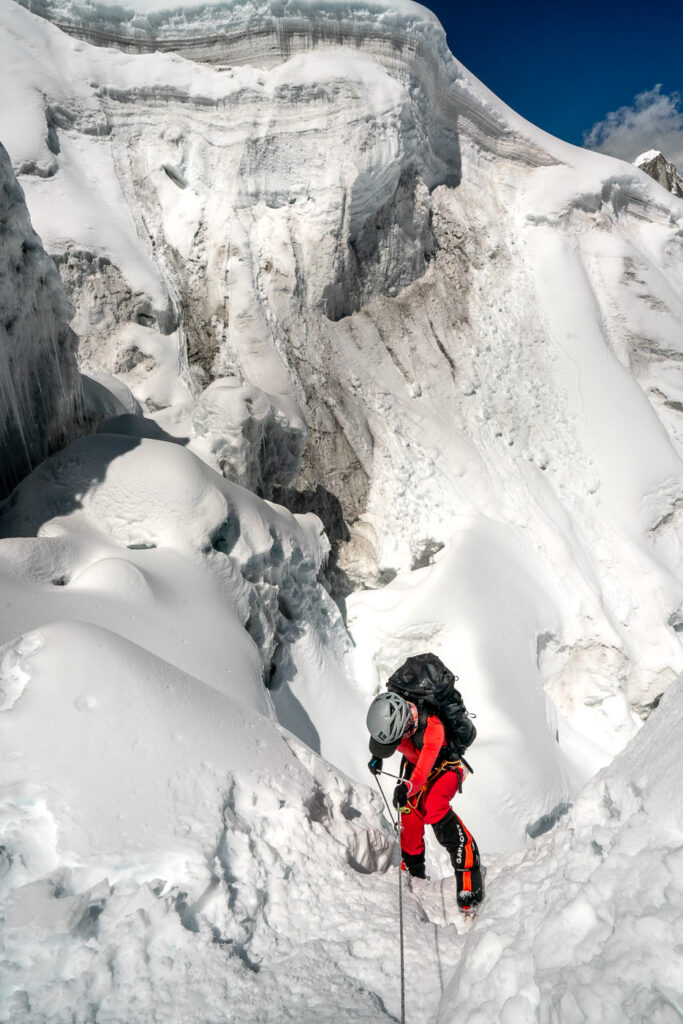
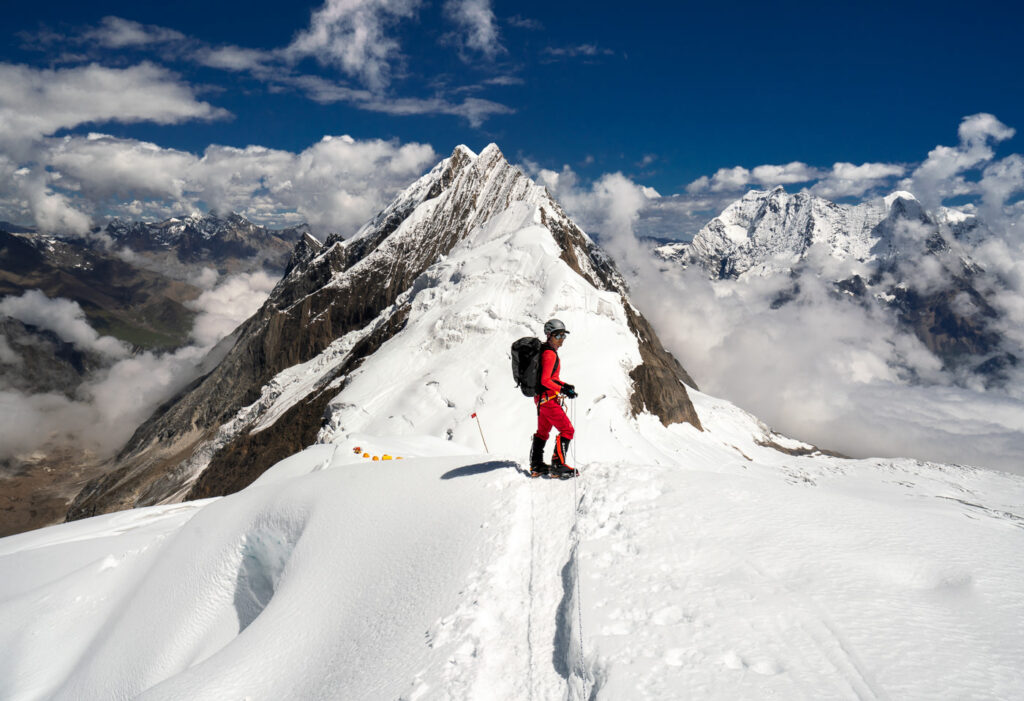

The final event of the day was the sunset. Camp 2 looks down over Camp 1 and even to base camp. A sea of clouds filled the valleys between the ridges and created an ethereal atmosphere amongst the mountains. Taking your gloves off for photography at 6400m is not recommended and was a lesson learned but I managed to snap some pretty magical shots, including some of the full moons during sunset.

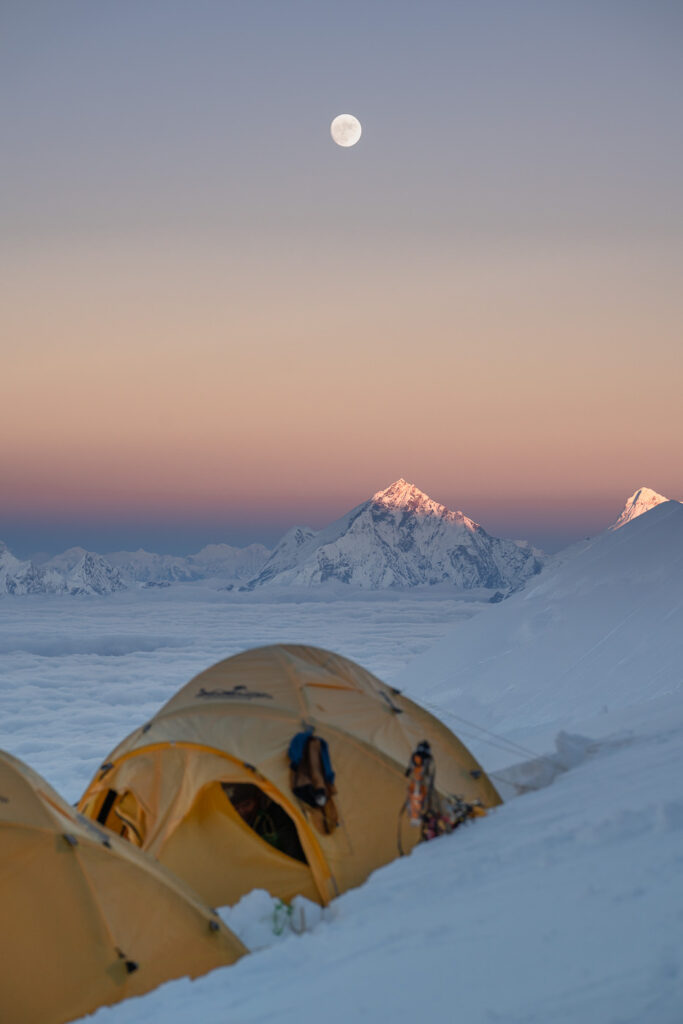
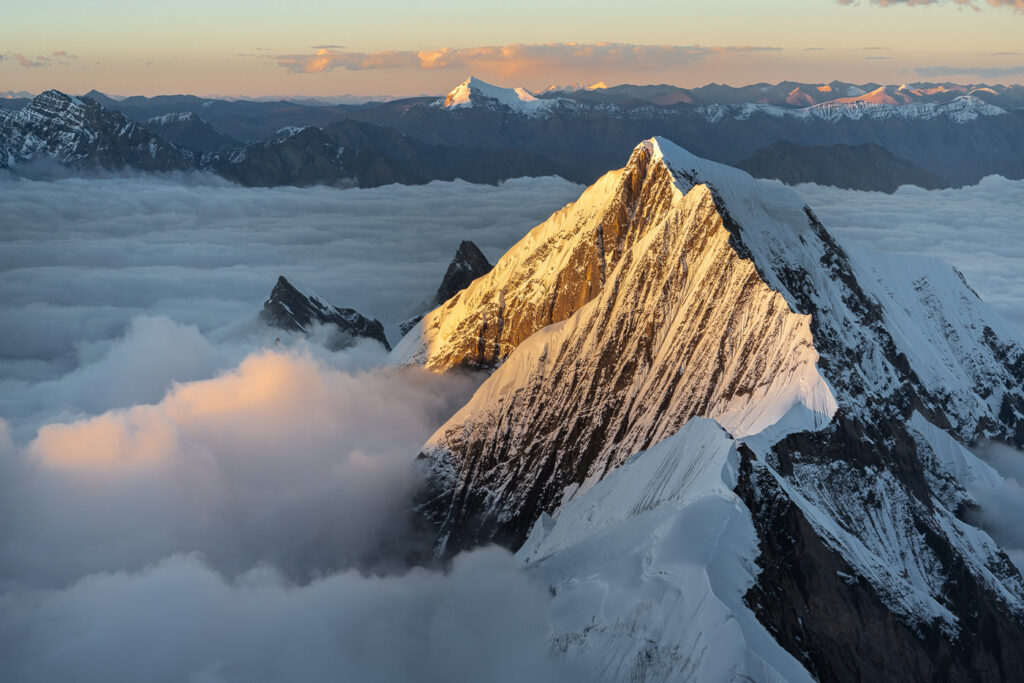
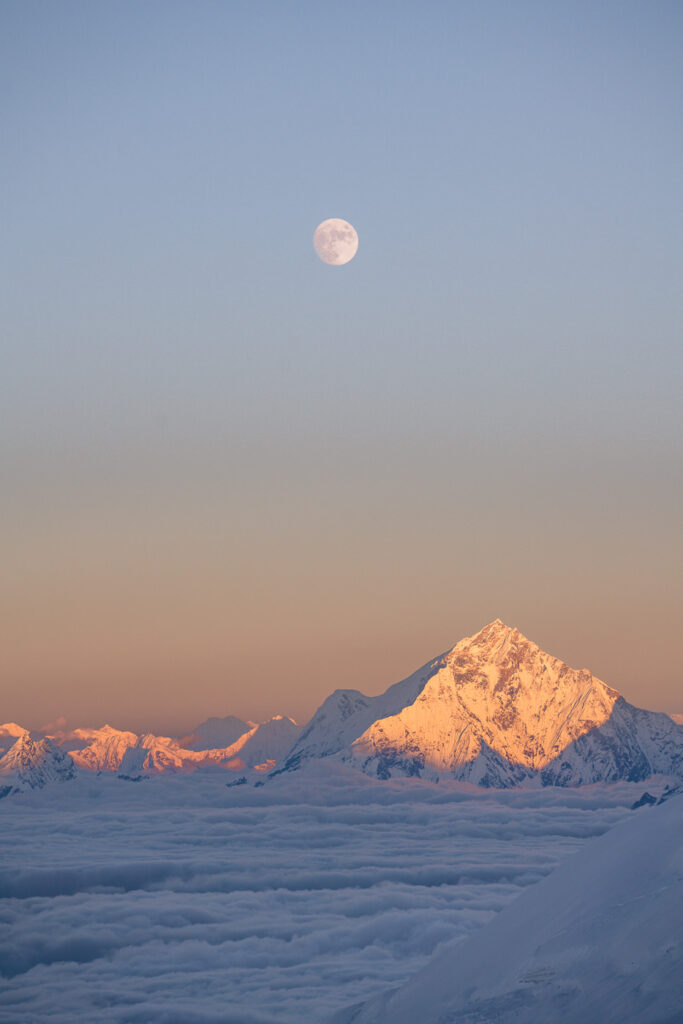
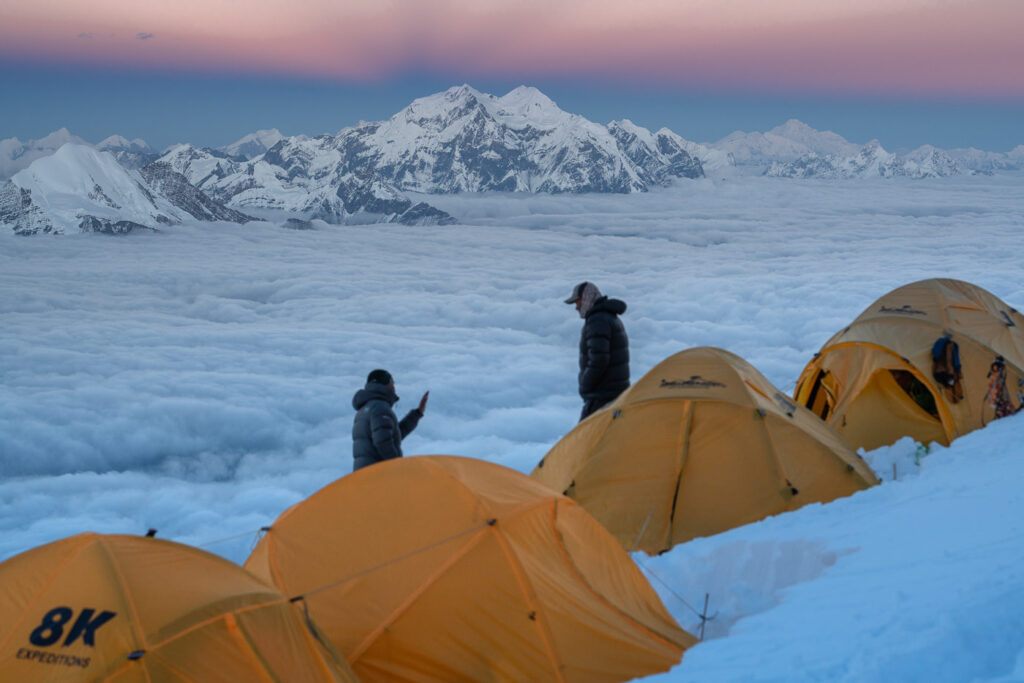
Unlike many, I actually managed to sleep quite well. After passing the 6000m mark, many climbers tend to have difficulty sleeping. I think I banked about nine hours before waking up to watch the sunrise over the mountains on the horizon. I felt privileged to be there and motivated to reach the summit.
After courteously waiting an hour after sunrise for most of the climbers to wake up, I sent the drone up to capture some images of Camp 2 from the sky and they ended up being some of my favorite stills from this expedition. I hoped to continue the consistent shooting as the climbing got tougher, the breathing would become harder and hands would get colder.
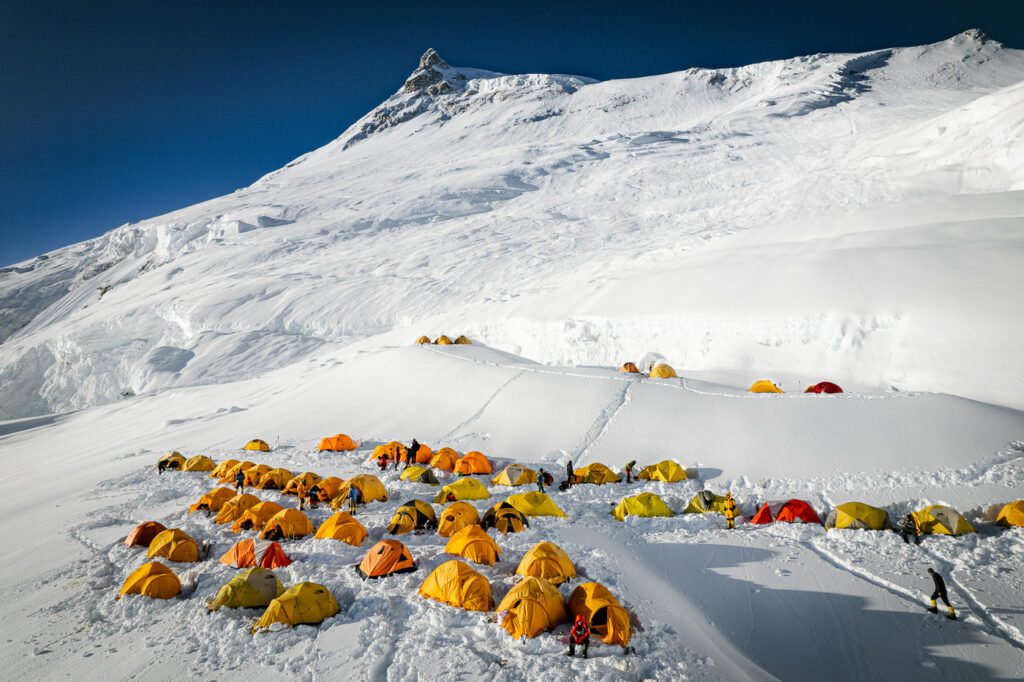
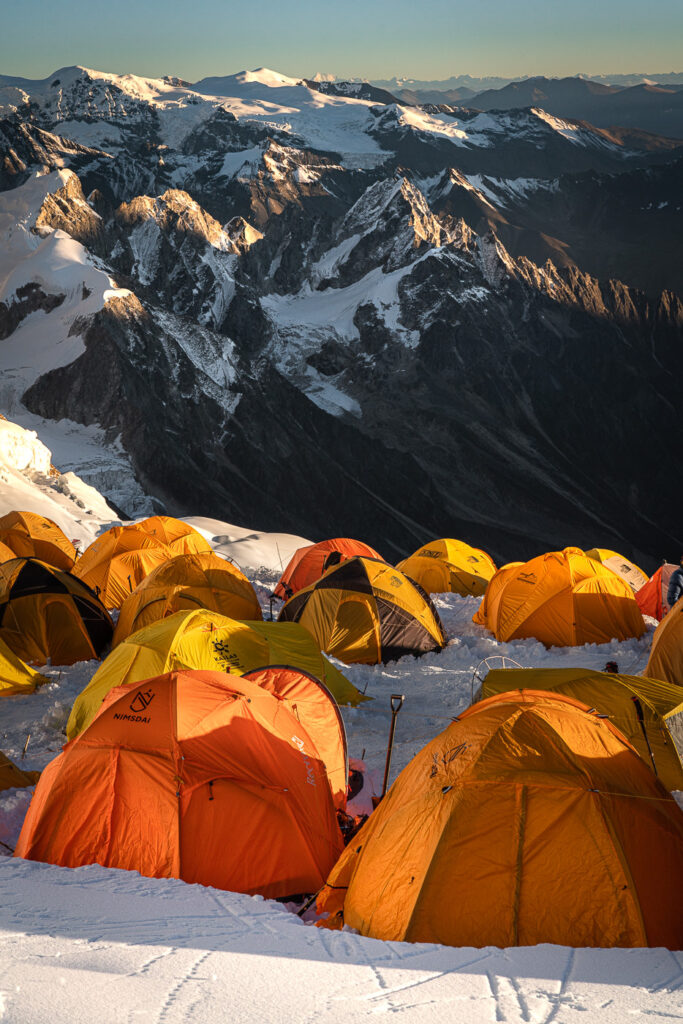

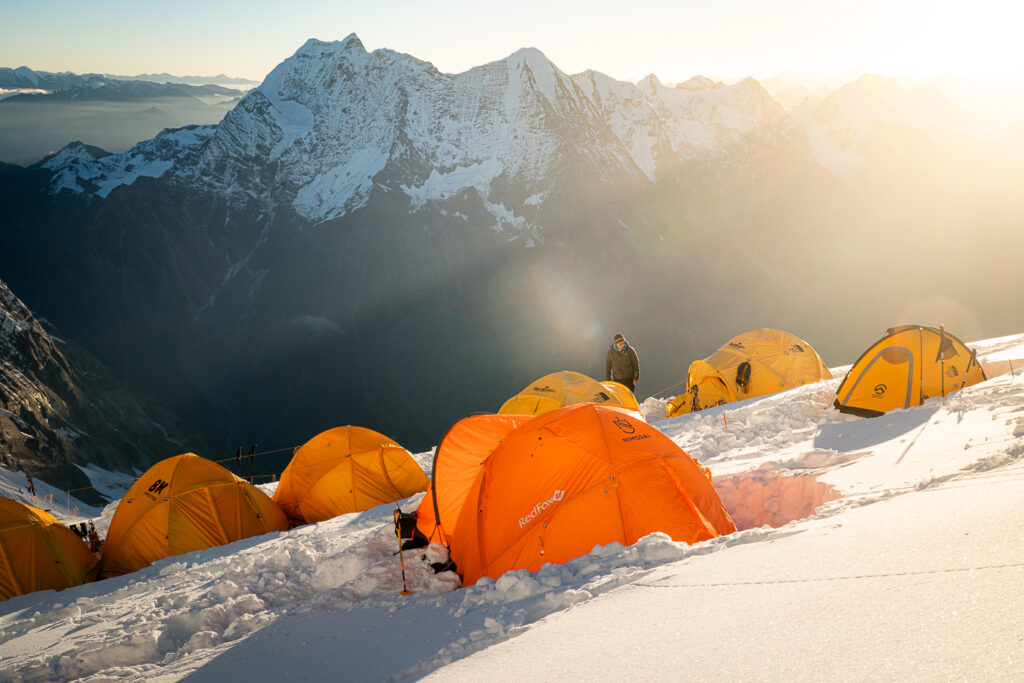
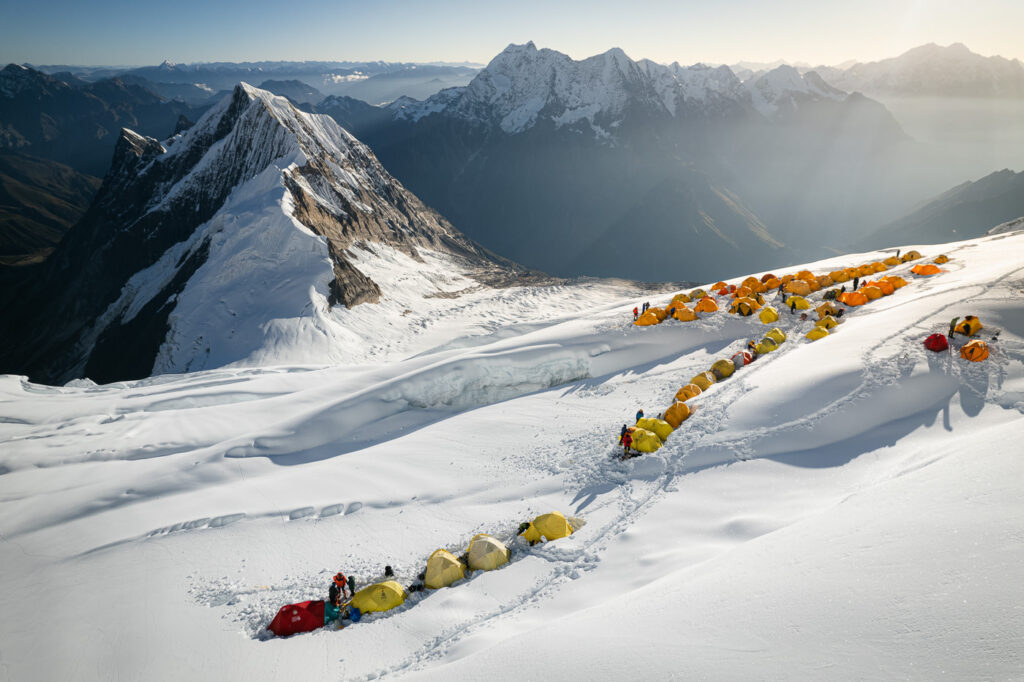
Pema woke up with a bout of altitude sickness but we still had a job to do and that was to turn back down the mountain to return to base camp. The two others in our group who were trying to climb without oxygen would sleep up at Camp 3. The journey down was a bit slow as traffic jams again caused some delays. It caused the expedition to feel a little less adventurous at times but that’s how it goes on popular mountains sometimes.
Coming down from Camp 2 was a chance to practice abseiling and descending down some of the steep, snowy slopes that were now beginning to become quite slushy. The entire route down took us three and a half hours although we went very slowly and had a number of delays. I think it may take just three hours to come down from Camp 3 when there is no traffic.
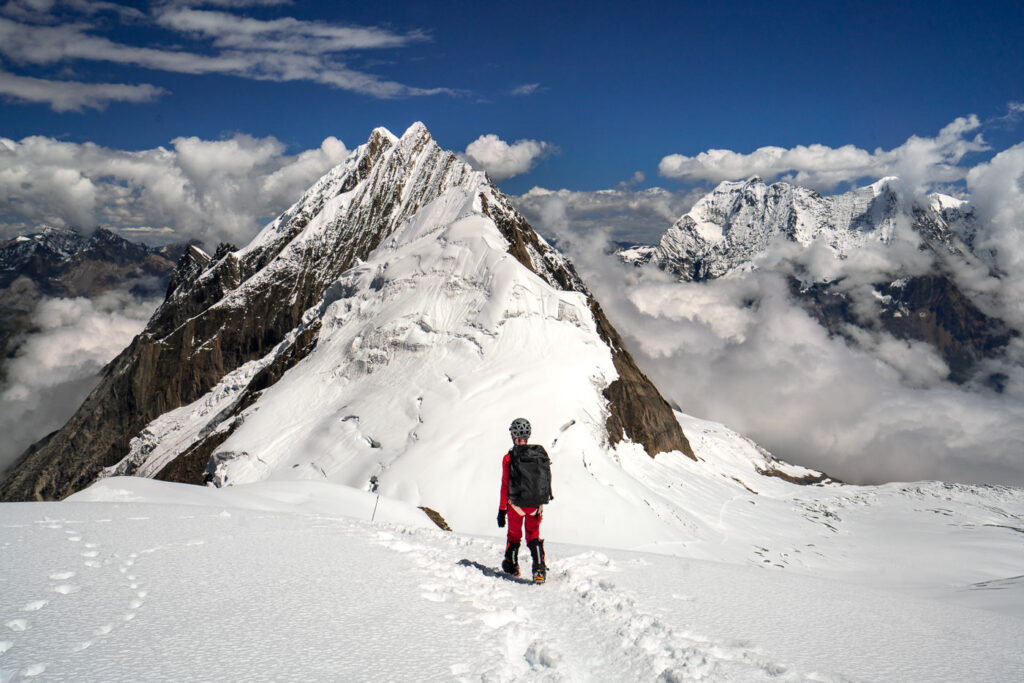
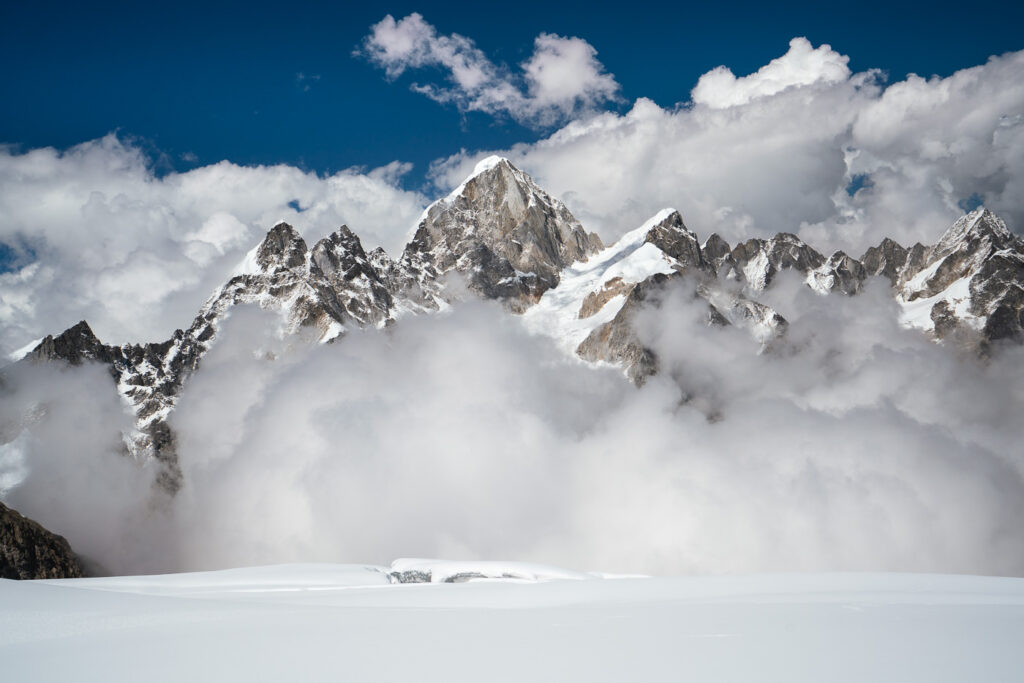
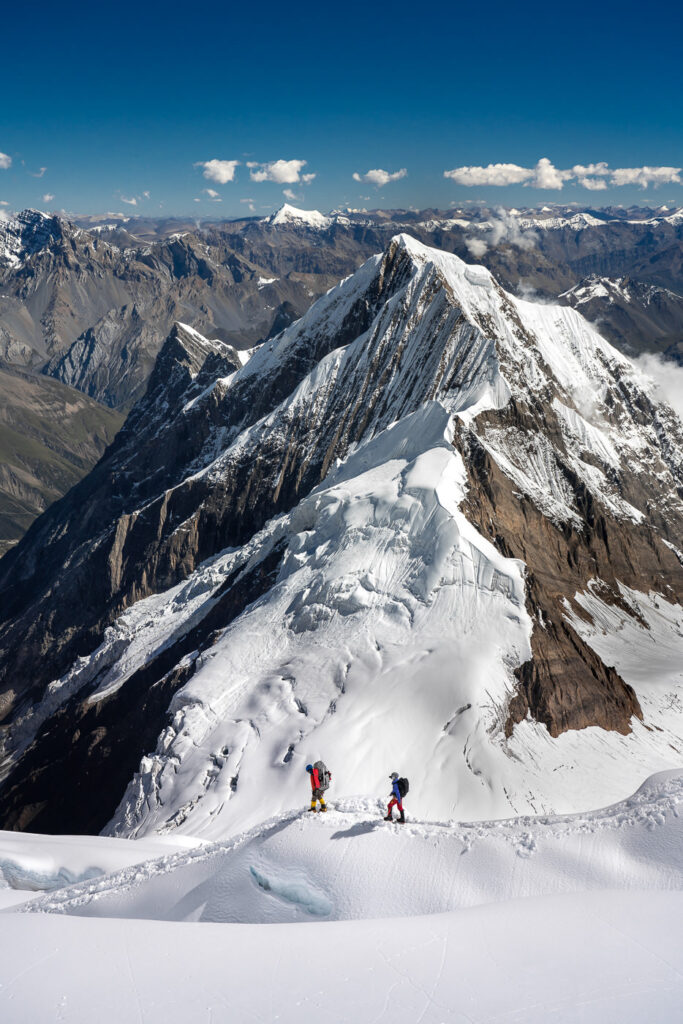
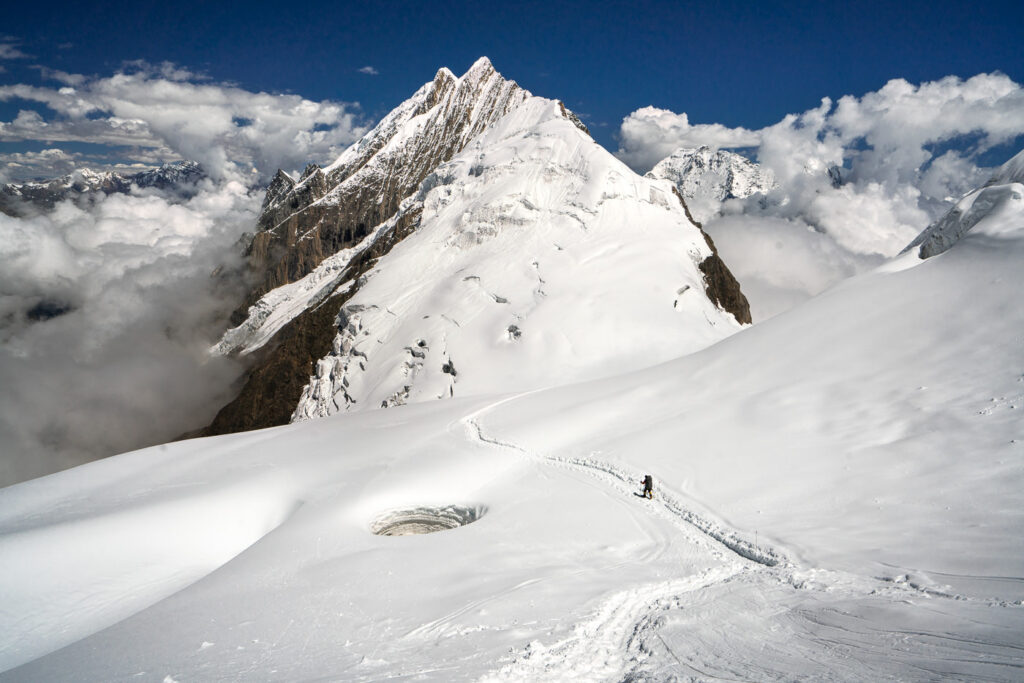
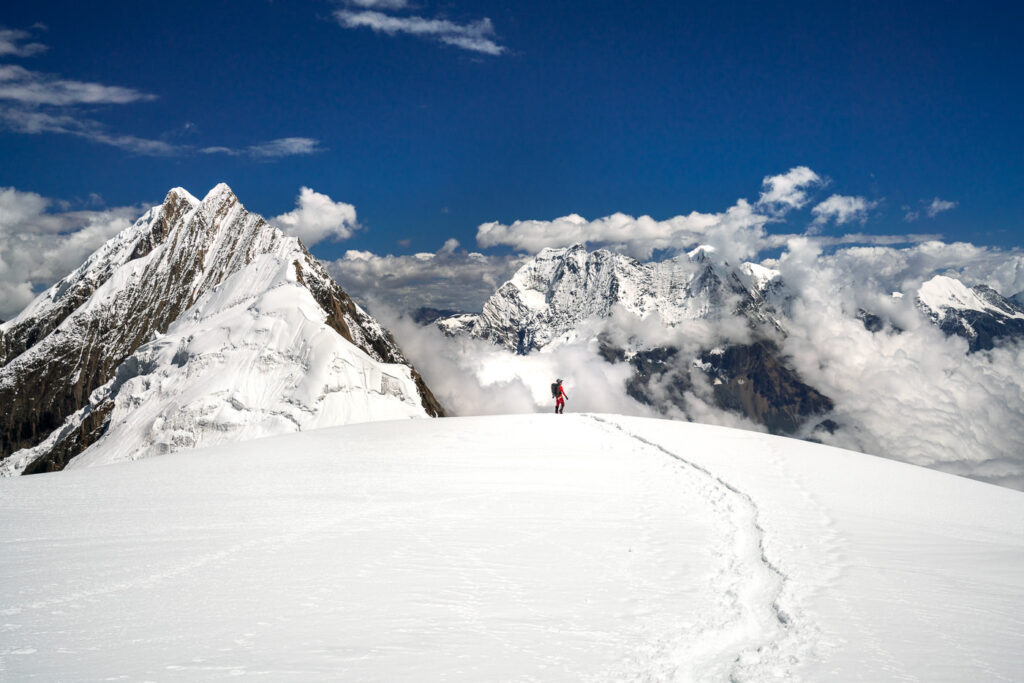
Arriving back at base camp in the early afternoon was a great feeling. We had now completed our second rotation and all things seemed to be going to plan. I was feeling in good health and had no major physical concerns.
The plan was to sit tight at base camp and wait for the appropriate weather window, which seemed to be in a few days’ time. This gave us plenty of recovery and a chance to catch up on editing some photos, writing this article, and letting our bodies recover from the altitude before our next venture up to a higher altitude.
A couple of days at basecamp to sit idle served us well. Clouds, rain, and snow passed through intermittently until our summit window appeared and we were told to pack and get ready for our Manaslu summit push. Our plan was to sleep at Camp 1, Camp 3, and Camp 4 and then come all the way back down to base camp on the same day as we summited.
Heading back up to Camp 1 felt like a route I knew well by now. It was my third time and the easiest climb up to the first camp of Manaslu with favorable weather conditions. The first climb was a snowstorm and the second climb was searingly hot. This time, the journey from base camp to Camp 1 was in overcast conditions and at a very slow pace, we traversed our way through the crevasses to reach our sleeping station for the night in four hours.
We woke to snowed-over tents and a quiet buzz in the air. Slowly the crisp snow fell off the tents to reveal a colorful garden of temporary homes beneath the towering wall of white snow. Our journey to Camp 3 would be a long, hard day. The route included numerous technical sections of jumar, crevasses, ladders, and steep inclines. Most of our team took 6-7 hours to reach Camp 3.
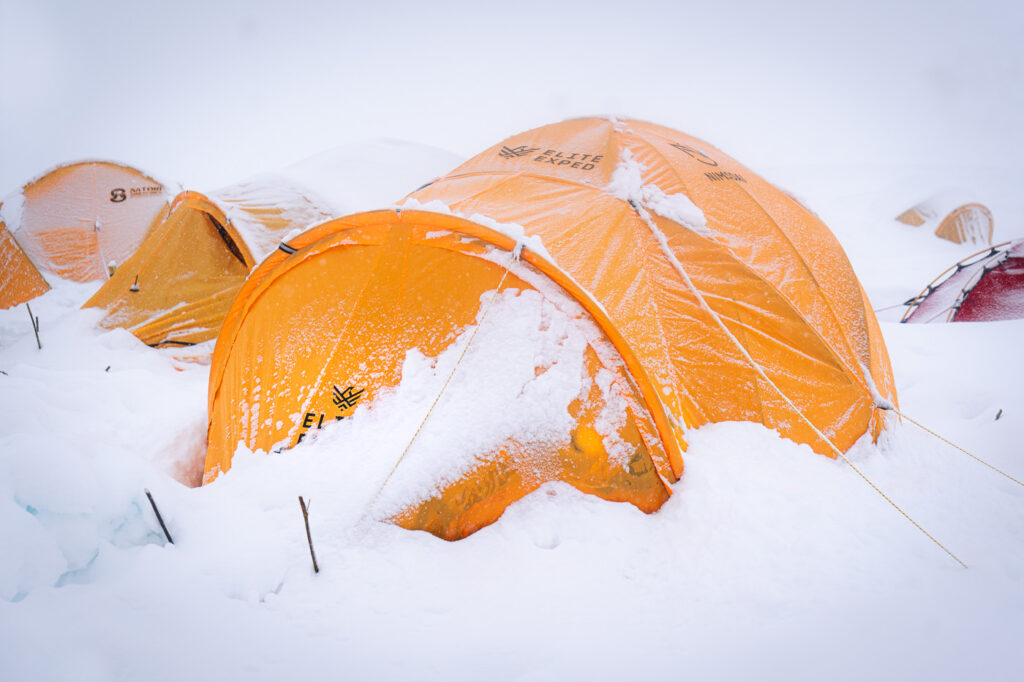
This was a tough day for me. I had never touched Camp 3, so climbing up all the way from Camp 1 in a single day applied a lot of pressure on my body. Camp 3 is almost at 7000m and I developed a slight headache and some stomach issues that gave me quite a battle through the night, even with some vomiting outside of the tent.
Luckily, the plan was to get started on the oxygen in the morning for the climb to Camp 4, which was at 7,400m. As we left Camp 3, I did my best to keep shooting despite the heavy fog and blizzard conditions and my weakened state. What I didn’t know is that this is one of the most beautiful campsites on the route, we just couldn’t see further than a few meters. On the way back down from the summit, it was clear as day and I could appreciate the backdrop of Camp 3.
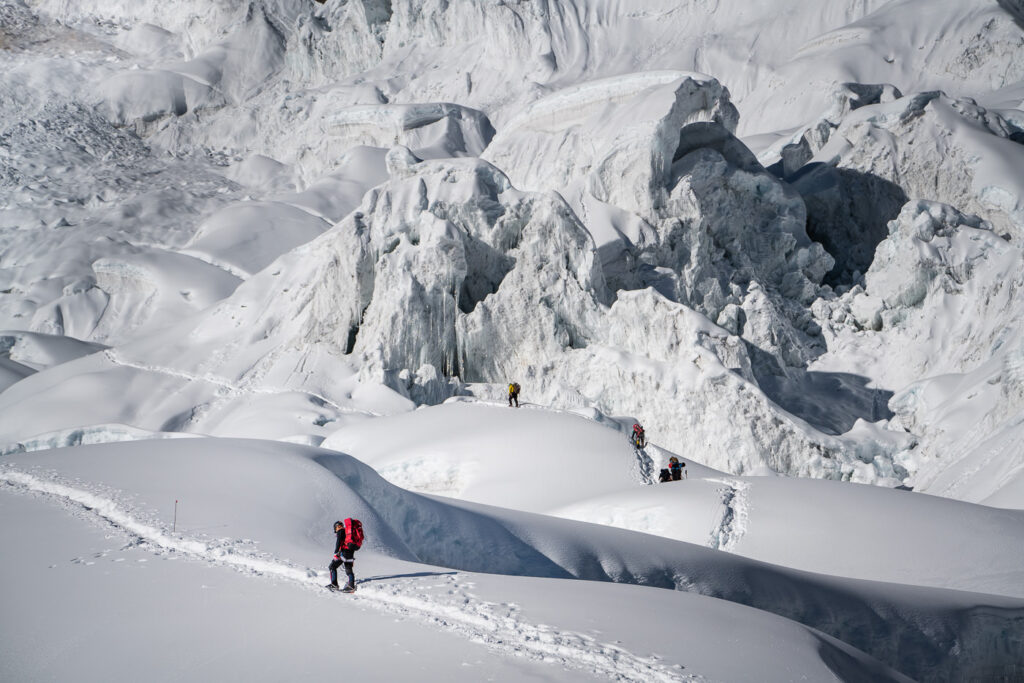
From Camp 3 to Camp 4, there weren’t too many technical sections to encounter. Instead, it felt like a very slow, long slog up an extremely steep slope. There was no express route, just a slow trudge, ascending upon an aggressive angle with a long line of other climbers. This was a mentally challenging day as you could see exactly where you were headed and it seemed as if it would take forever.
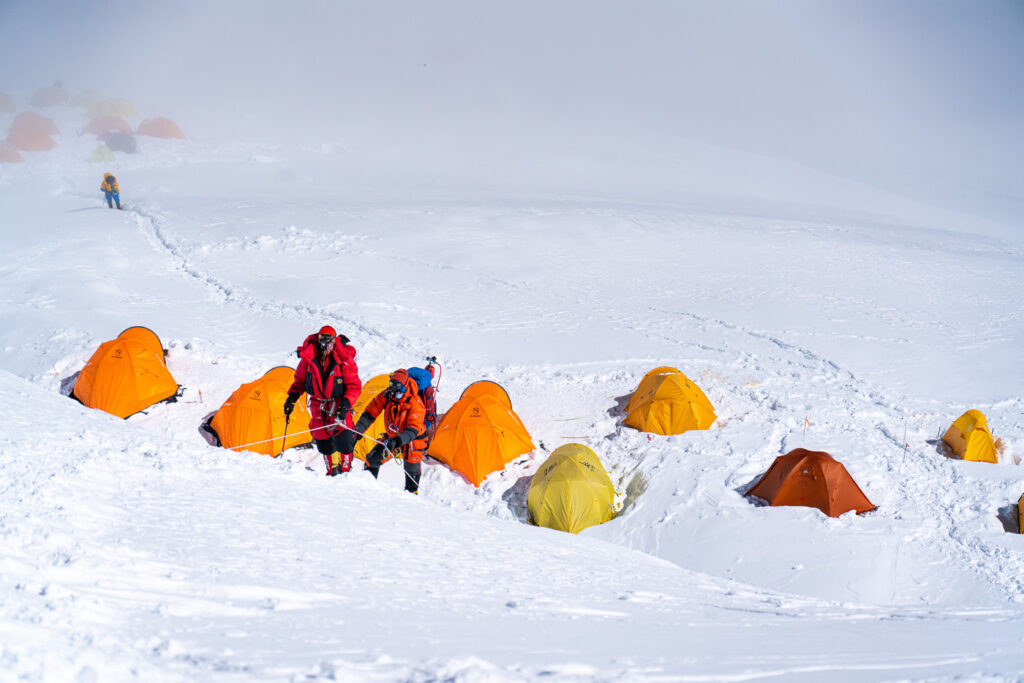
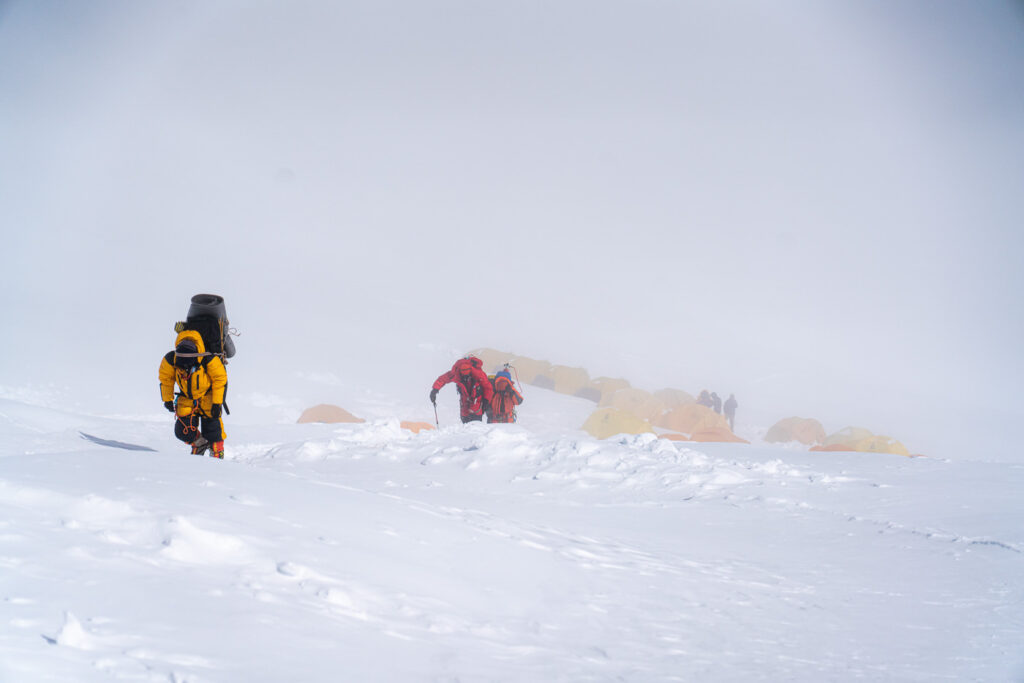
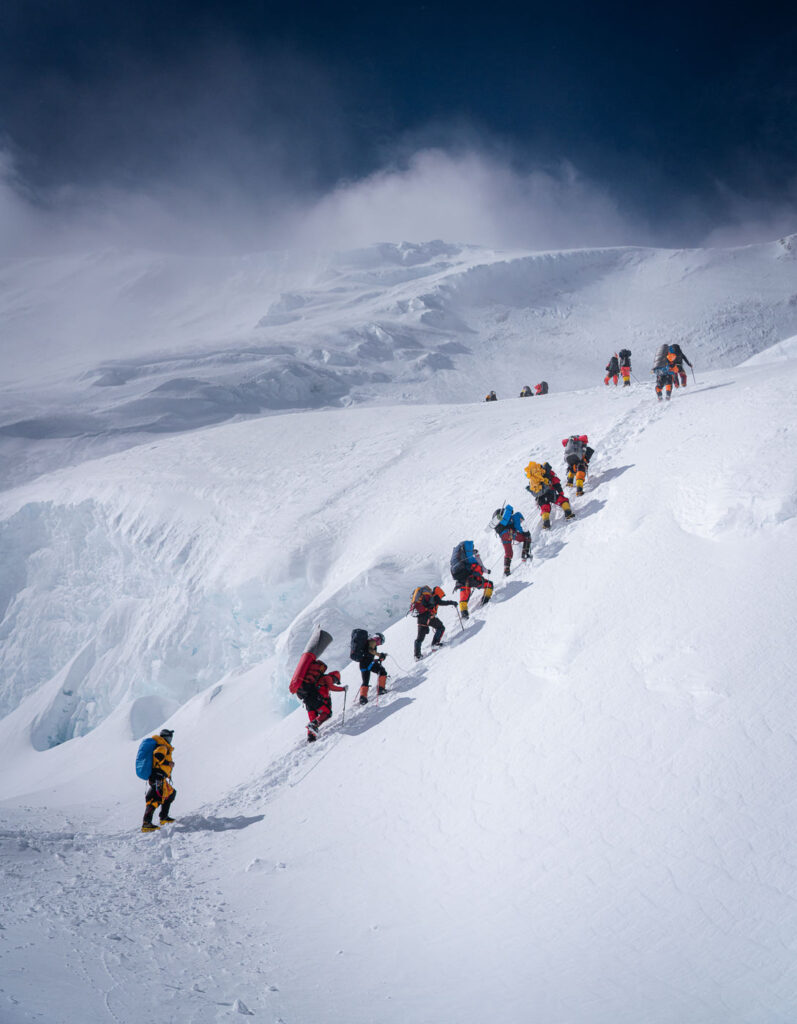
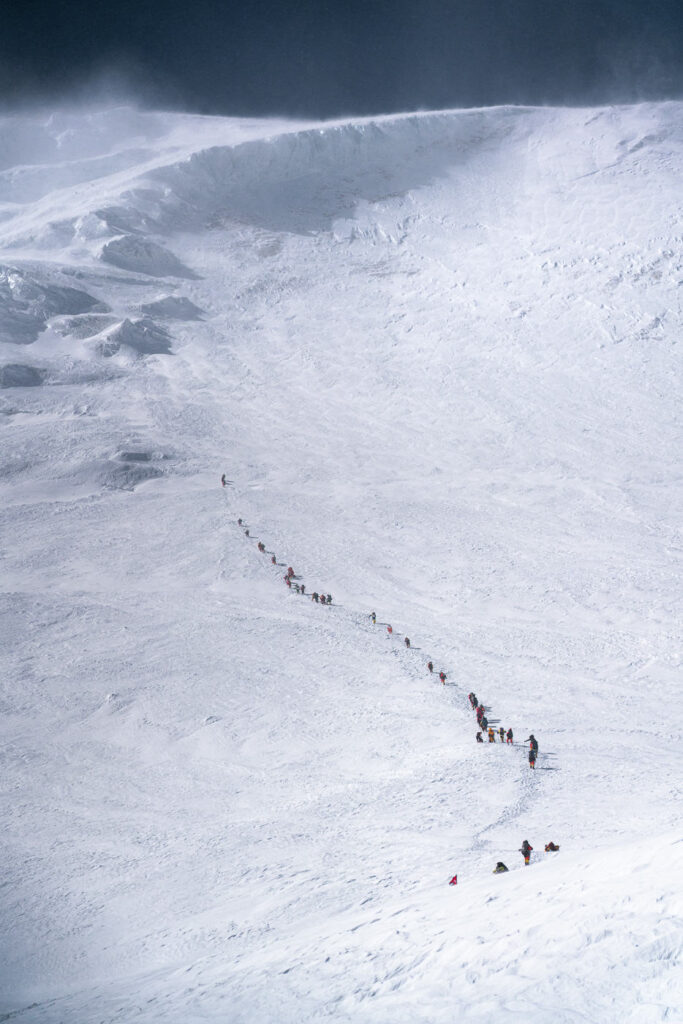
Snowy winds rocked us from the right side. Luckily, we were in our summit suits already and felt ready to handle conditions exactly like that. The climb up involved continual experimentation of open flaps, closed flaps, hood on, hood off and multiple adjustments of gear until we reached Camp 4. It seemed real now. Camp 4 sits beneath a little peak of its own and is directly at the bottom of the ridge that leads up to the summit.
Arriving in the early evening meant we had a quick window to fly the drone for an aerial perspective of the camp. We then had some noodles and made all of our gear arrangements in the tents. Sleeping three to a tent, wedged in with all of our gear while hooked up to oxygen bottles as we slept made for an interesting night of sleep. Surprisingly I managed to collect 5-6 hours of shut-eye, which was great fuel for a big summit day to follow.


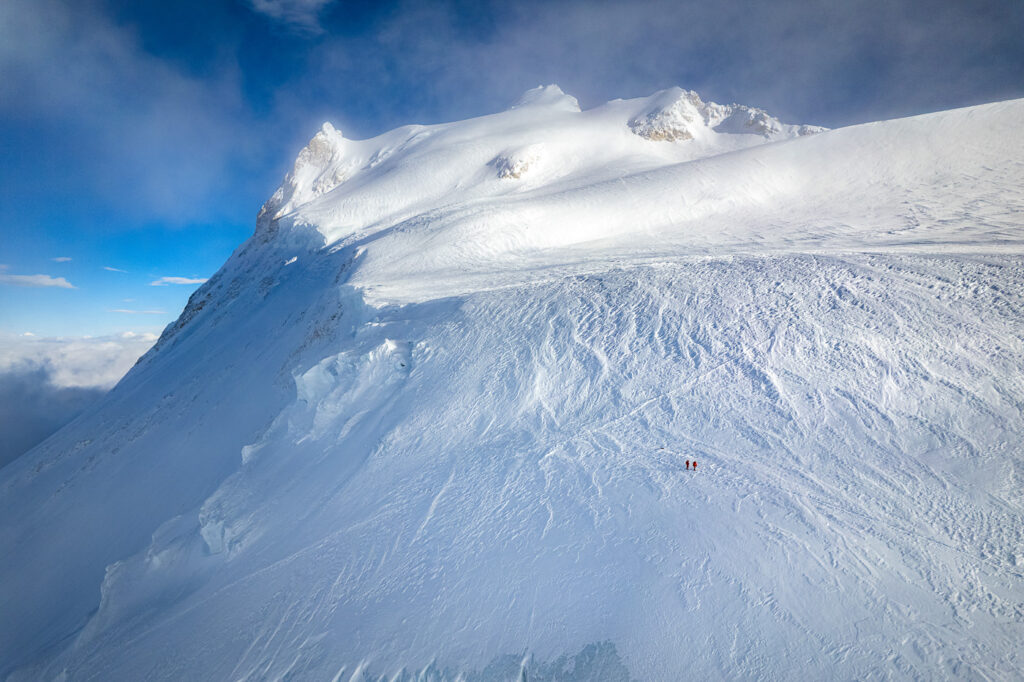
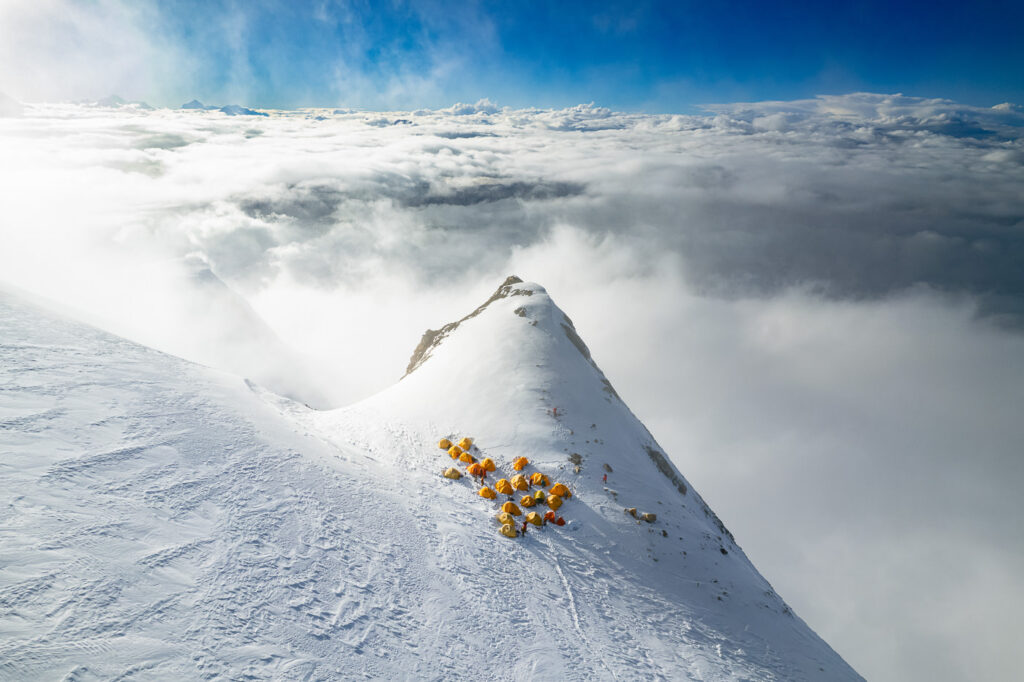
I’d been hooked into the oxygen for almost 20 hours by the time we woke up at 2 am for our summit push. Never having used oxygen before, I was surprised at just how much impact it had. While at Camp 3, I was unsure if I could make it up any further. Once plugged into the oxygen tank, I felt that only a natural disaster or a big mishap could stop me from summiting as everything felt perfect.
At 2 am we began to fumble around in our tents, grabbing gear and organizing cameras. All the while still connected via a tube to our oxygen tanks like hospital patients. It’s actually quite complicated and hard to move about when you need to shuffle the tank in conjunction with your every move.
It’s not an easy job putting on crampons, tying up boots, selecting gloves, and arranging all of my batteries and cameras in areas where they wouldn’t freeze. Normally getting ready can take a few minutes while trekking but on summit day, finishing up within an hour is an achievement. By quarter to three, we were ready to roll and began our long walk up the summit.
Our expedition was split with half on oxygen and half attempting a no-oxygen summit. Unfortunately, part of our job was to document those who weren’t on oxygen. This means we were at a dramatically slower pace than felt possible for us while we were breathing freely from our tanks as our compatriots suffered heavily. It meant that to make our photography and videography work happen, we had to suffer in the cold at a very slow pace shooting the no-oxygen climbers.
We ended up being the last group to summit that day but all is well that ends well.
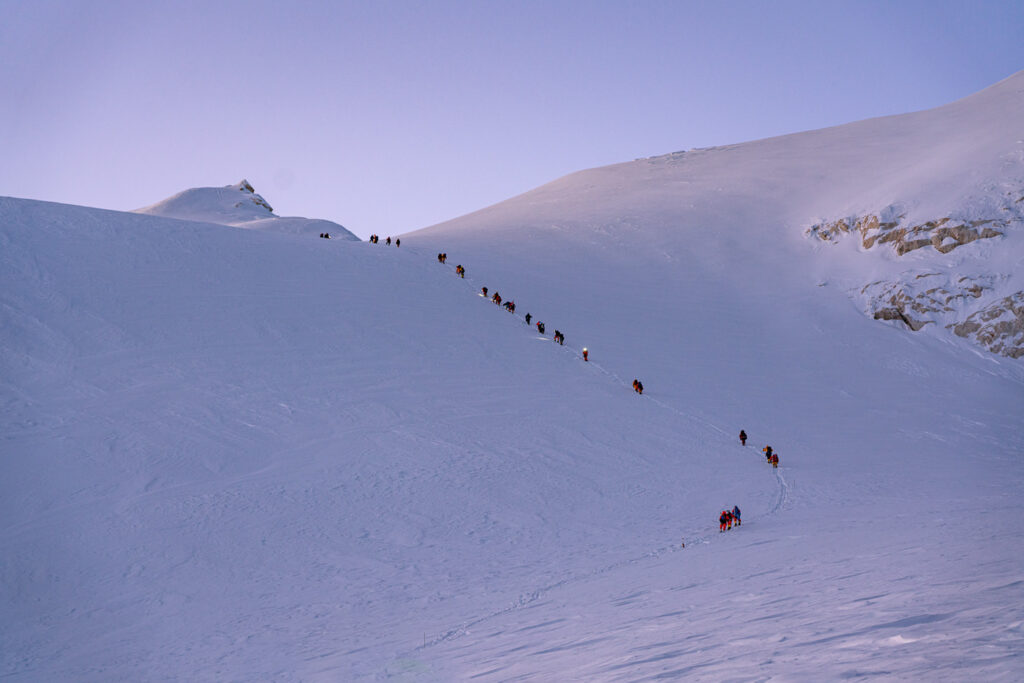
The route to the summit is not technical at all and we didn’t clip in once on the rise to the top except for the very final summit ridge. It’s a constant ascent that gives you no respite from the very steep climb. The undulation only allows you a peek at the summit after you have completed three-quarters of the climb so you must blindly push on until that point.
The sunrise was a beautiful, hazy purple, giving a soft glow to the plentiful peaks of the Himalayas. Shooting the pre-sunrise periods was my favorite of the morning and at that stage, we were still a long way off the summit.
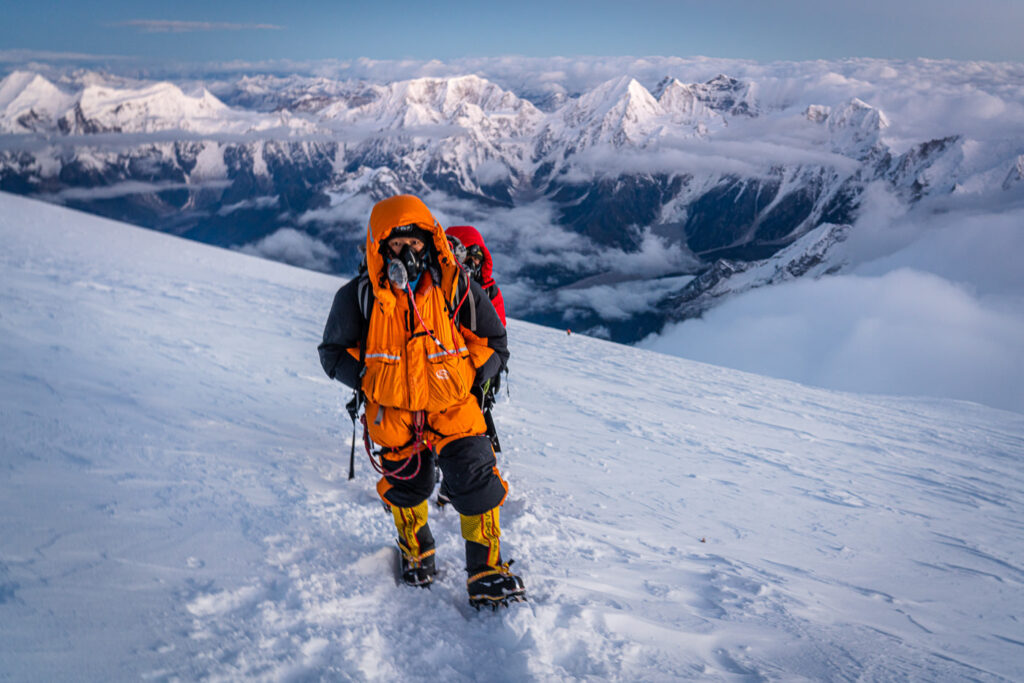
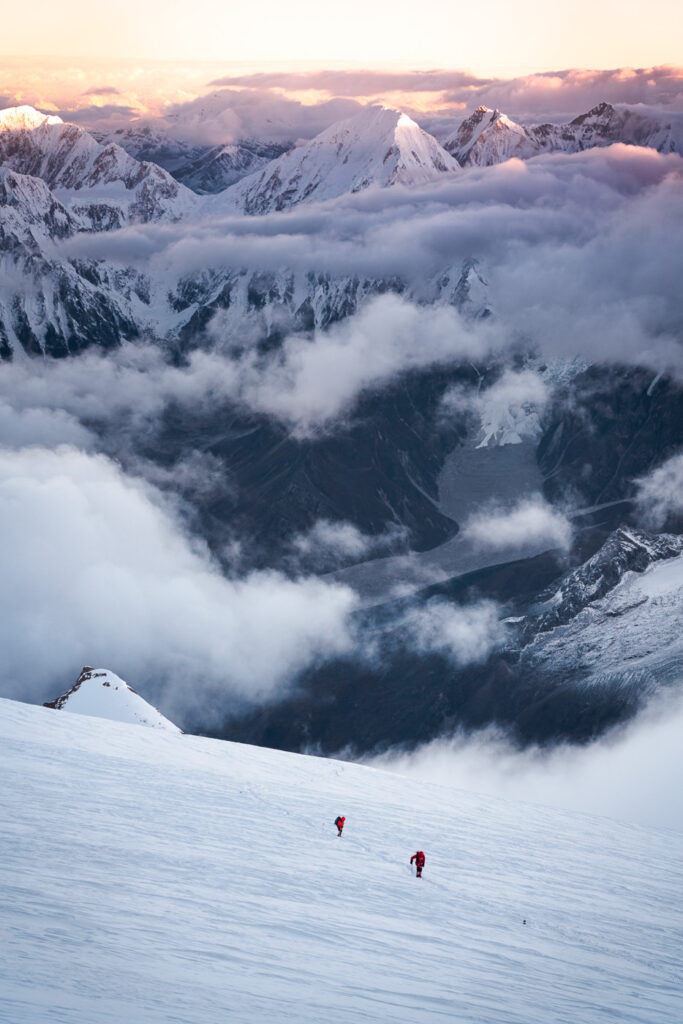
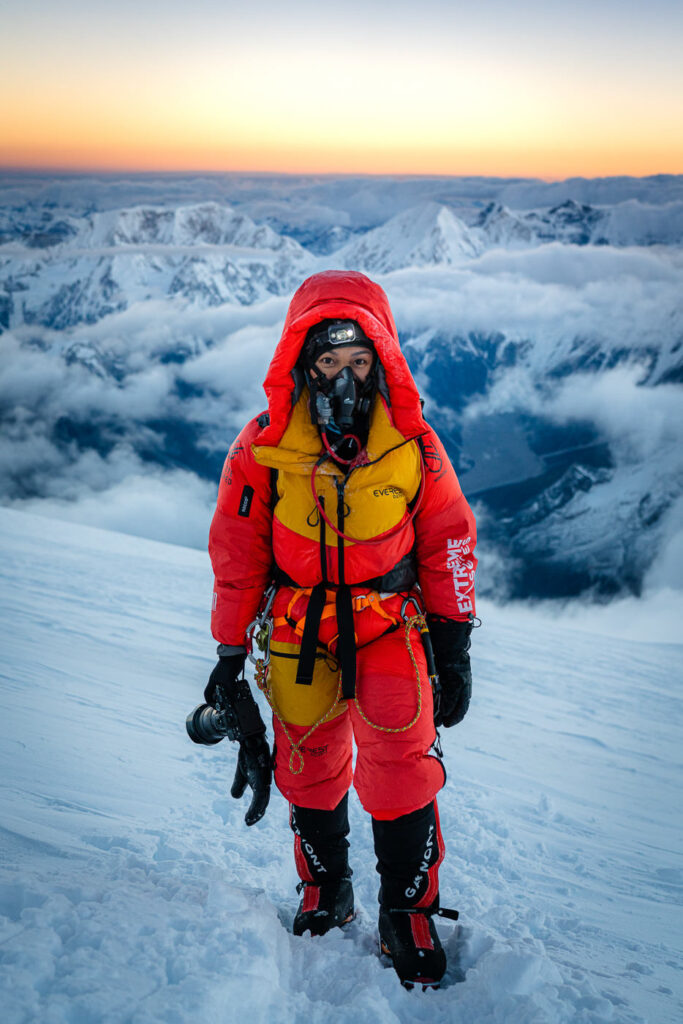
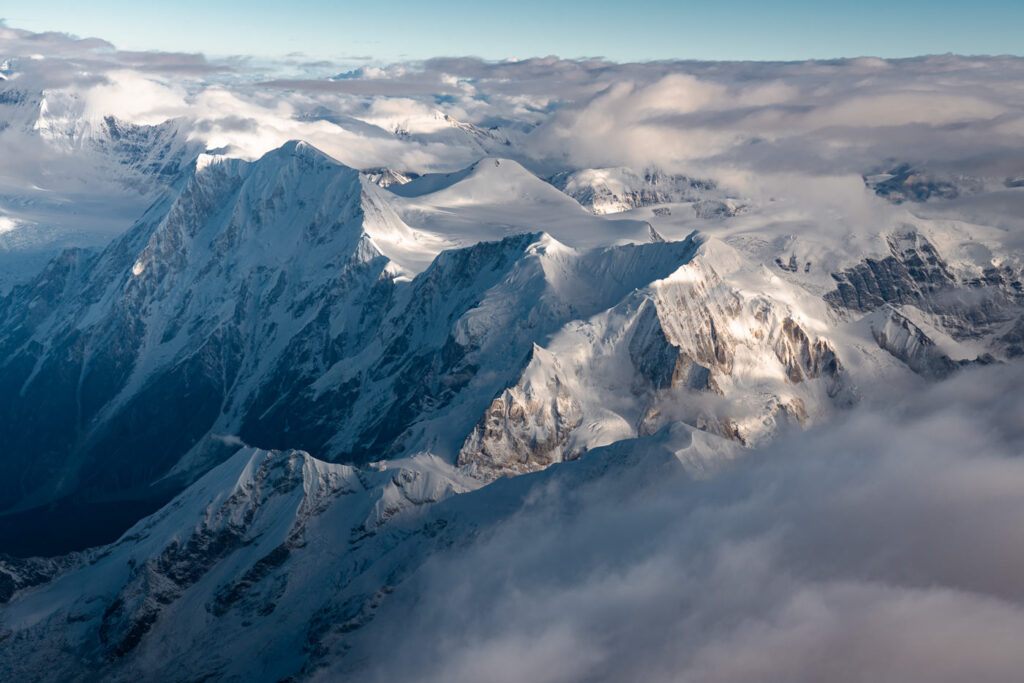
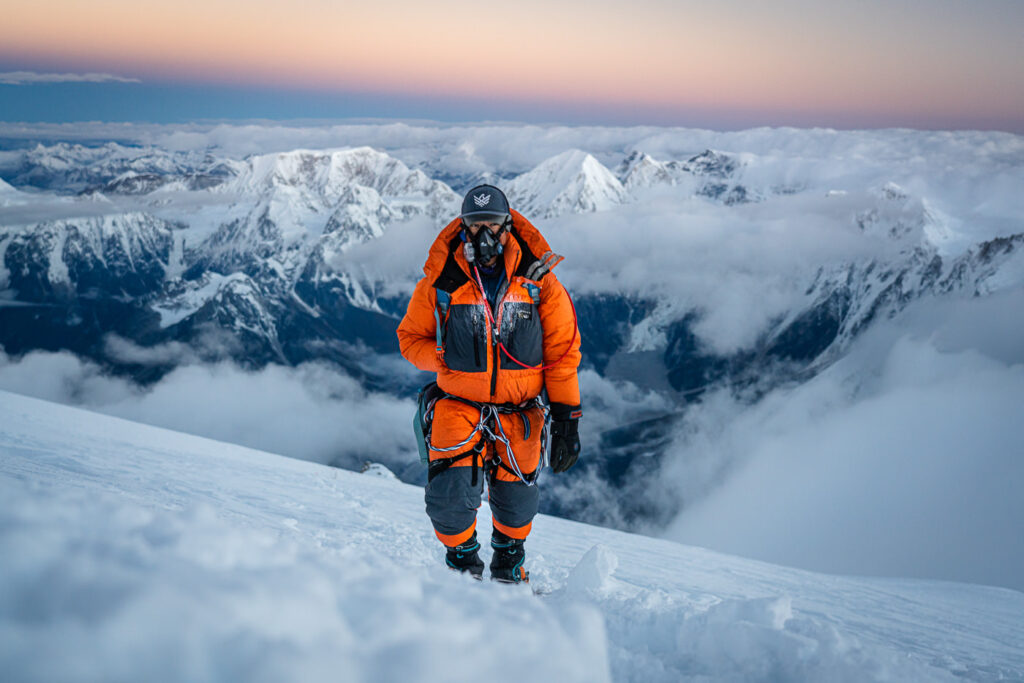
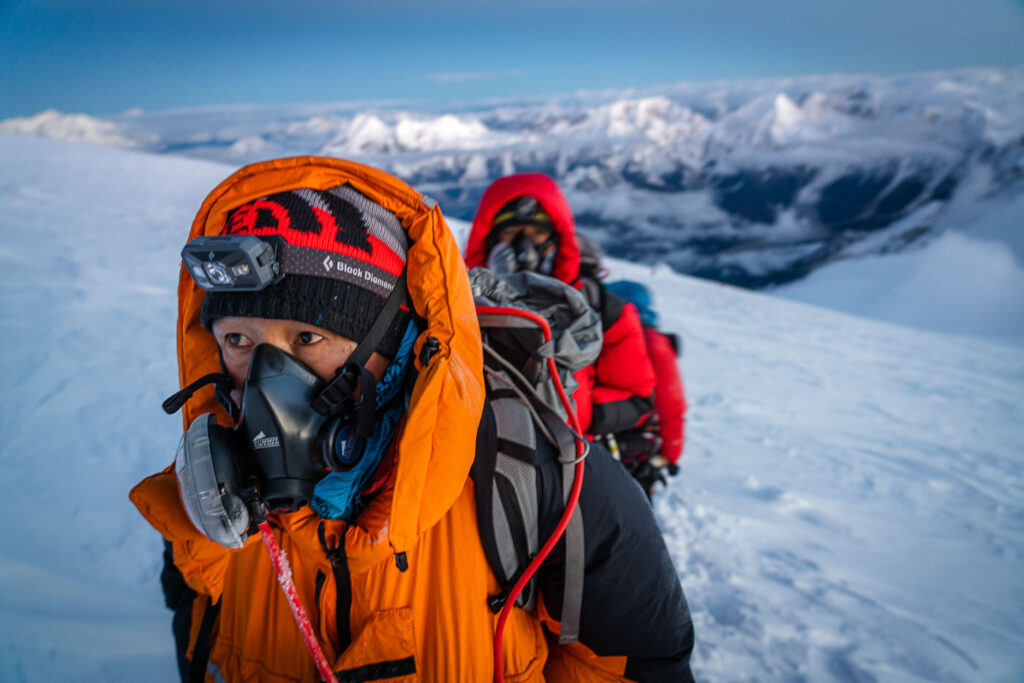
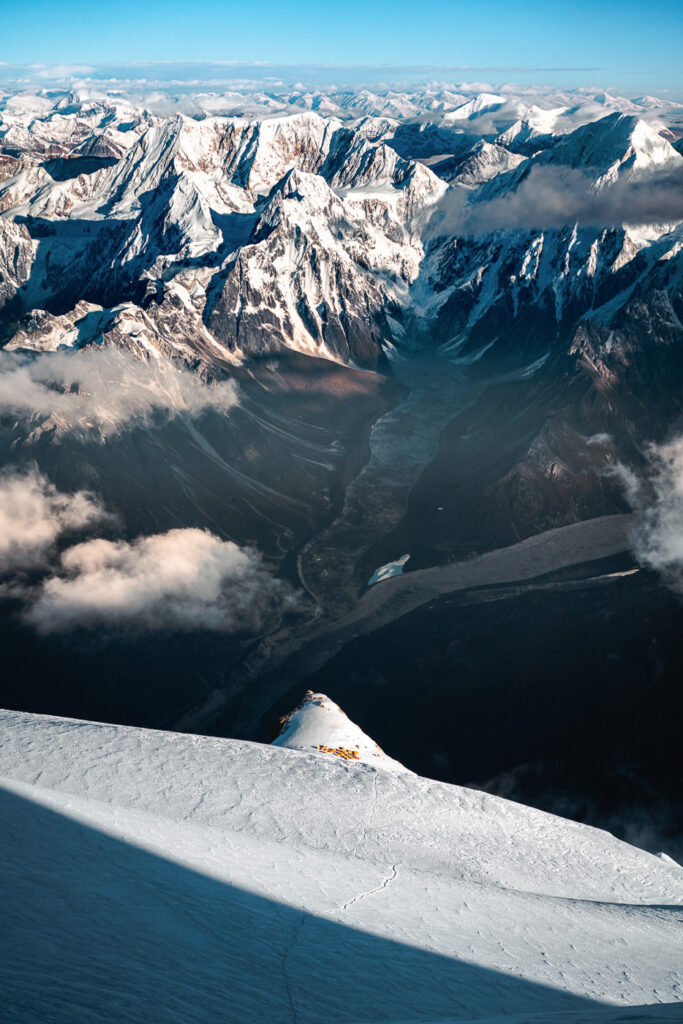
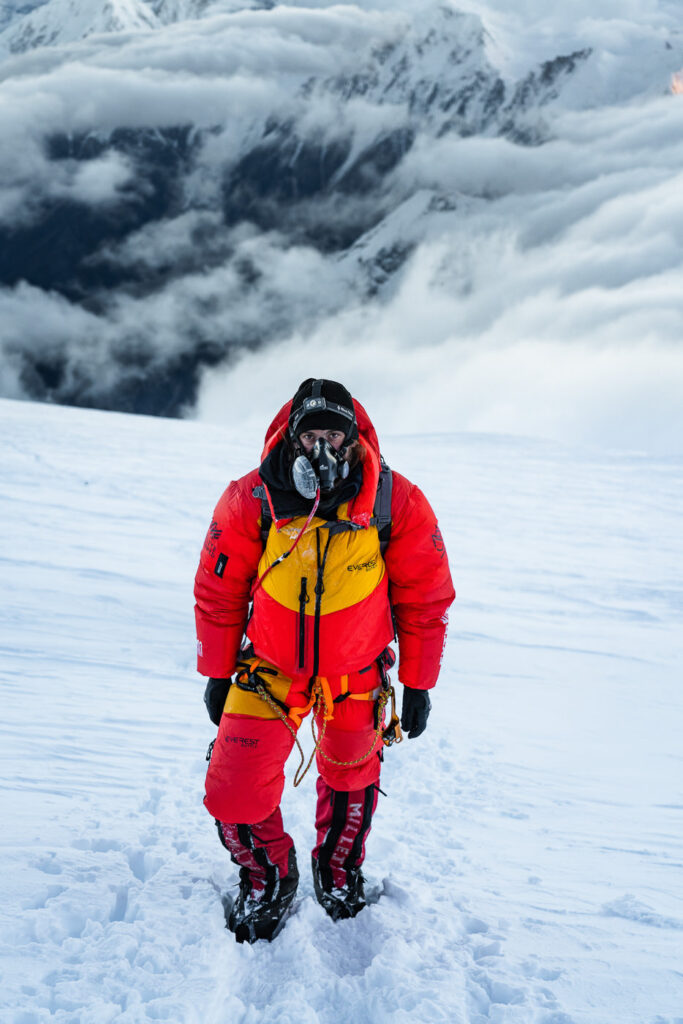
Eventually, our team leader allowed us to push on away from the no-oxygen climbers and we climbed our way up to the plateau below the summit ridge. The weather was perfect with a strong sun and no wind making it a comfortable morning. I had my gloves off at the summit ridge and was able to take it all in rather than battling to survive amidst a snowstorm. Here we waited for our group to catch up and used the time to attempt a drone flight above 8000m.
The drone didn’t take to the first two batteries, complaining they were too cold. But third time lucky the drone finally took flight and I was able to capture some unique angles of Manaslu Mountain. Many of the angles actually show distinctly the true summit of Manaslu, which has become a popular topic of debate amongst mountaineers who argue that most climbers stop before the actual summit. The actual summit appears to be five to ten meters higher than the regular summit most climbers stop at.
This year a number of climbers built a precarious line down and around the regular summit and then up to the true summit, which will surely cause even more debate amongst those who hold records and compete within the mountaineering world. For me, it was just a great drone flight and journey to the summit, whether it is true or false, higher or lower. It felt pretty damn high to me.
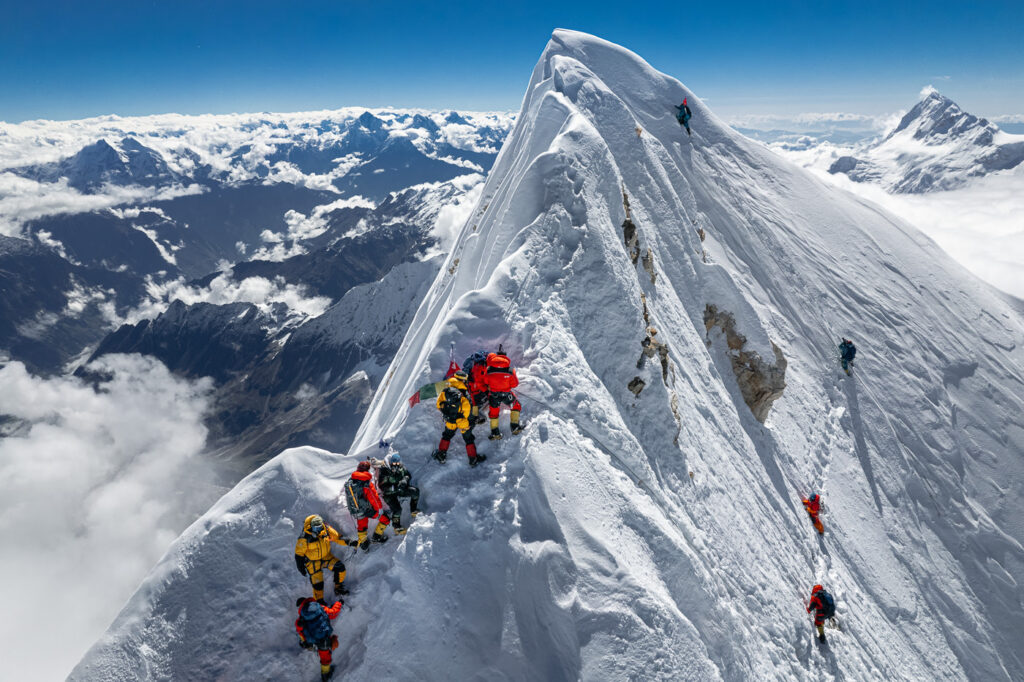
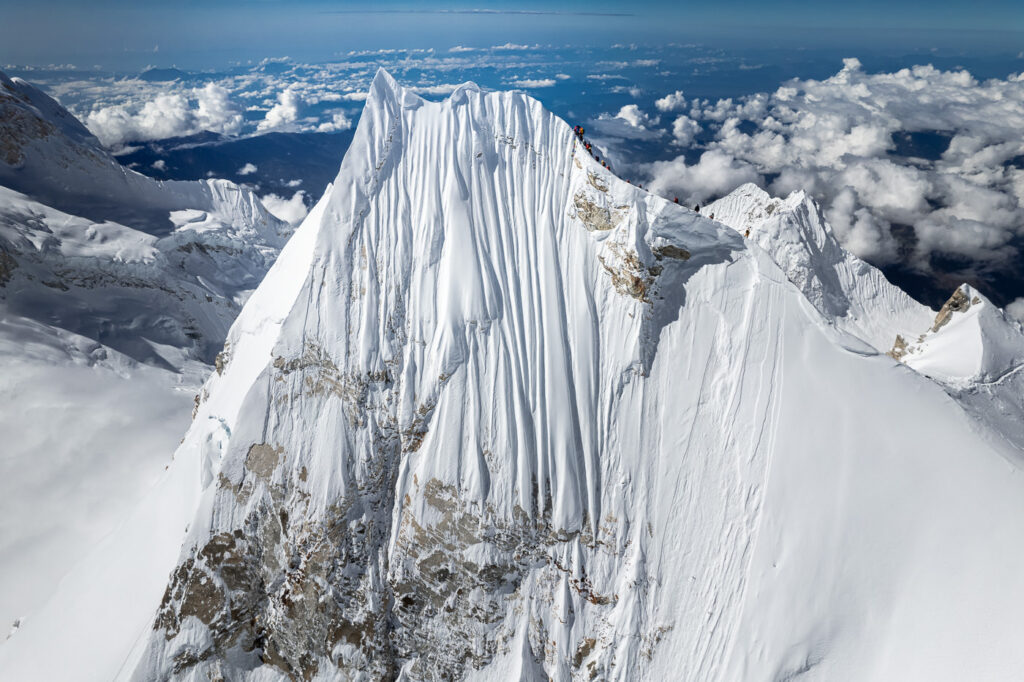

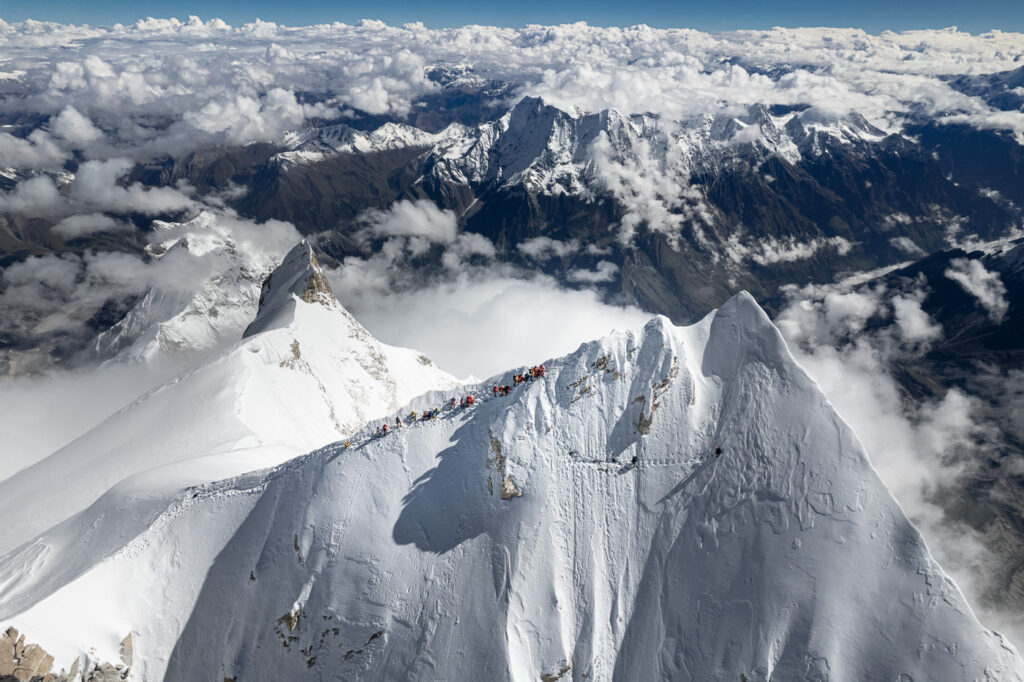
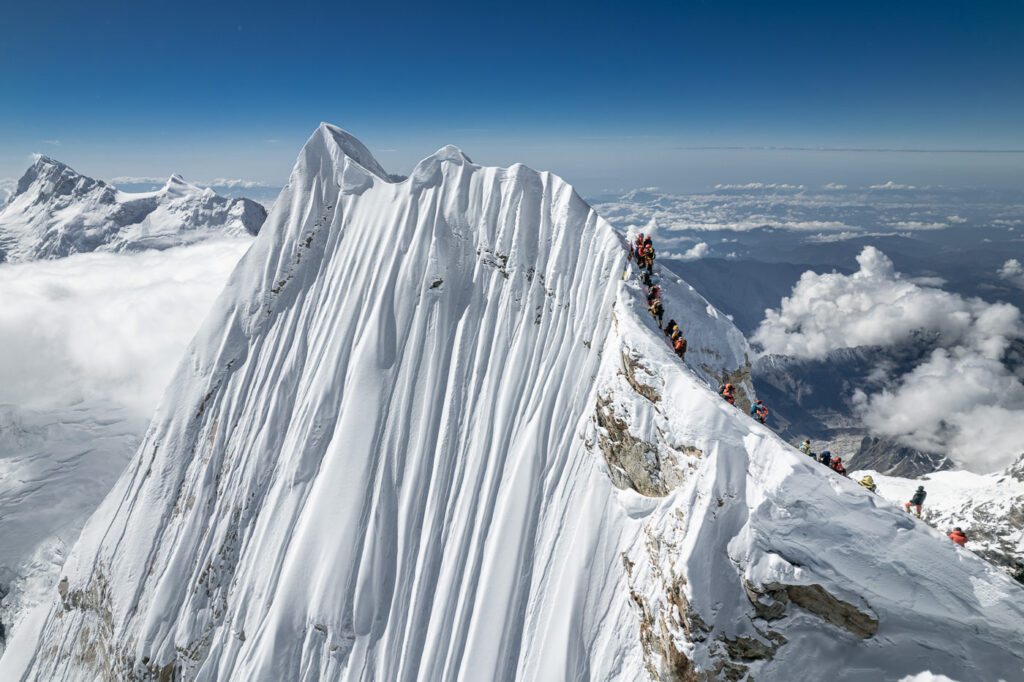
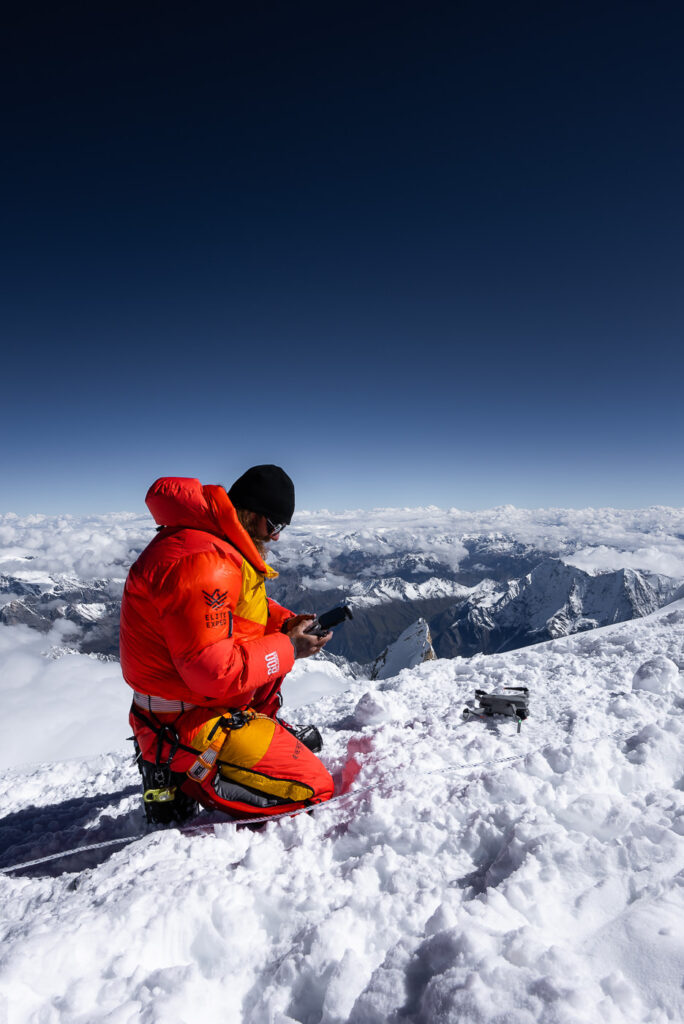
Finally, our team arrived and we headed off to the summit while they waited at the plateau. The narrow ridge to the summit is the most exciting part of the summit day and the view opened to make us feel truly on top of an 8000’er.
At the summit, there can often be a line or a bit of jam as it is a narrow little area and you never want to unclip unless you are certain of your footing to let another pass. It gets awkward but you try your best to take in the moment and the views despite the mayhem atop Manaslu.
We weren’t permitted by our team to head down the new line to the ‘true’ summit but many of our team did. We enjoyed the views from the regular summit as we sat beneath the Tibetan prayer flags blowing calmly in the breeze. We had made it!
It was now mid-morning and we were beginning to descend from the summit. The sun was my enemy at this point as I sweltered with the down suit. All flaps were open as we slid and skidded our way down the slopes back to Camp 4. There were a few parts of the descent where we clipped in but mostly, it is just a mission to stay upright in the slushy snow as you zoom back down to camp.
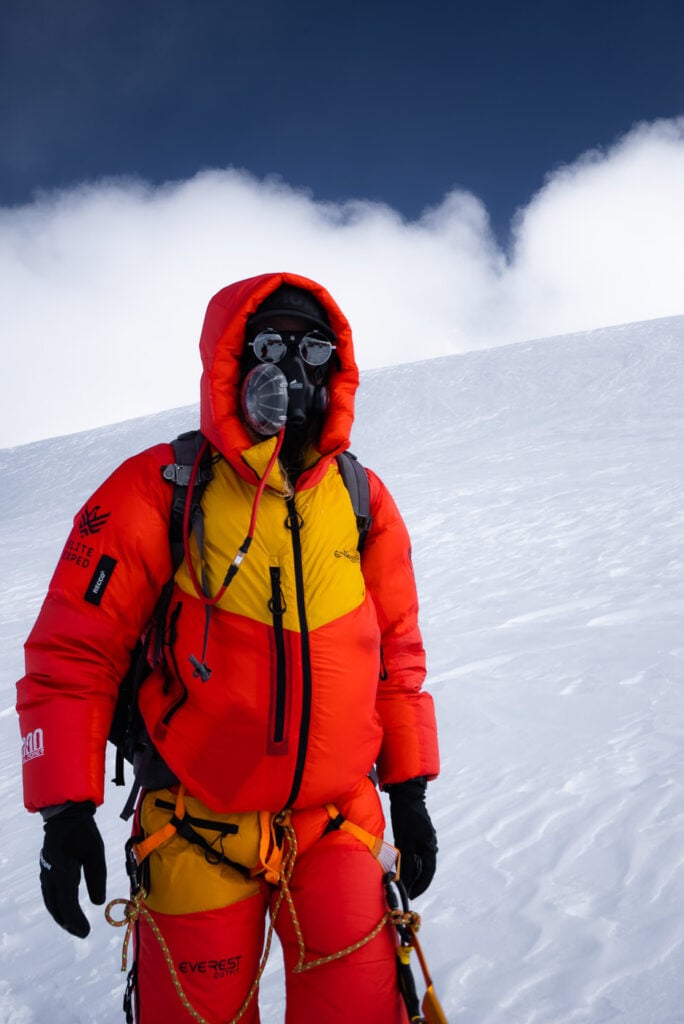
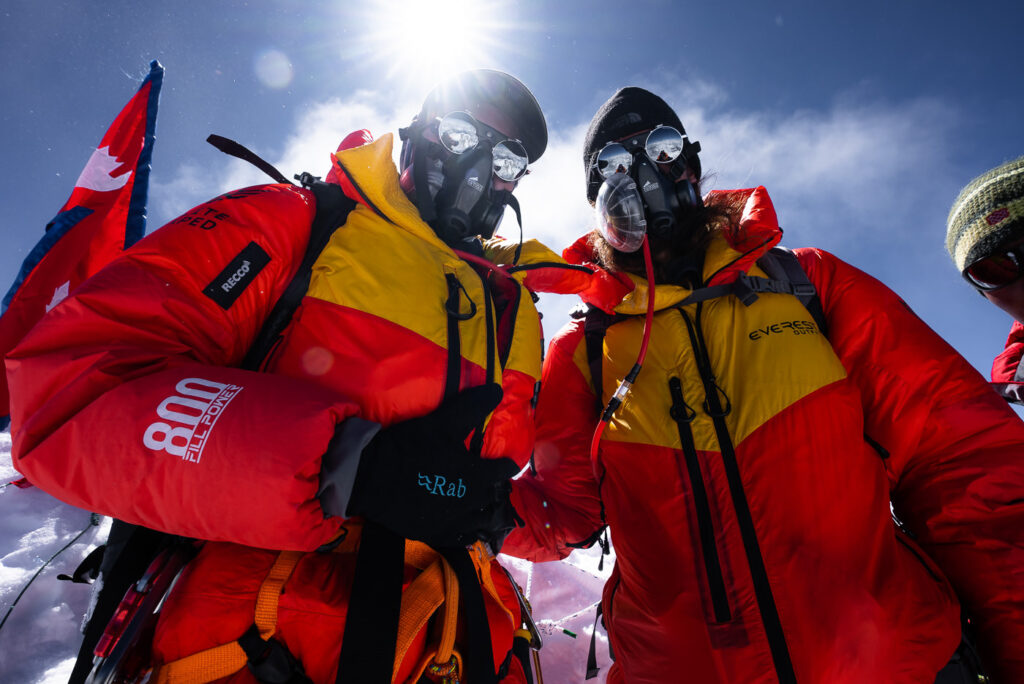
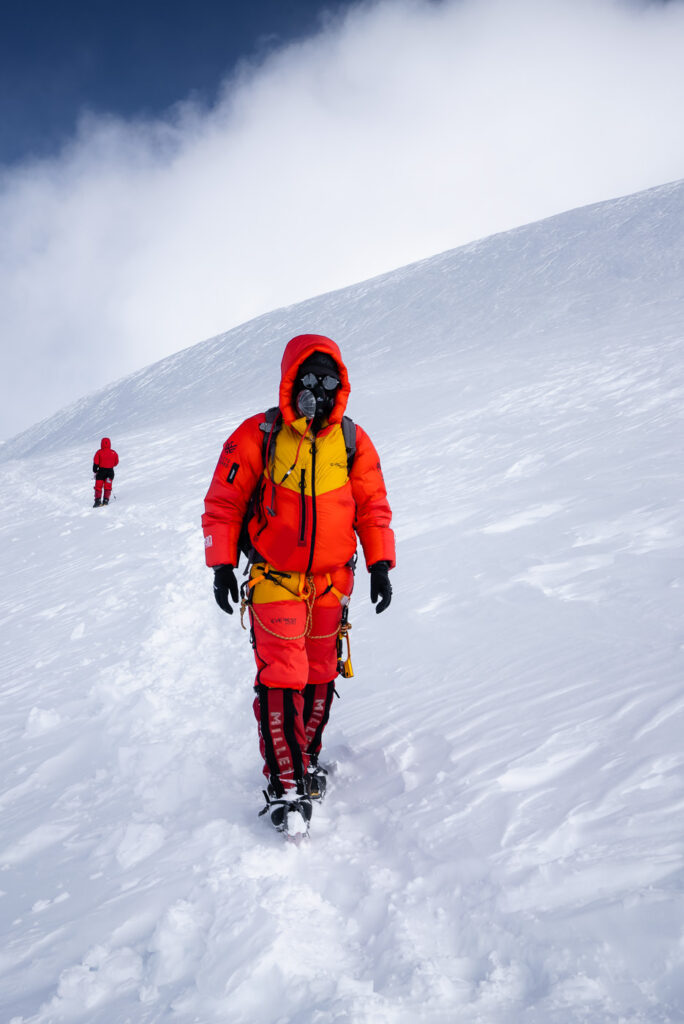
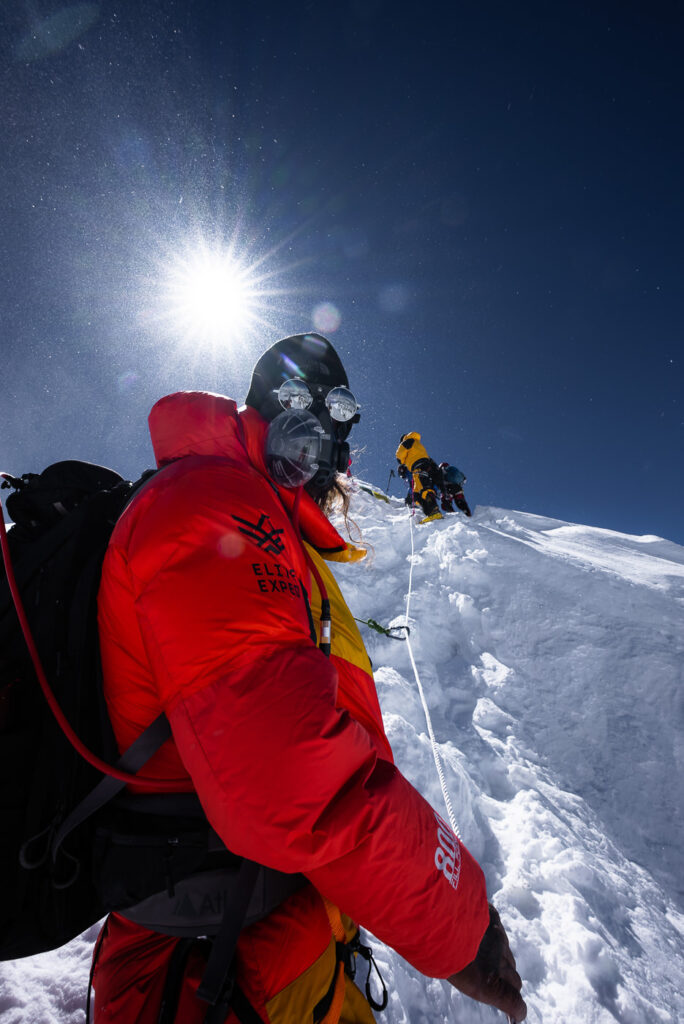
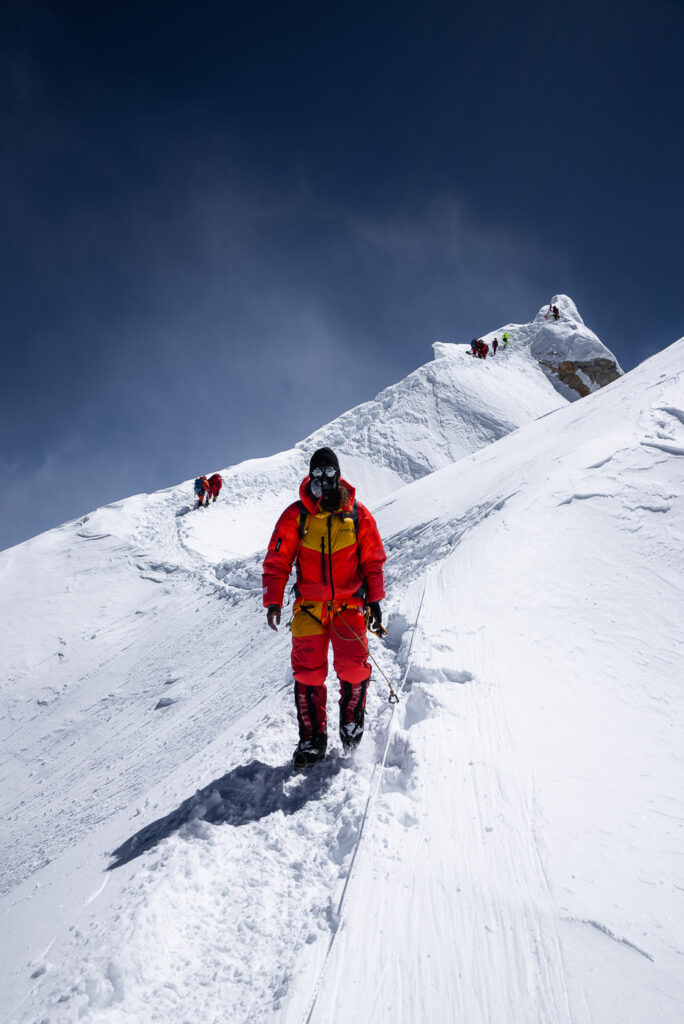
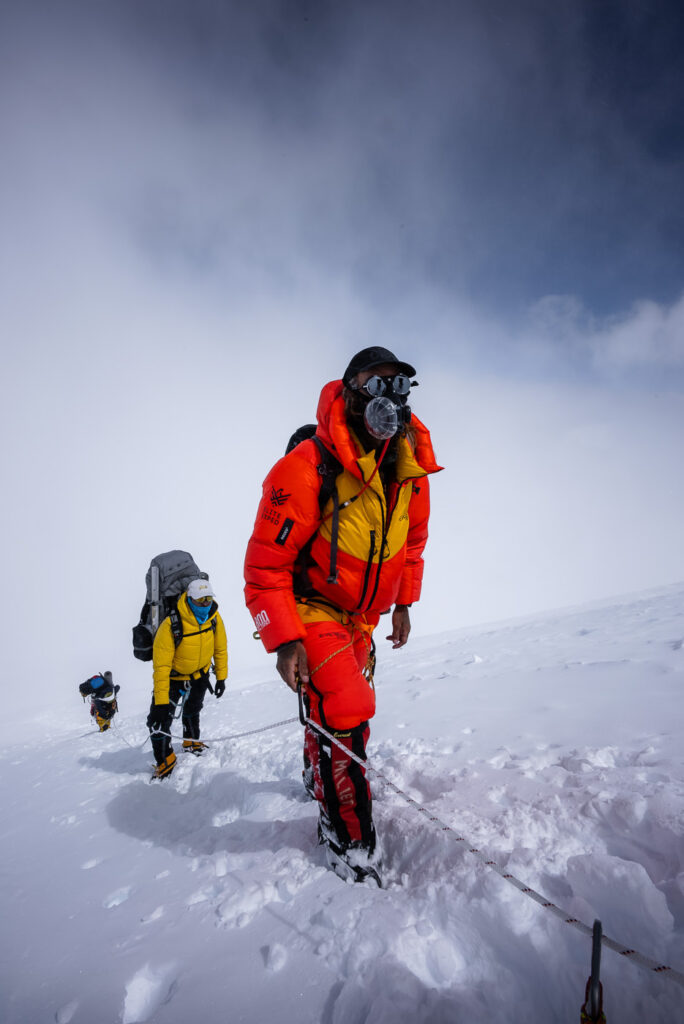
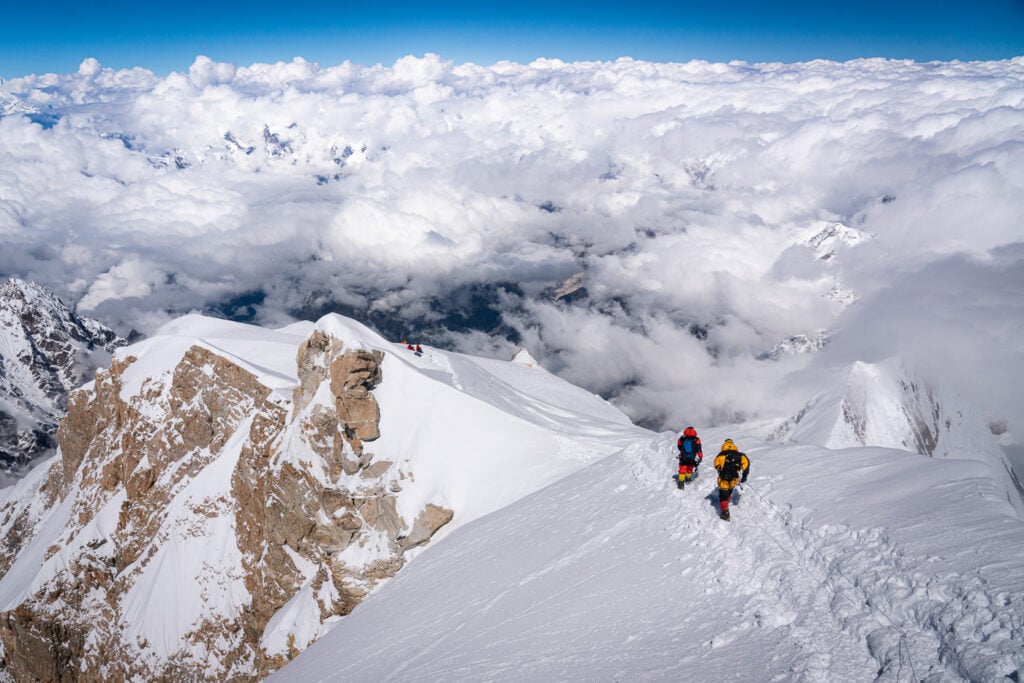
At Camp 4, we had a quick chance to pack up our gear and had a short tea break. I think our expedition team actually forgot to give us breakfast on this day, which was a little odd for such an important and high-level effort day. We had just a coffee at 2 am and then were offered a tea or coffee when we arrived back at Camp 4 at 11 am.
We then had no food or drink until we reached base camp at 7 pm that night. It had essentially been twenty-four hours without any meal.
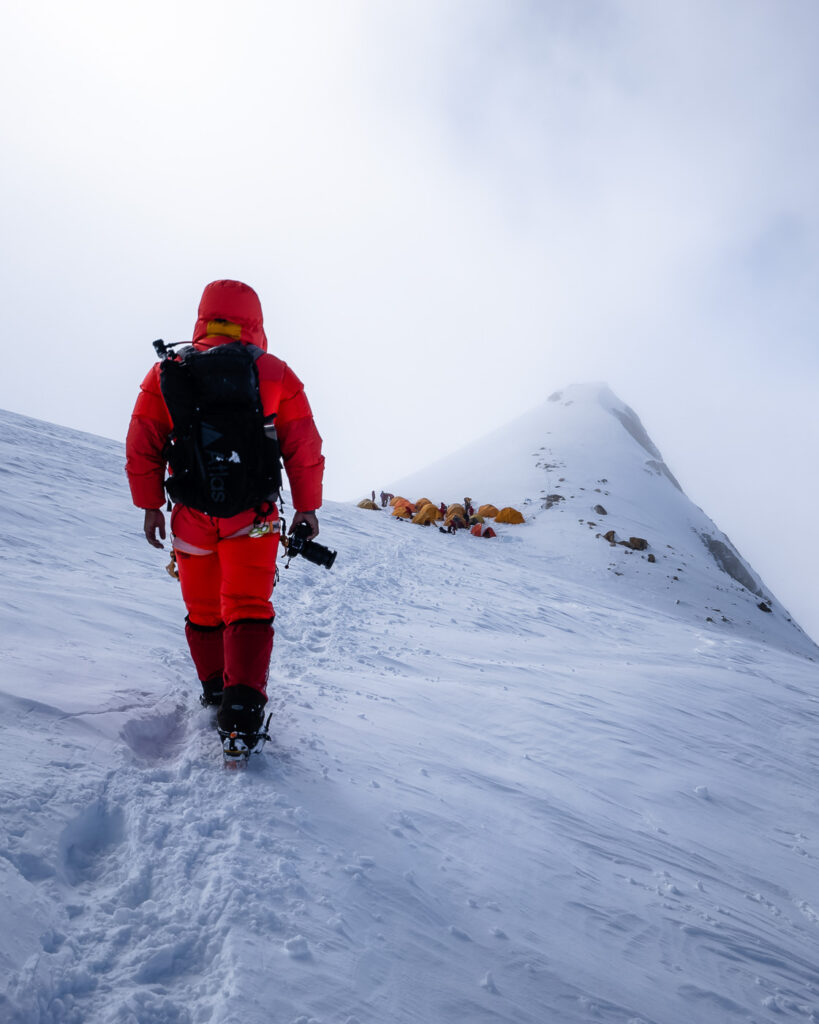
After midday, we began the long journey back down to basecamp. From the summit (8,163m) to the base camp (4,800m) the descent is about 3400m. It’s a huge day on the legs and you need to pass back through all of the technical sections you encountered on the way up. While it may seem like a long and arduous journey after the summit push, it actually passes by quite quickly as you zip down the slopes you climbed up.
Camp 3 to Camp 2, in particular, is a very quick part of the journey and took just 40-minutes. We gathered our belongings from the tents at each camp and kept on pace. Our aim was to make it back to base camp by dark so we could enjoy dinner and finally rest our legs and have a good sleep.
Many climbers who encounter trouble or run out of energy will sleep at Camp 3, Camp 2, or Camp 1 if they simply can’t make it back down in one day. There is no right or wrong, but it is sure good to make it back down to base camp by the night.
Just before dark, we made it back to ‘Crampon Point’. This is the spot where you take on or off your crampons depending on which direction you are heading. It was a great moment for us as one of the kitchen staff, Santos, had been waiting for us with Coca-Cola and beer to perk us up for the final 40-minute, rocky path back to base camp. It was just the motivation we needed and we were thankful to see his bright spirit waiting for us there as we removed our crampons for the final time on the expedition.
As dinner was being served, we arrived back at base camp in a tired state but happy to have accomplished our goal and to have been blessed with a safe passage through the mountains. Simply enjoying a beer and getting my feet out of the climbing boots were a due reward for a long day of climbing up and down Manaslu Mountain. Mission complete.
Most of our team flew out by helicopter but we actually hiked out through the Larke Pass, which took us five days including a day trip to the Tibet-Nepal border. I had previously trekked across the Larke Pass earlier in the year as part of the Manaslu Circuit, but the weather during that period meant everything was completely snowed over. This time, we came across grassy fields and strikingly blue lakes. Trekking out was a great adventure for us to finish off our Manaslu Expedition in true explorer style!
I hope you enjoyed the photos and this blog post. It’s not always easy shooting on the mountain but I’m proud of our work on Manaslu, our first 8000m peak. Thanks for reading and wishing you all safe climbing and trekking!
Thanks for the photo contributions from Pema Chinyam and Pemba Sharwa
HAVE YOU READ MY OTHER NEPAL BLOGS?
I’ve been lucky enough to have many awesome adventures in Nepal, which you can check out below where I’ve listed some of my favorite blog poss from Nepal.
- The Most Iconic route: Everest Base Camp Trek
- The Most Scenic Route: Annapurna Circuit Trek
- My Favorite Trek in Nepal: Manaslu Circuit Trek
- An Easy Nepal Trek: Langtang Valley Trek
- A great beginner peak: Island Peak Climb (6,165m)
- My Favorite Climb in Nepal: Climbing Ama Dablam (6,812m)
- My first 8000er: Climbing Manaslu (8,163m)
- My toughest climb in Nepal: Climbing Makalu (8,463m)
- Where to stay: 16 Best Places to Stay in Kathmandu


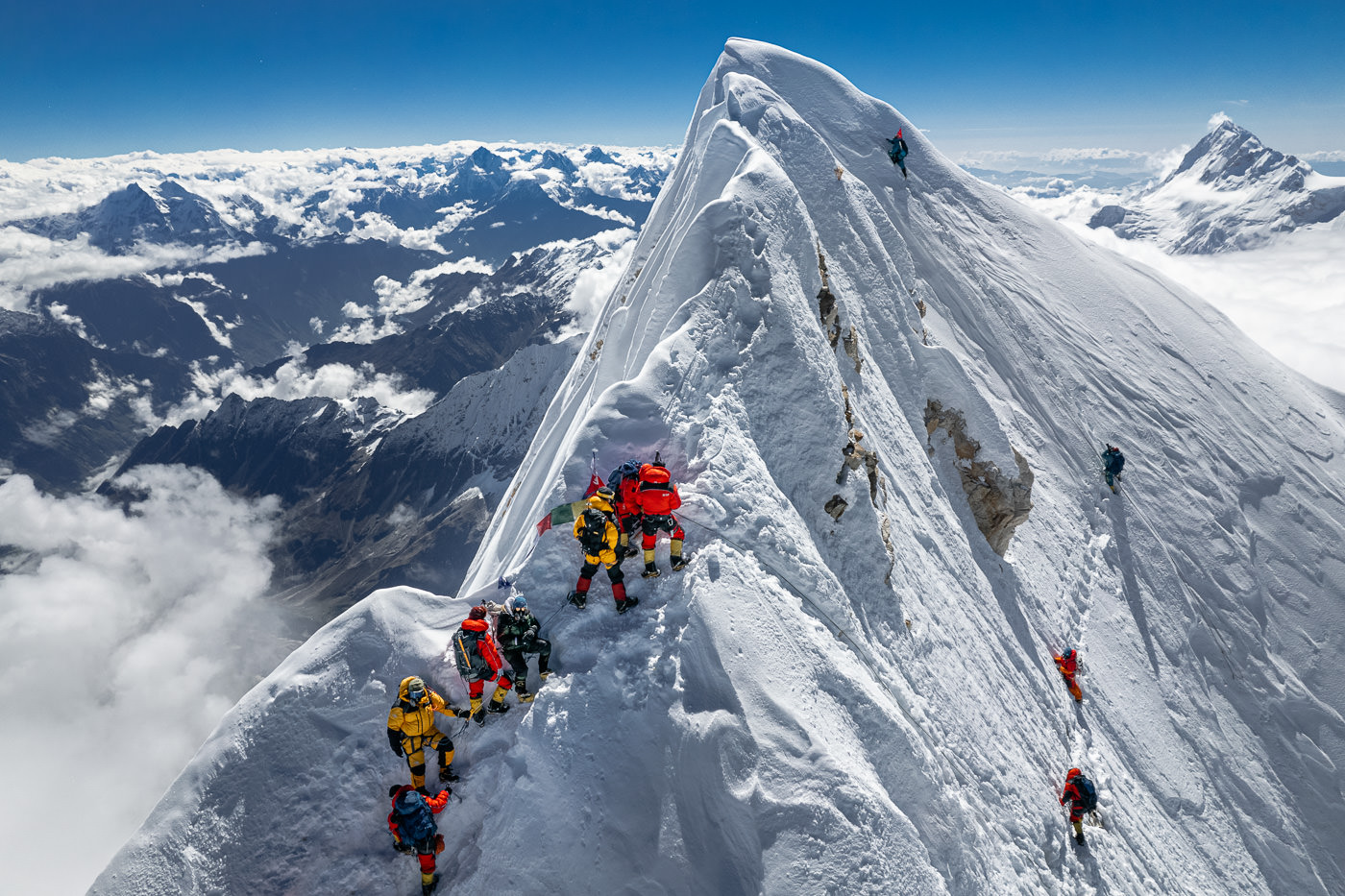

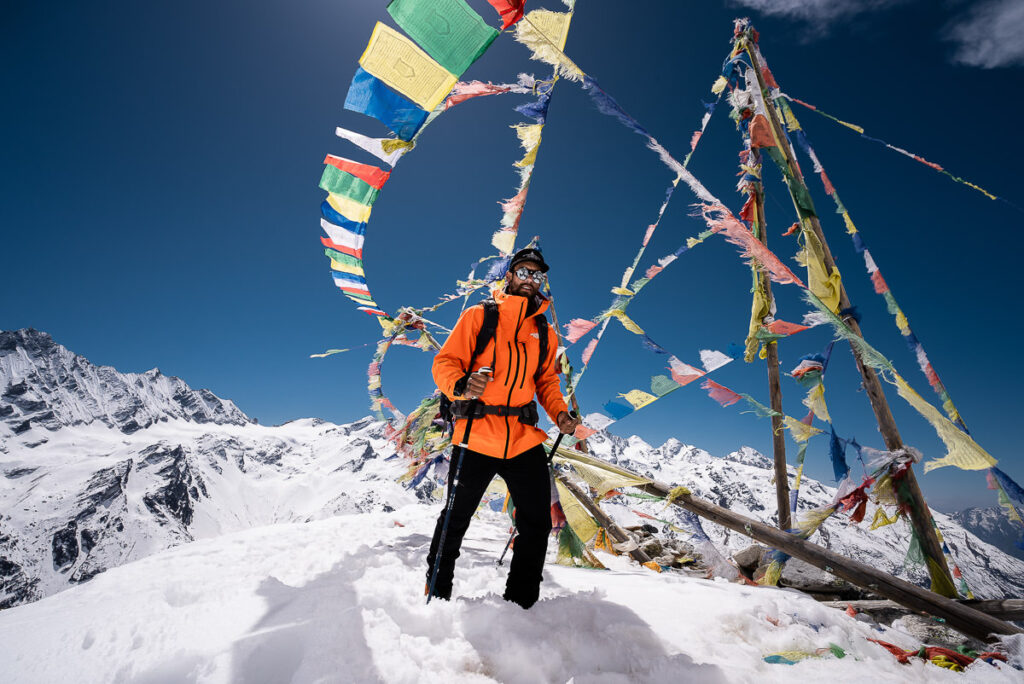
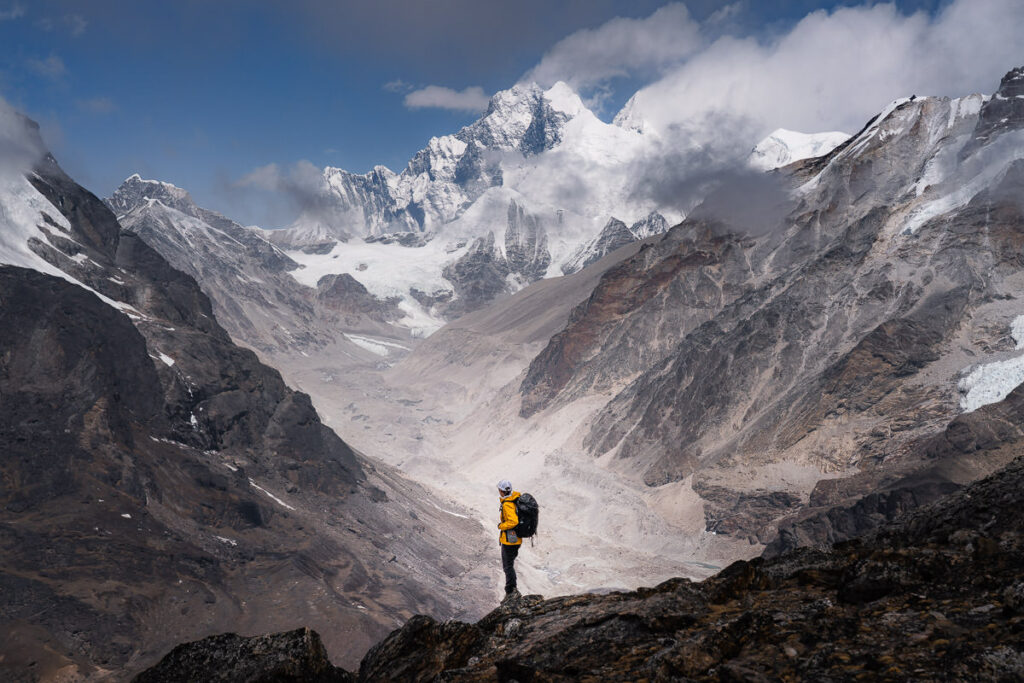
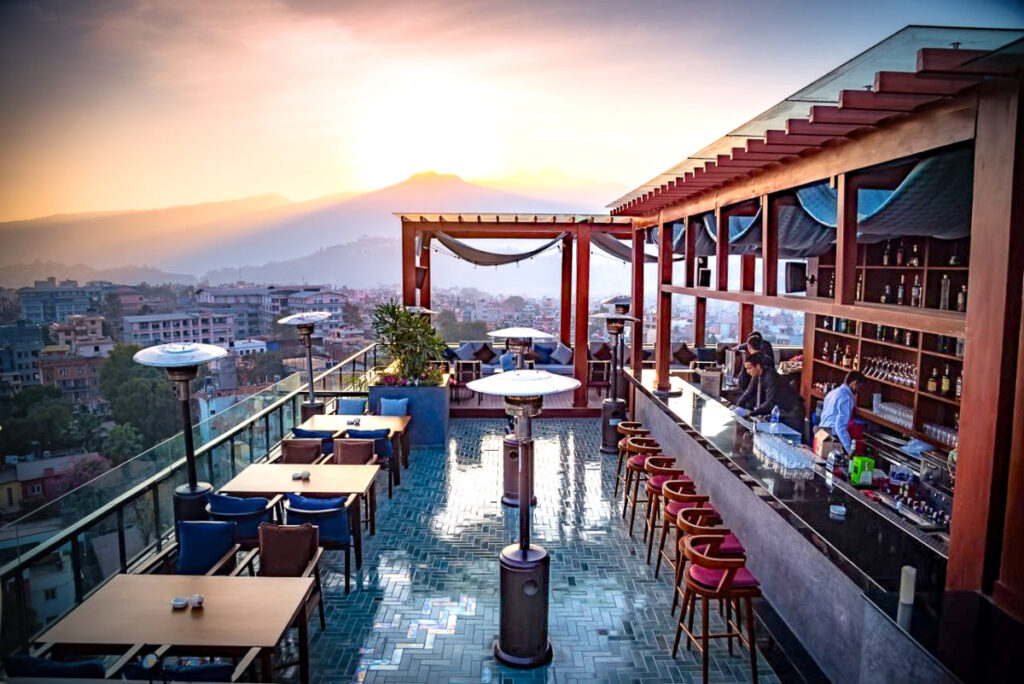
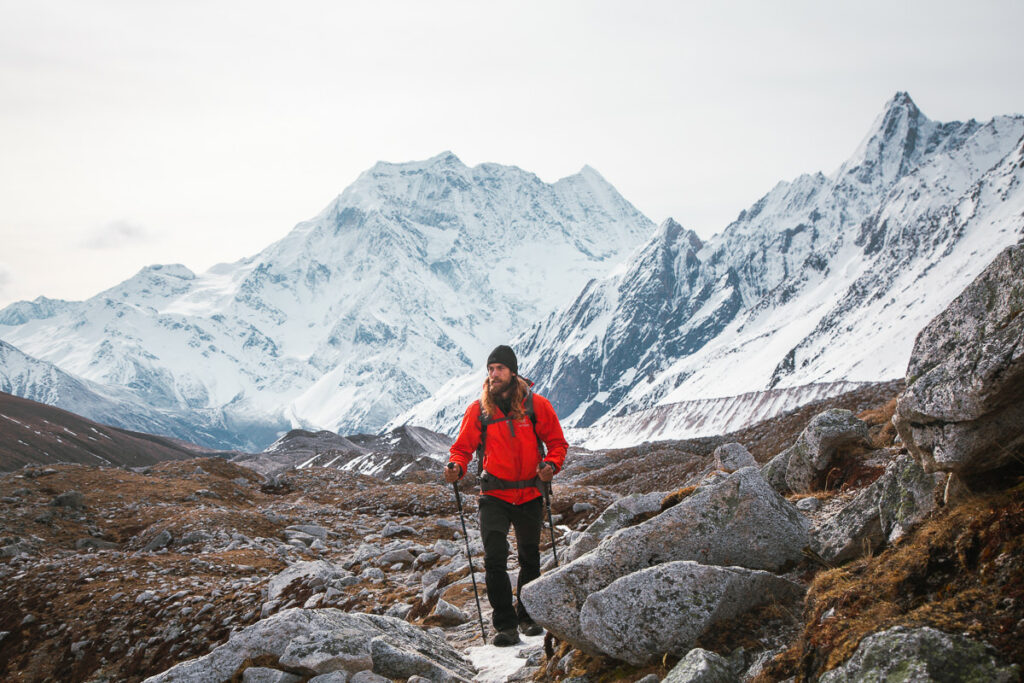
Jigita
Thursday 25th of April 2024
With which trekking company you did Mt Manaslu ??
Winston
Sunday 1st of October 2023
Hey, cool post. Were you satisfied with Elite Exped? You mentioned they wouldn't allow you to go to the true summit. I am interested in climbing an 8000er in the near future, so I'm just trying to gather info on which company I should go with. Would you recommend?
Gary Lewis
Tuesday 1st of March 2022
I appreciate your detailed yet lively writing. Inspired realism.
And also, thanks for spending so much time and care on producing the many photos. I can feel a bit what it's like to be there (you evoked memories of some of my lower-elevation but still vivid experiences of Sierra Nevada winter climbing).
I plan to finally head to the Himalaya.
Lunibha Twayana
Saturday 11th of December 2021
😍🙏
Friday 15th of October 2021
Gracias por compartir tu experiencia jackson, por las fotos y por el video del dron tan impresionante. Seguiré tus redes y seré un seguidor tuyo